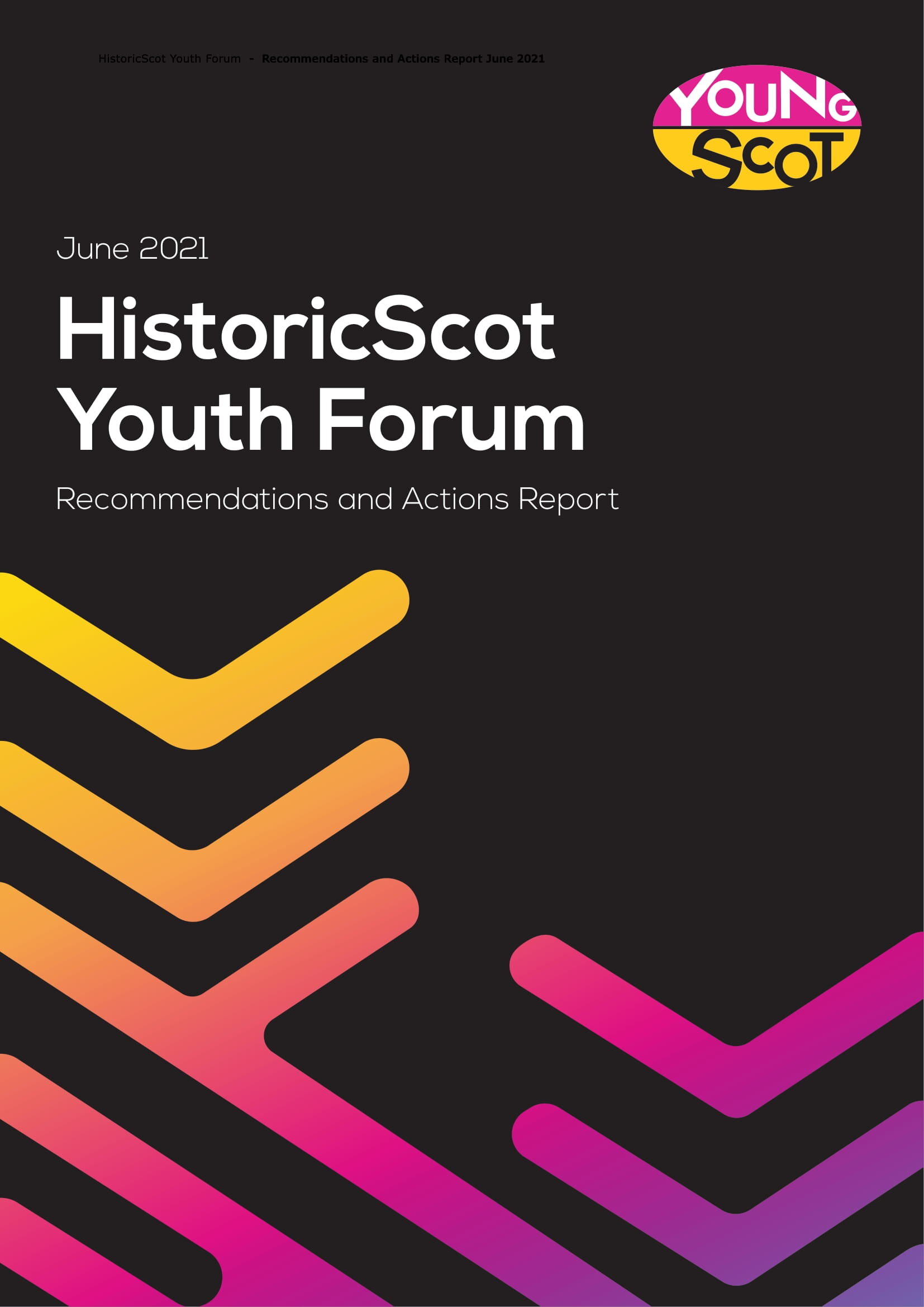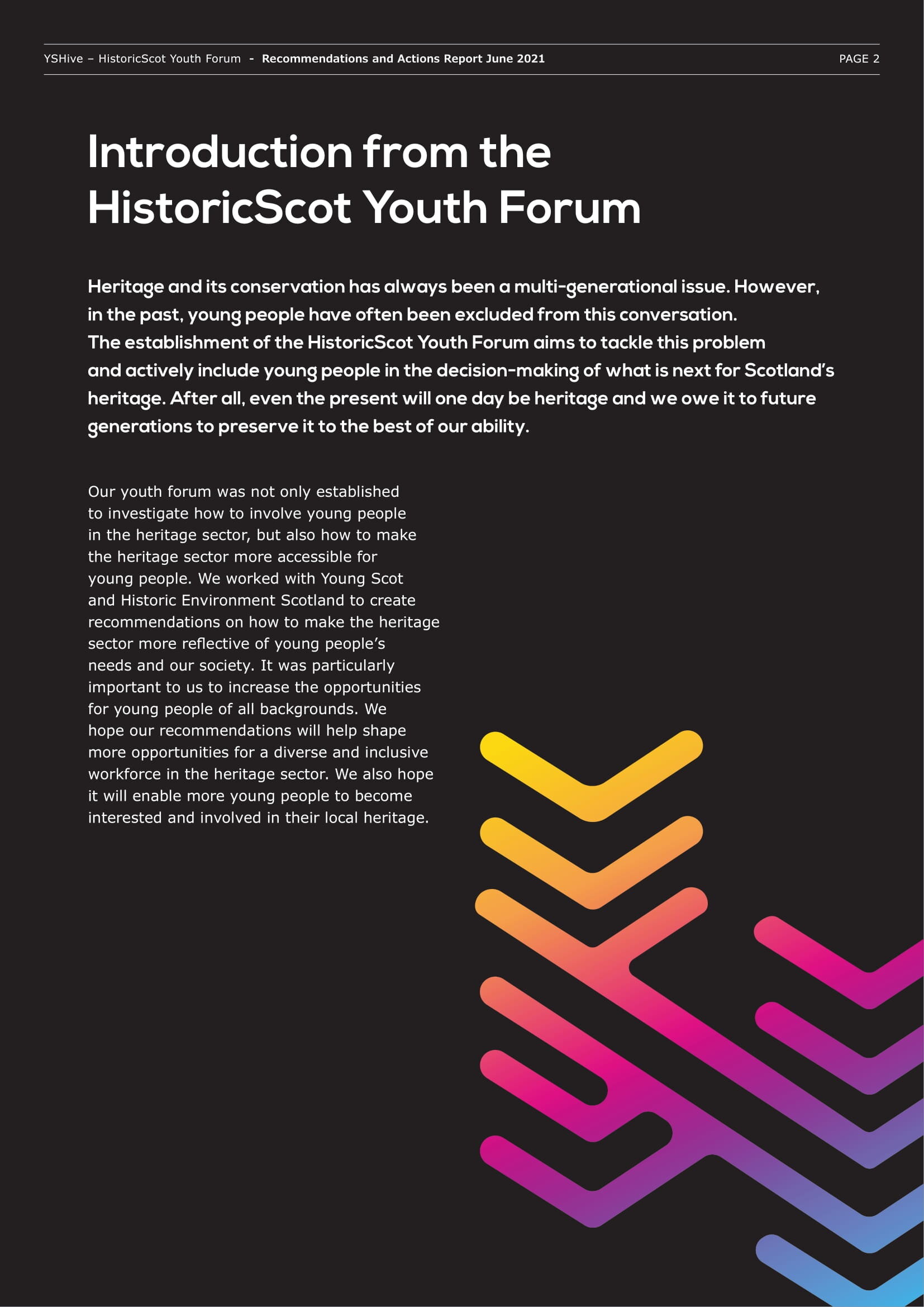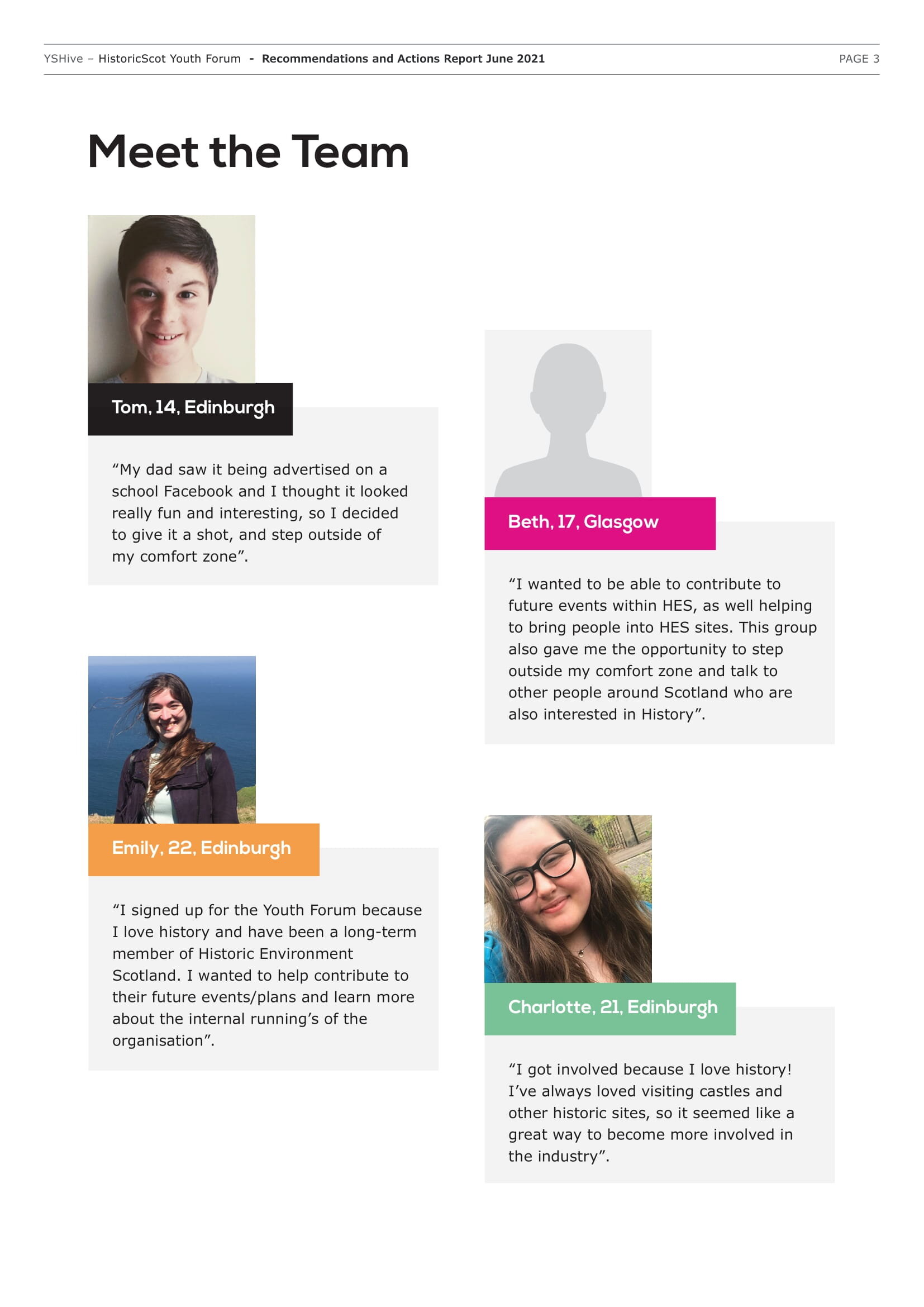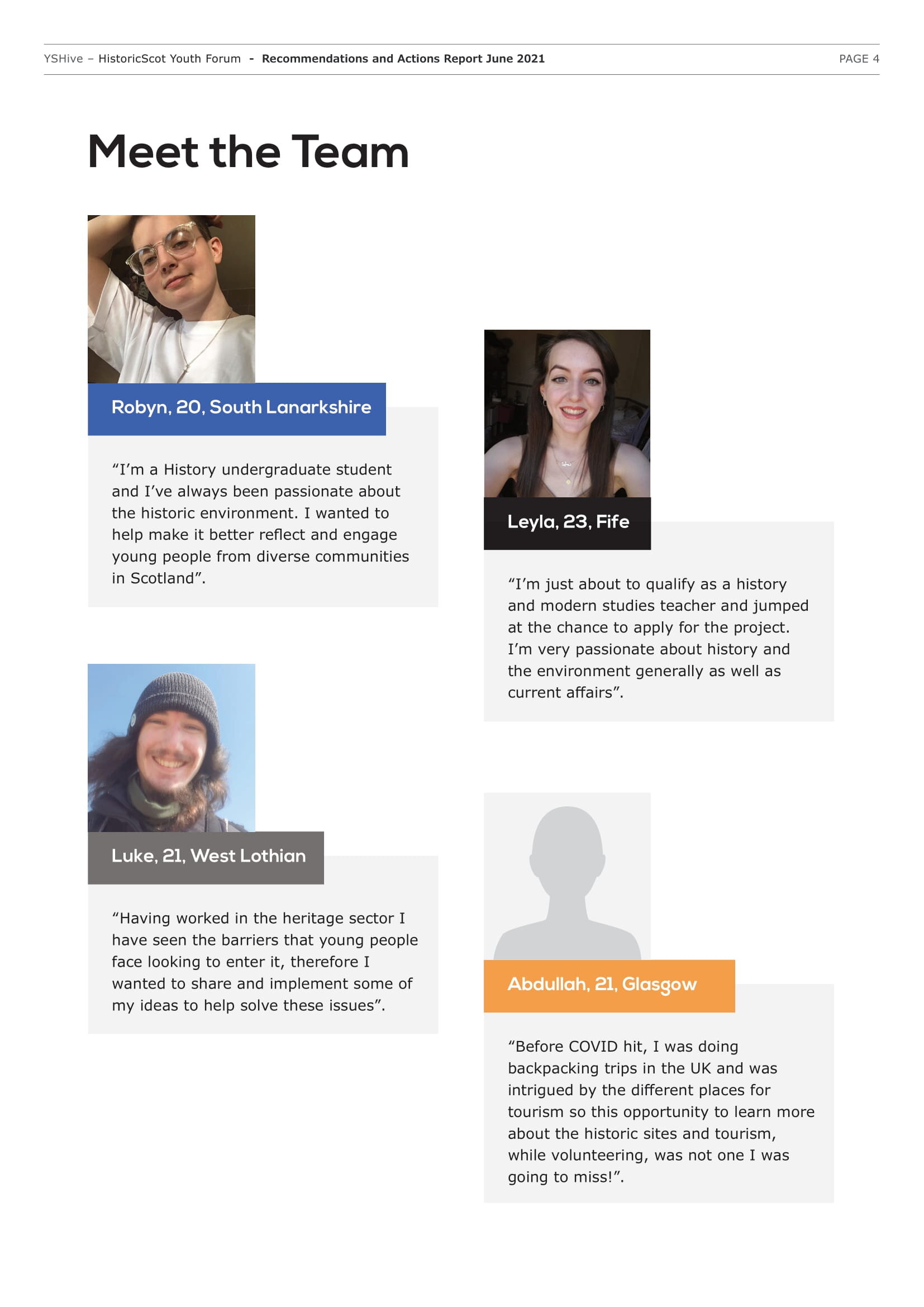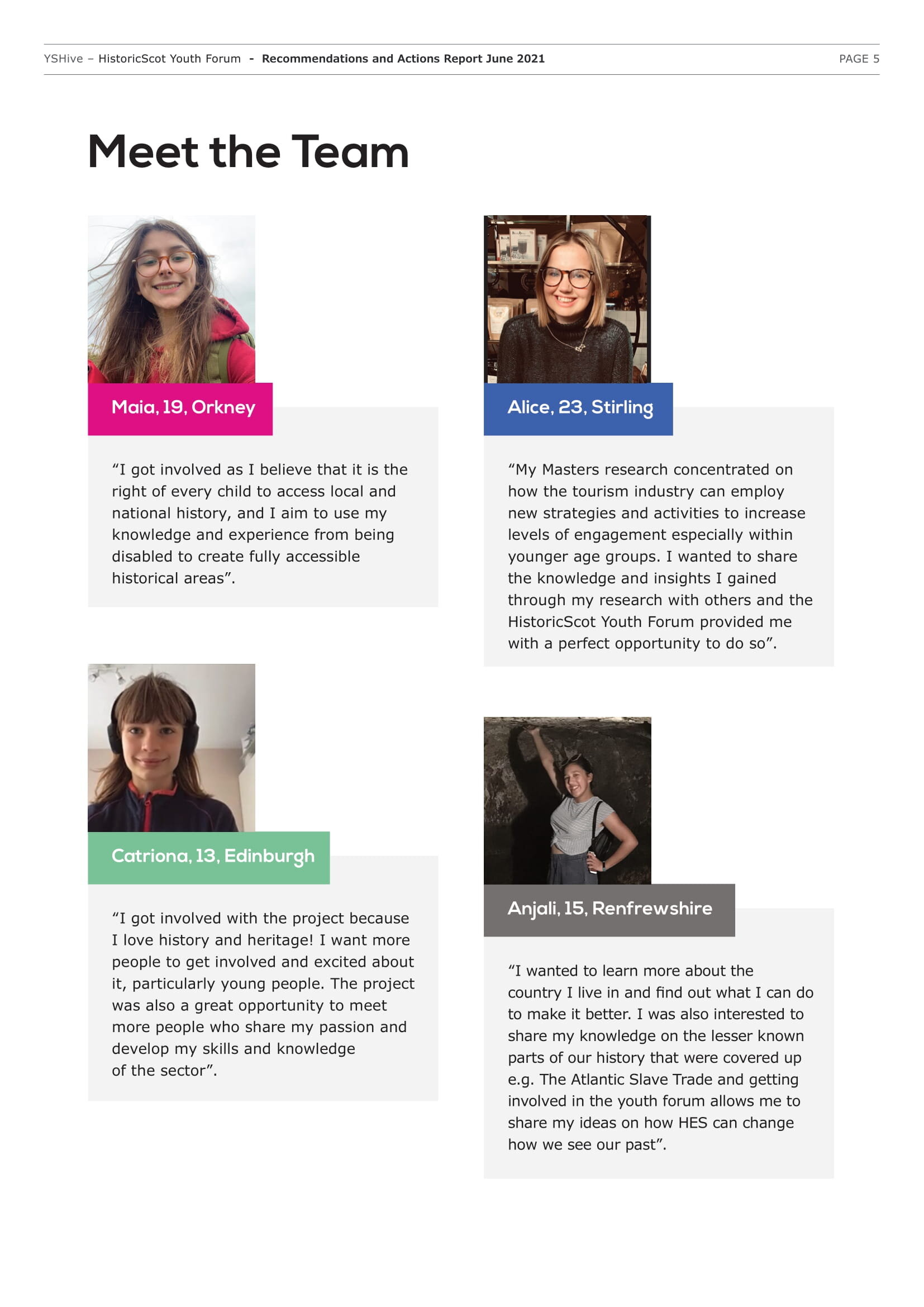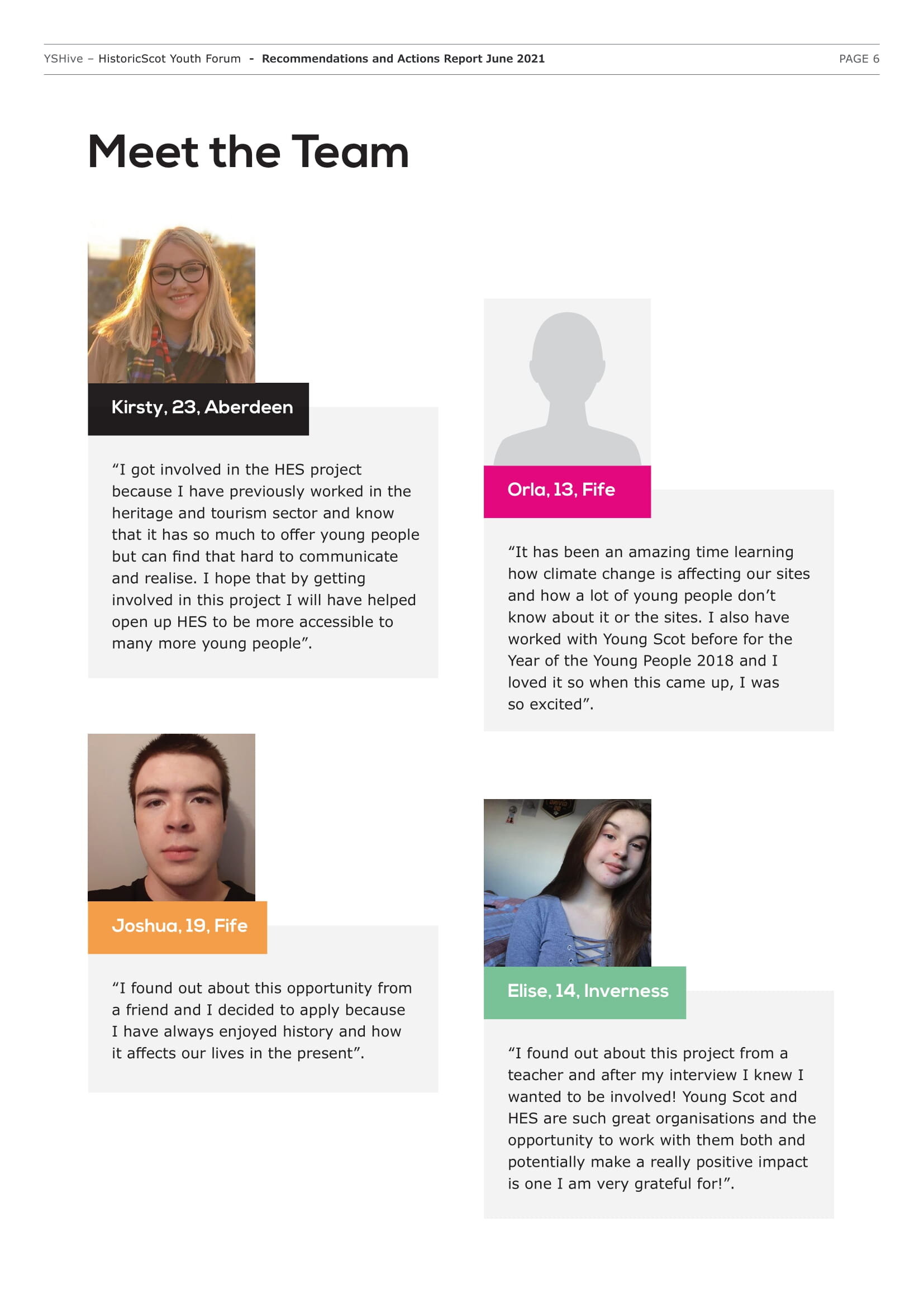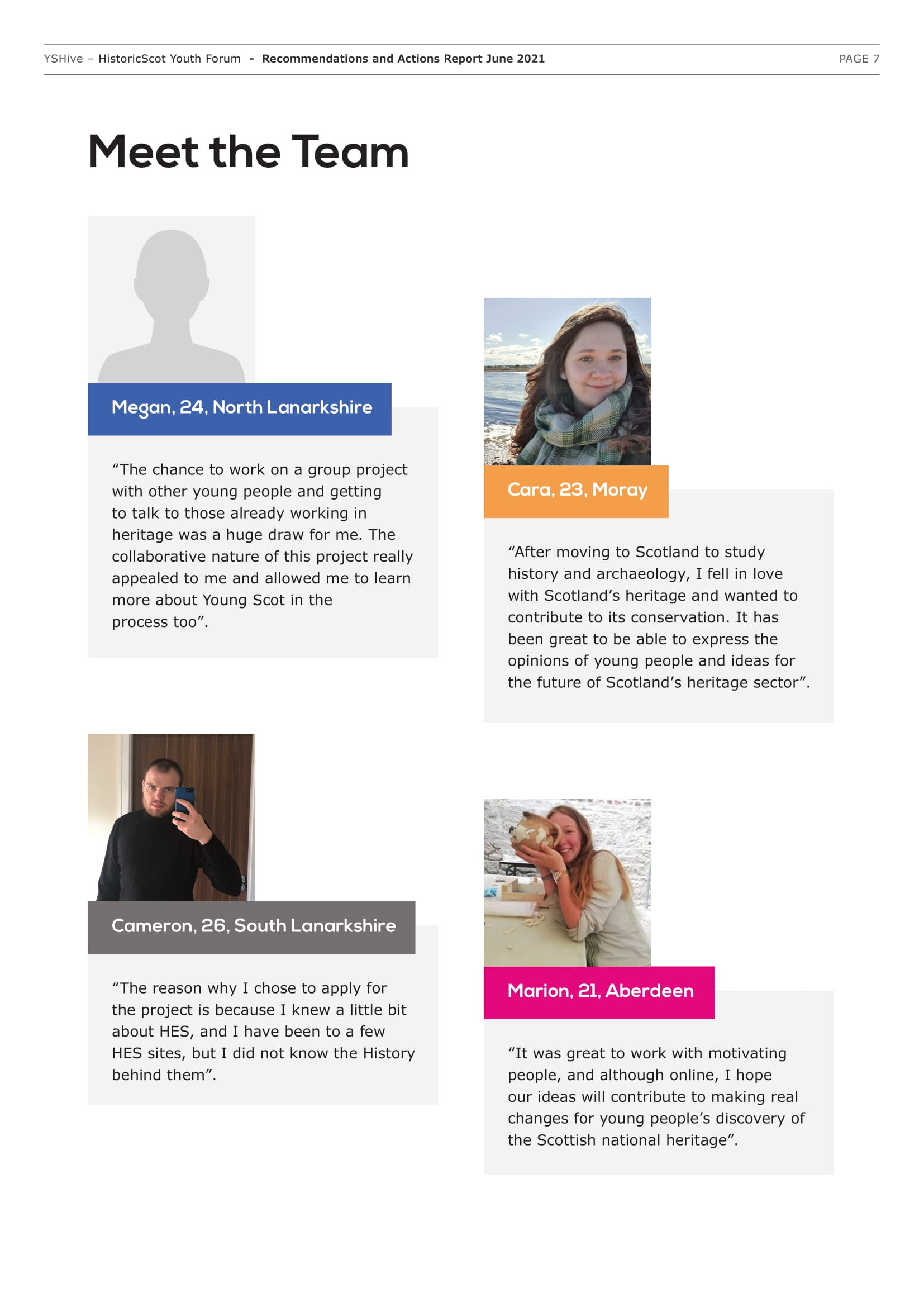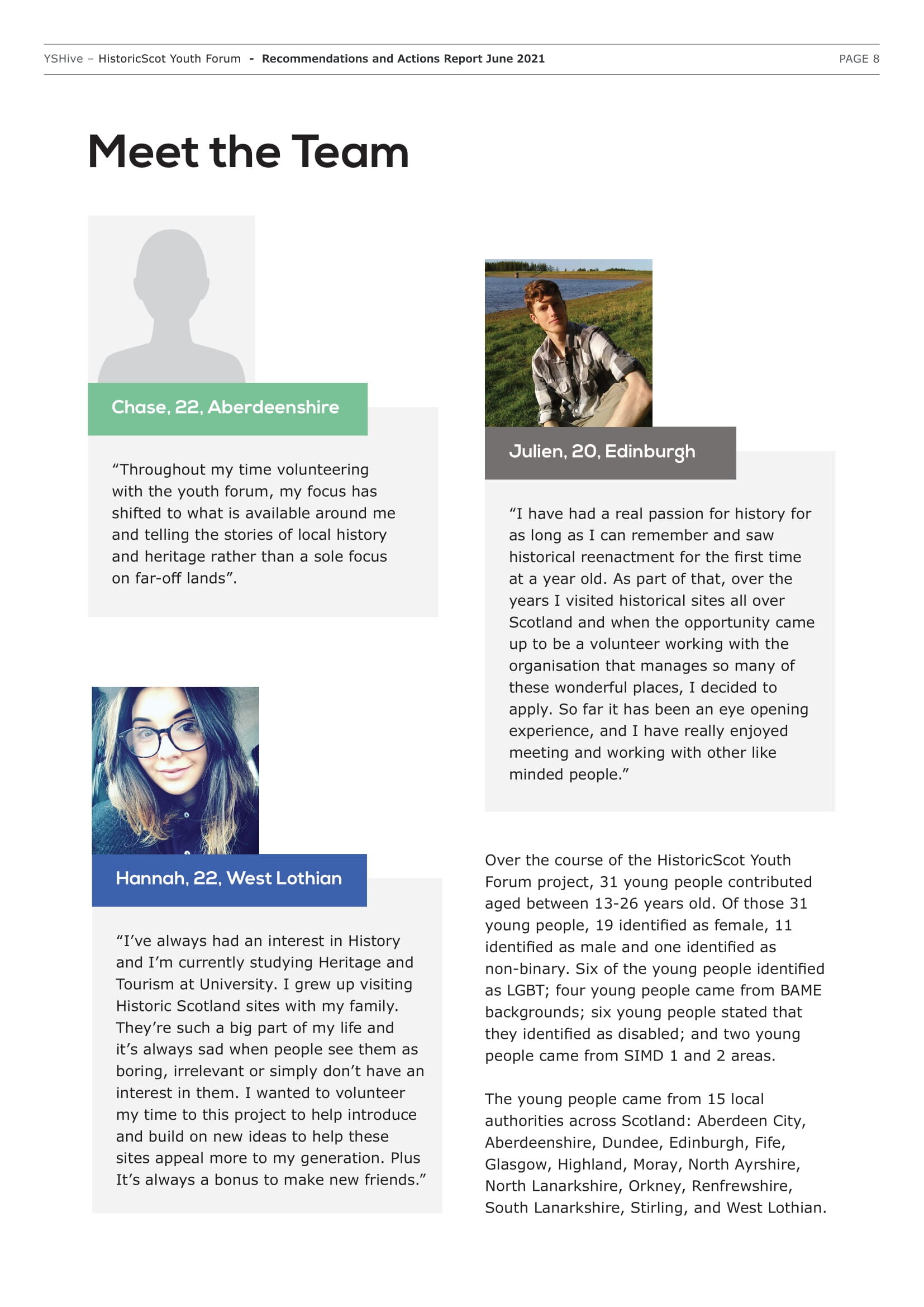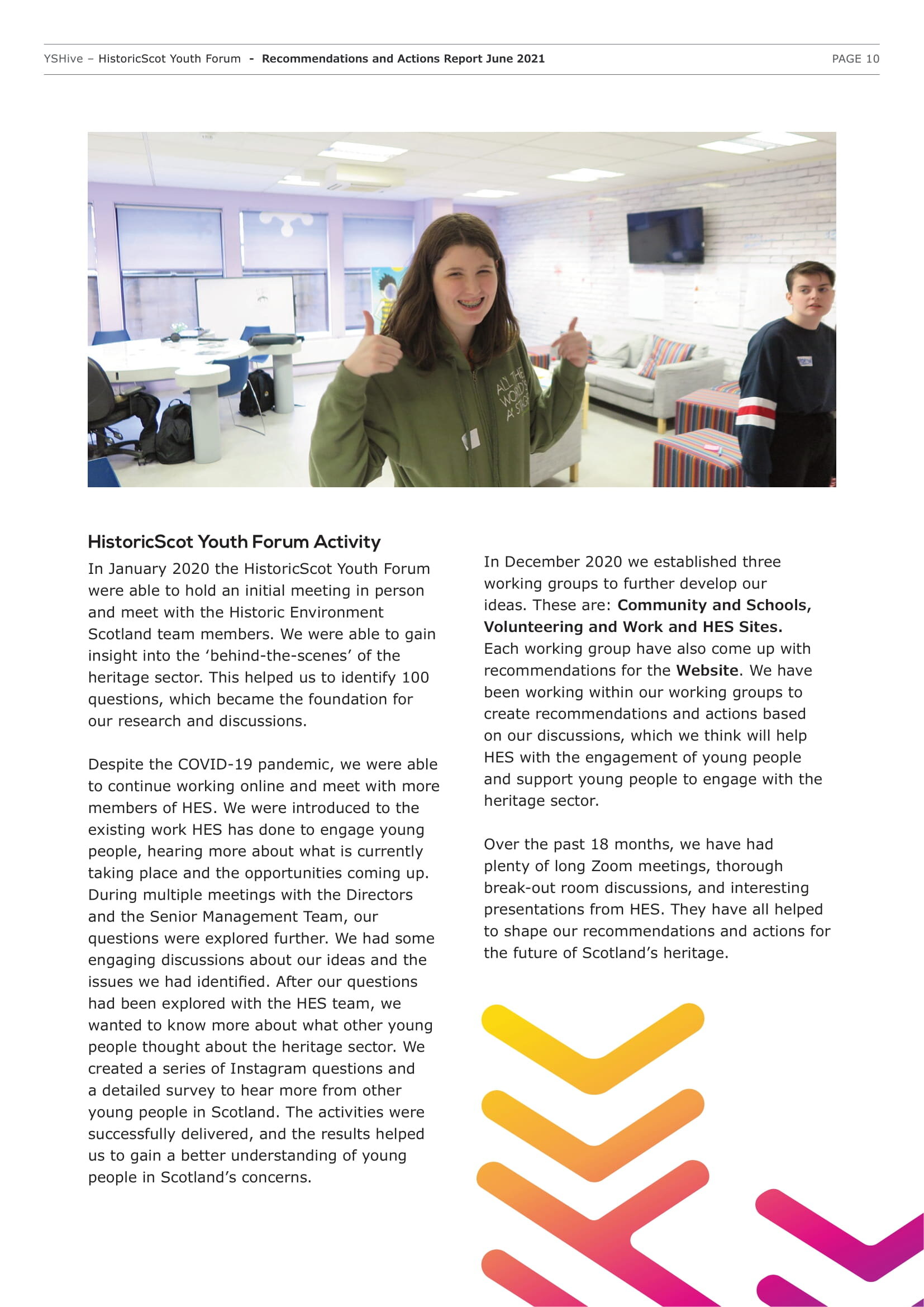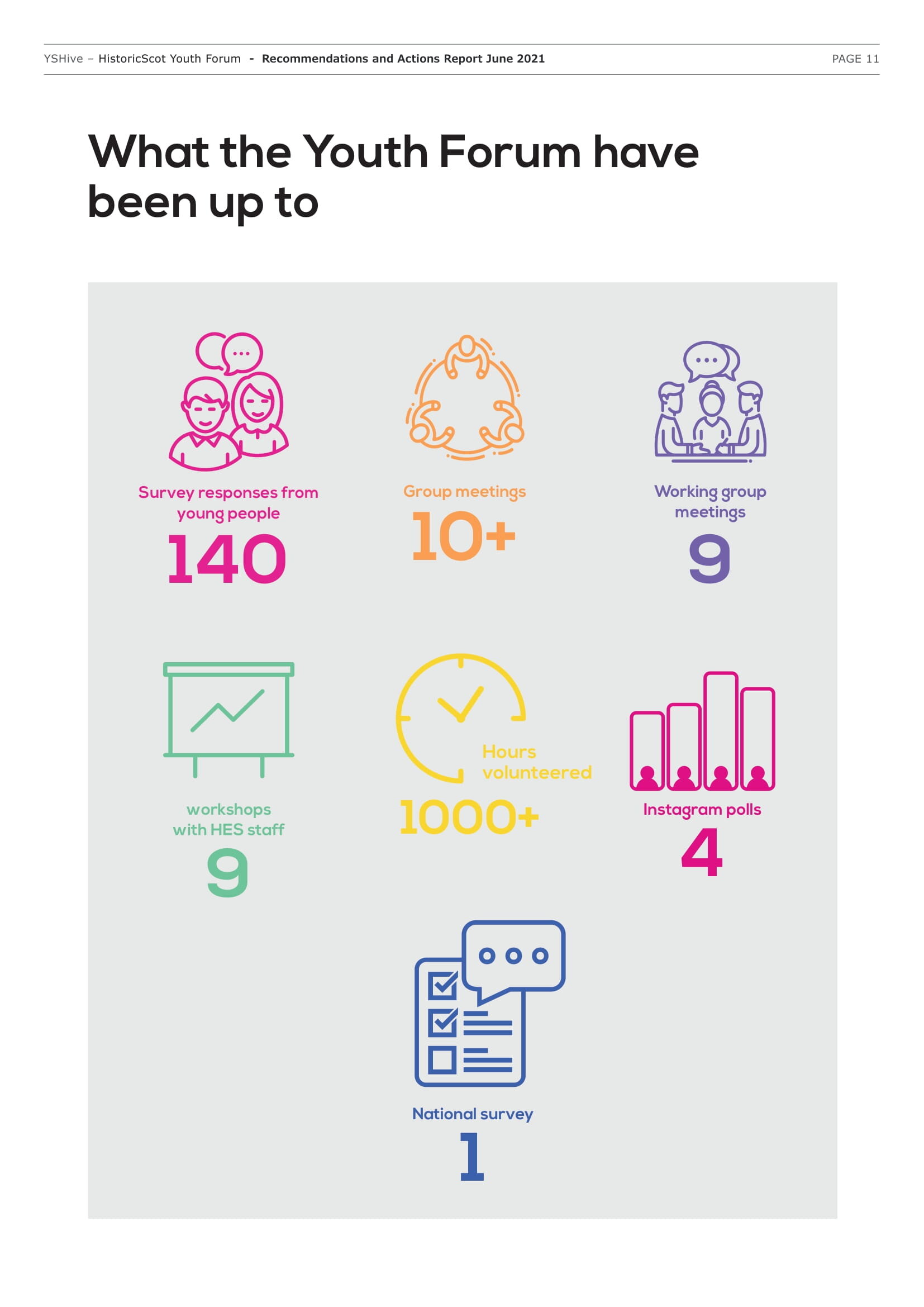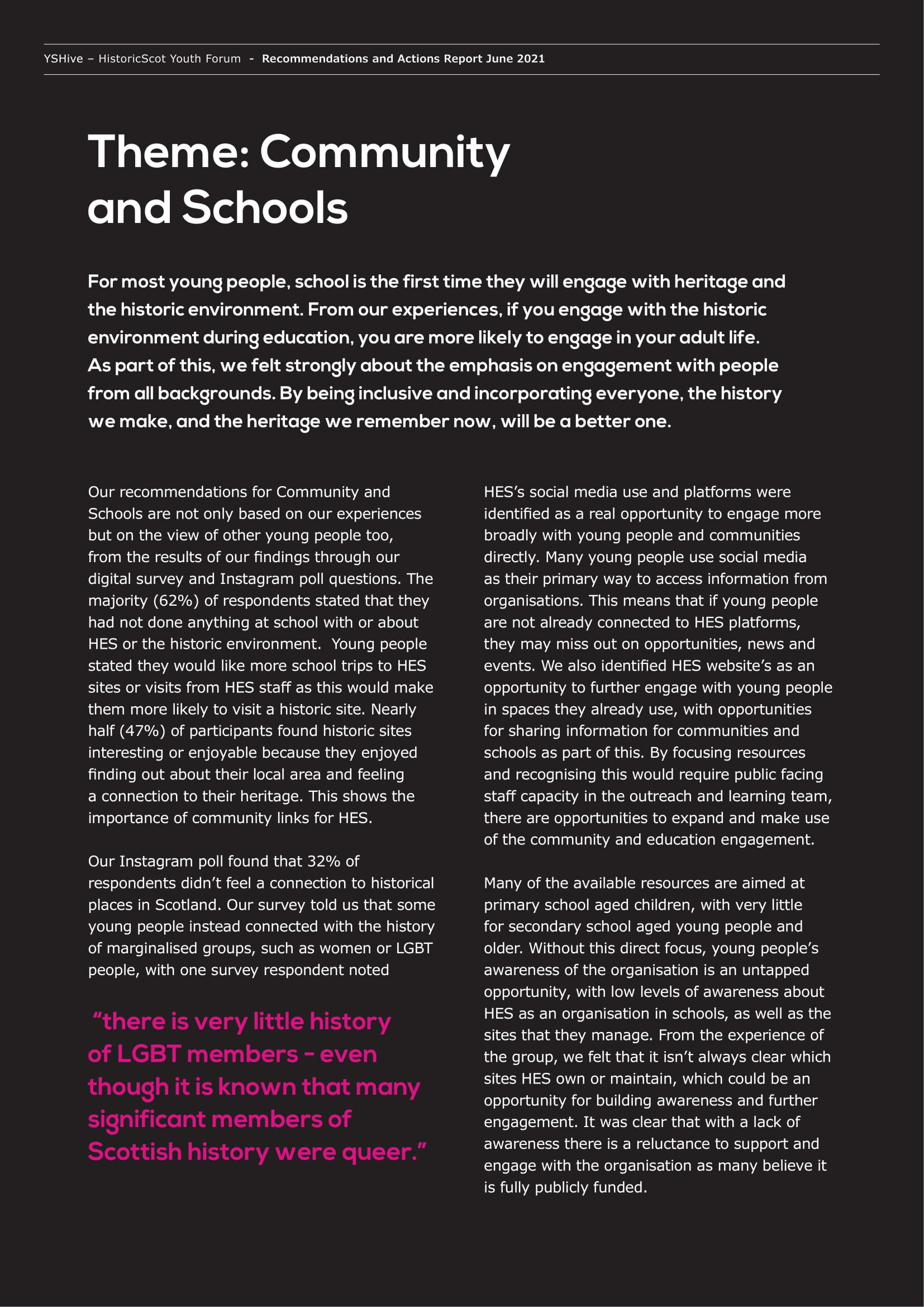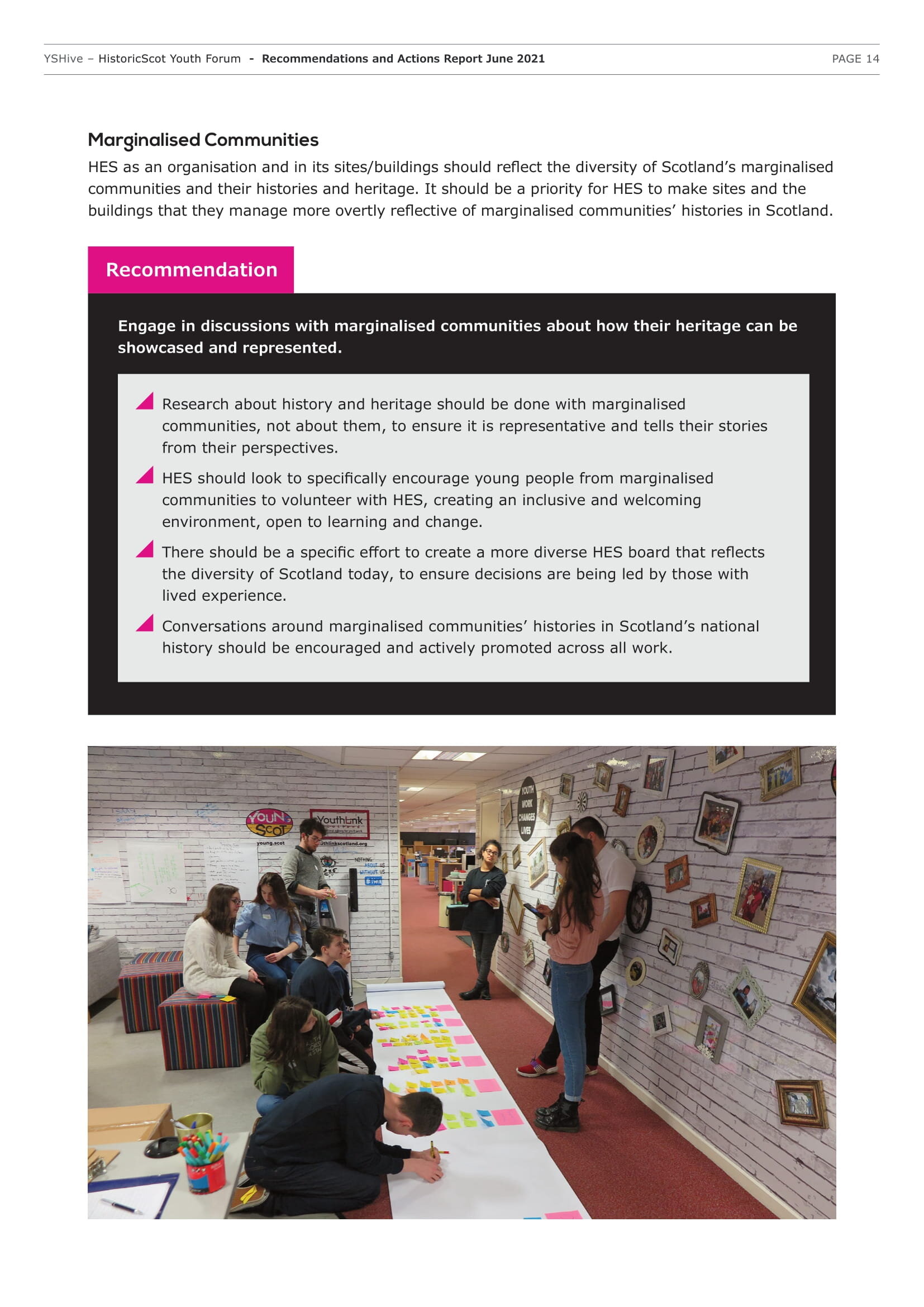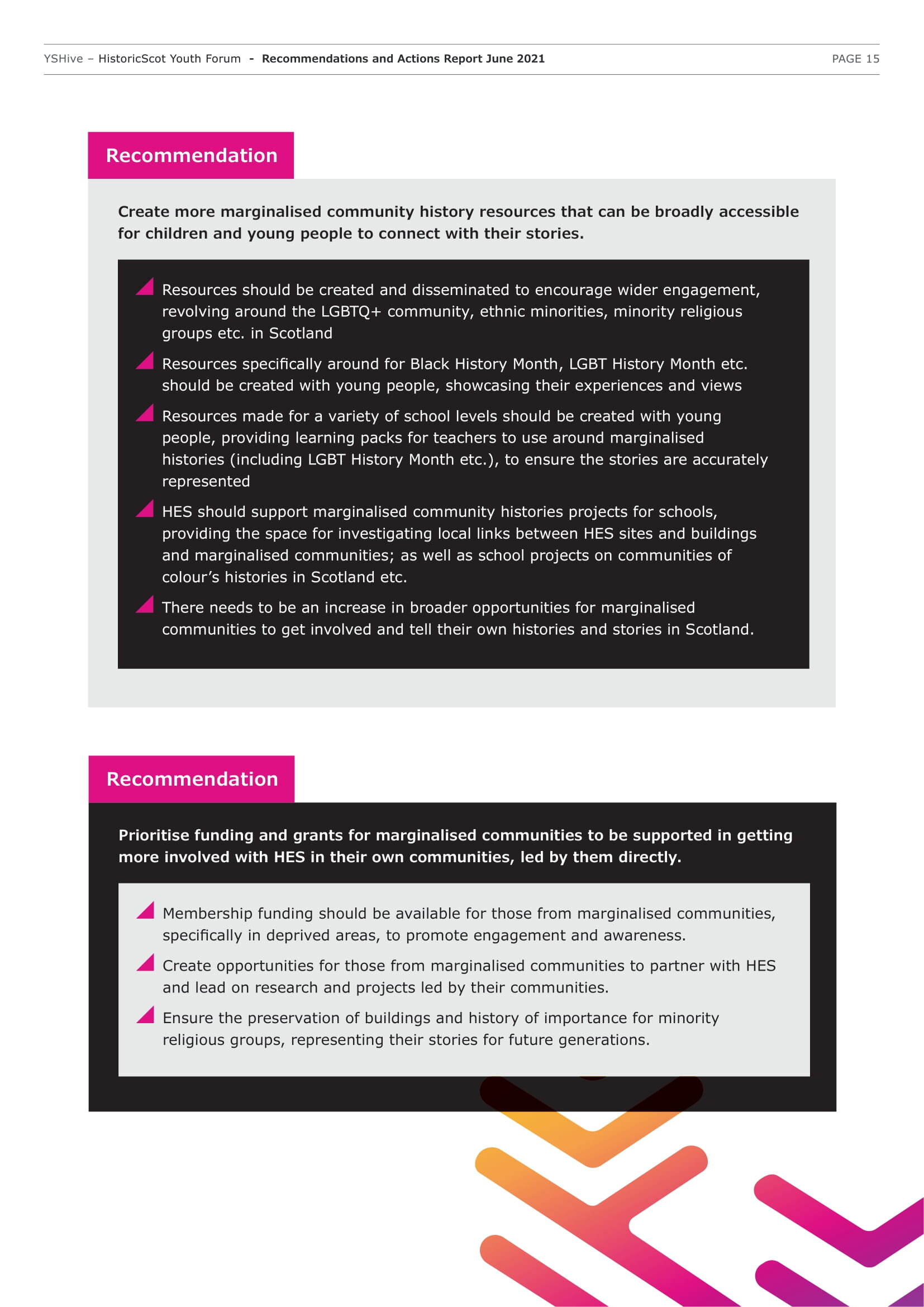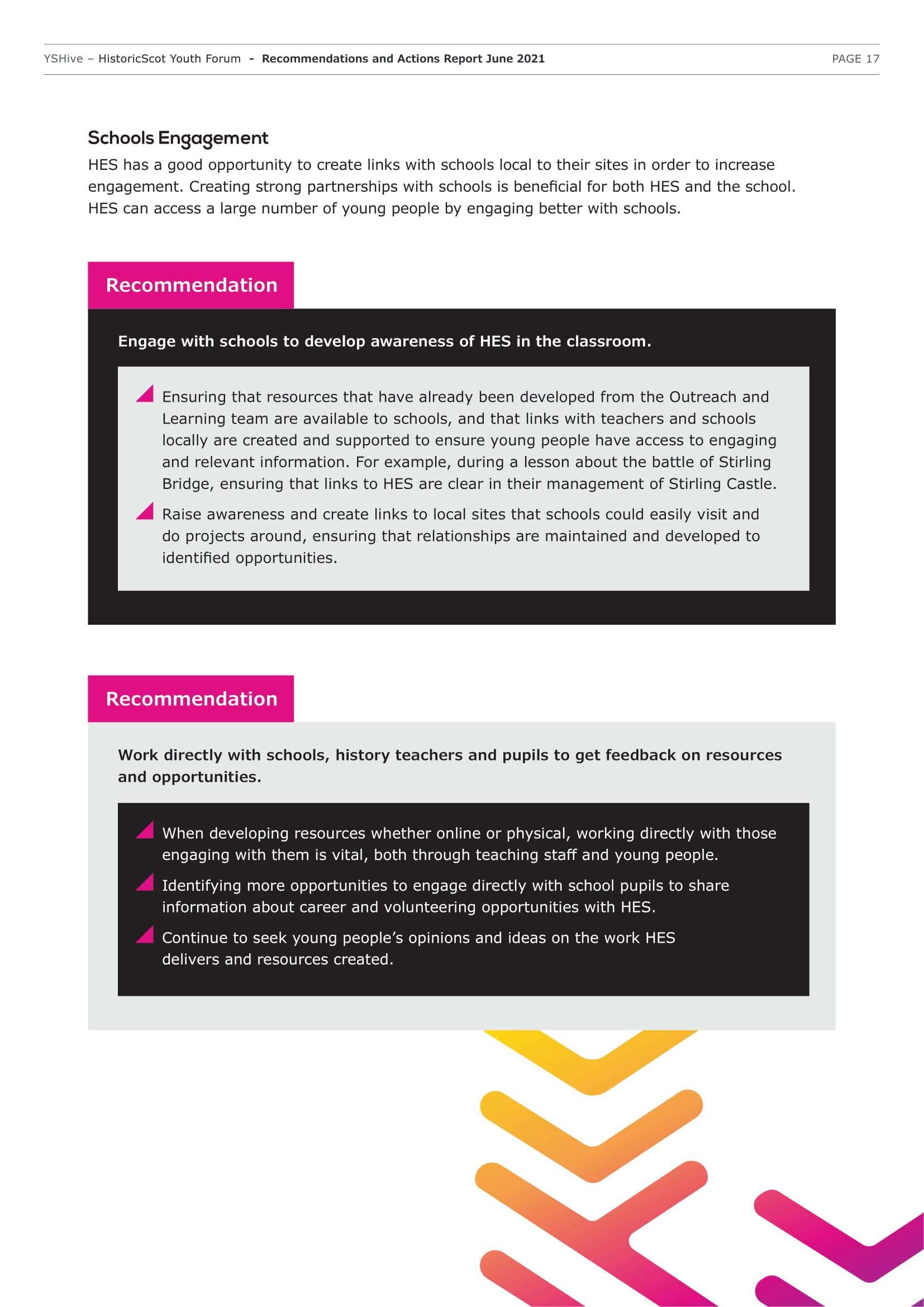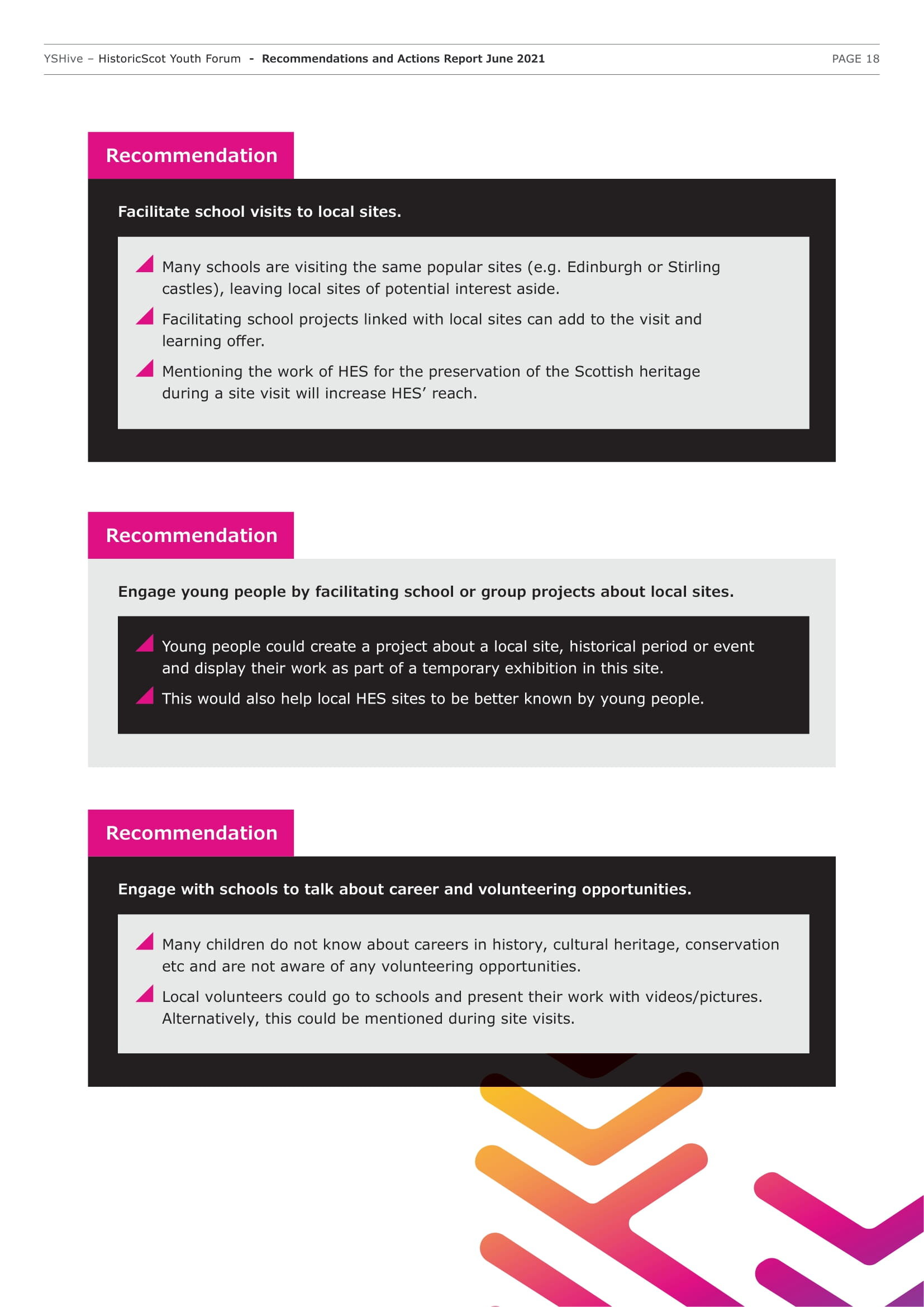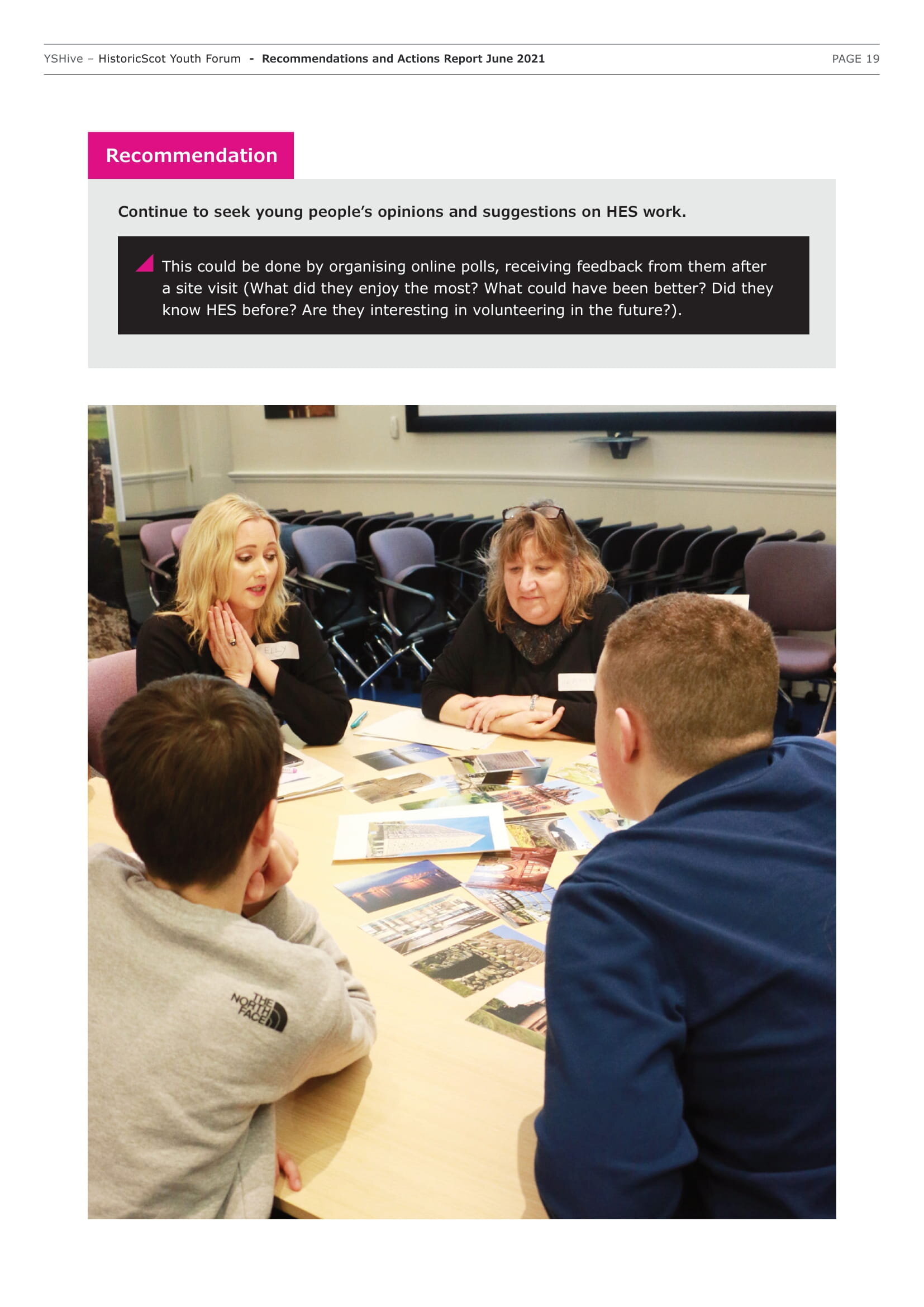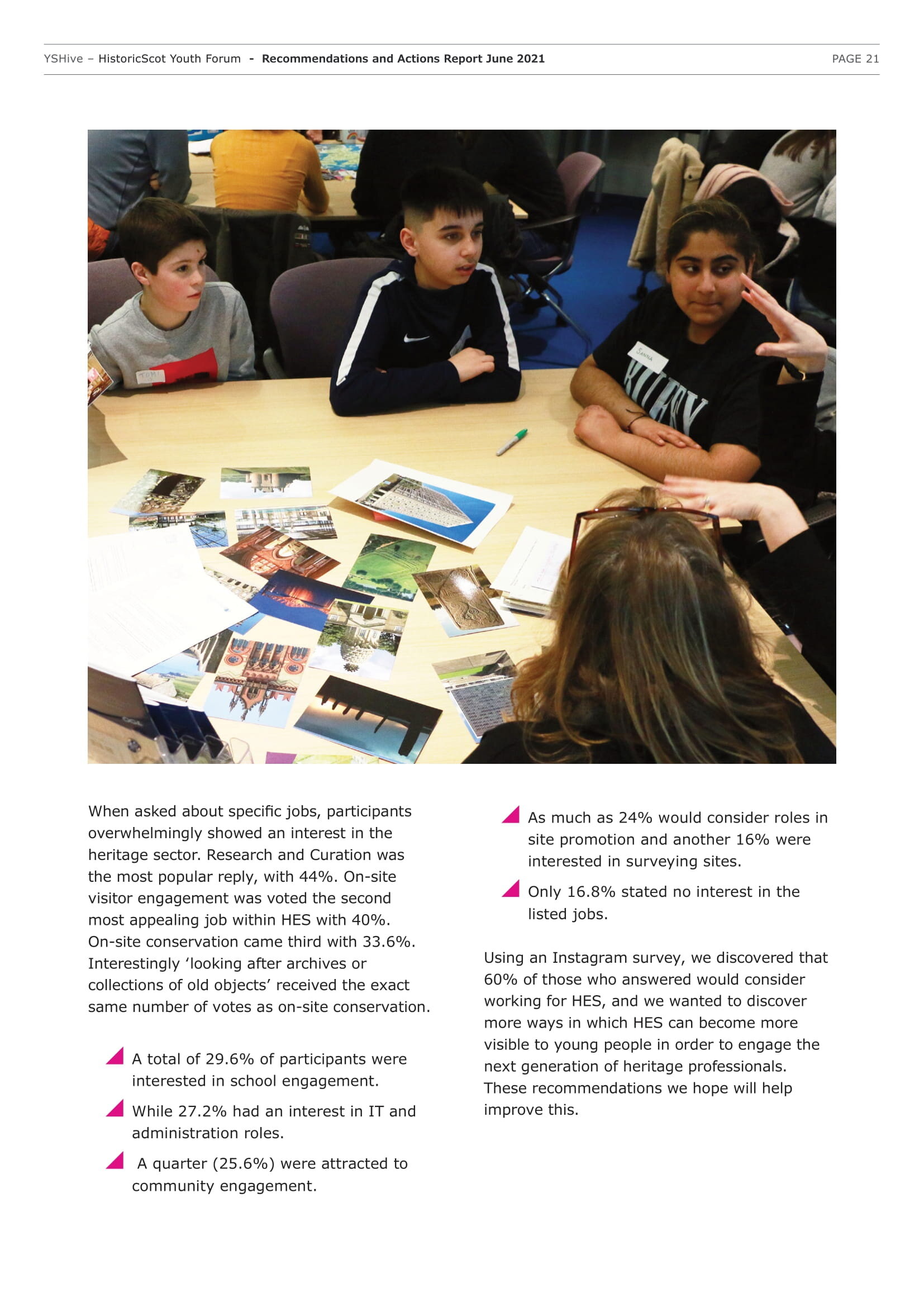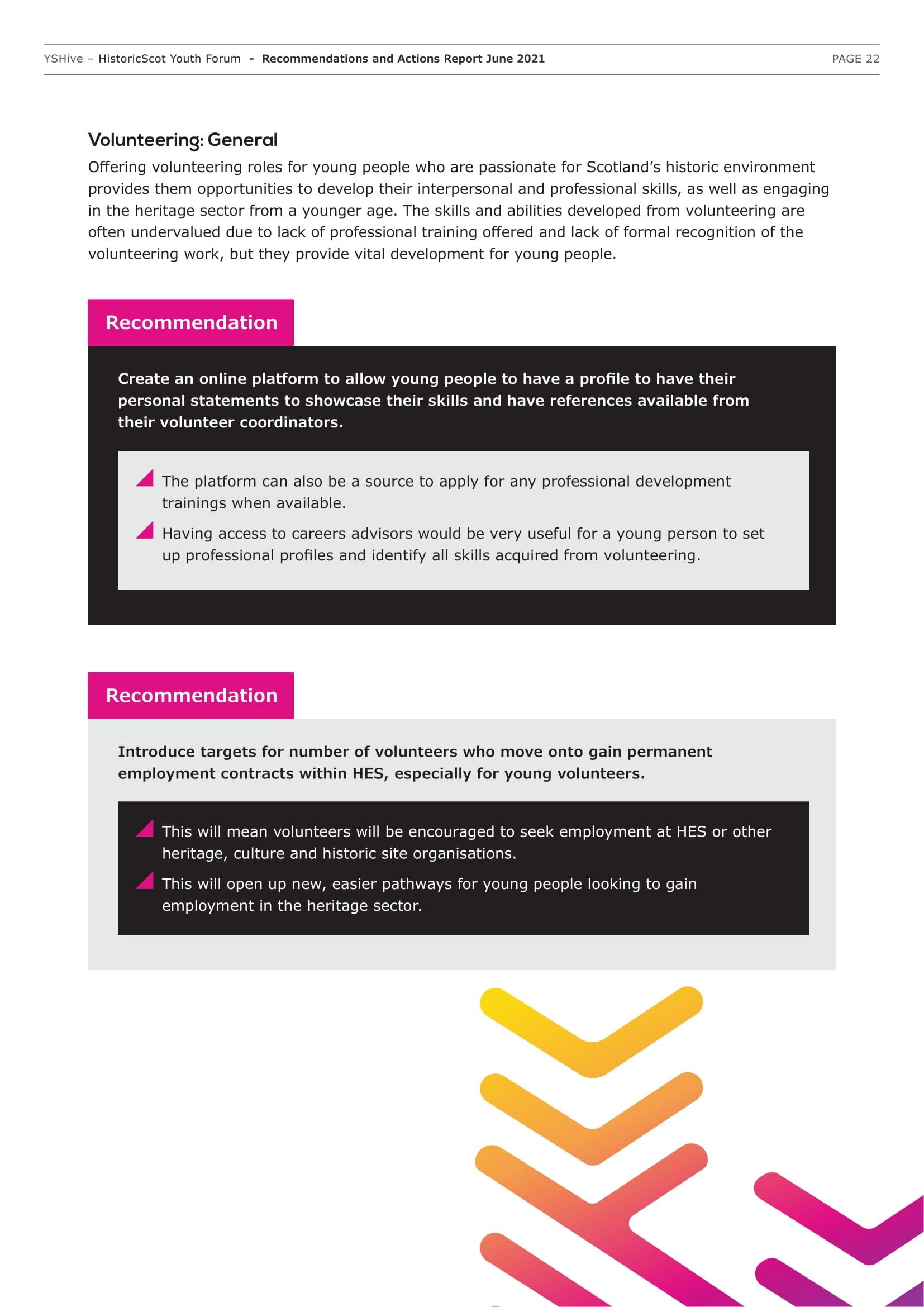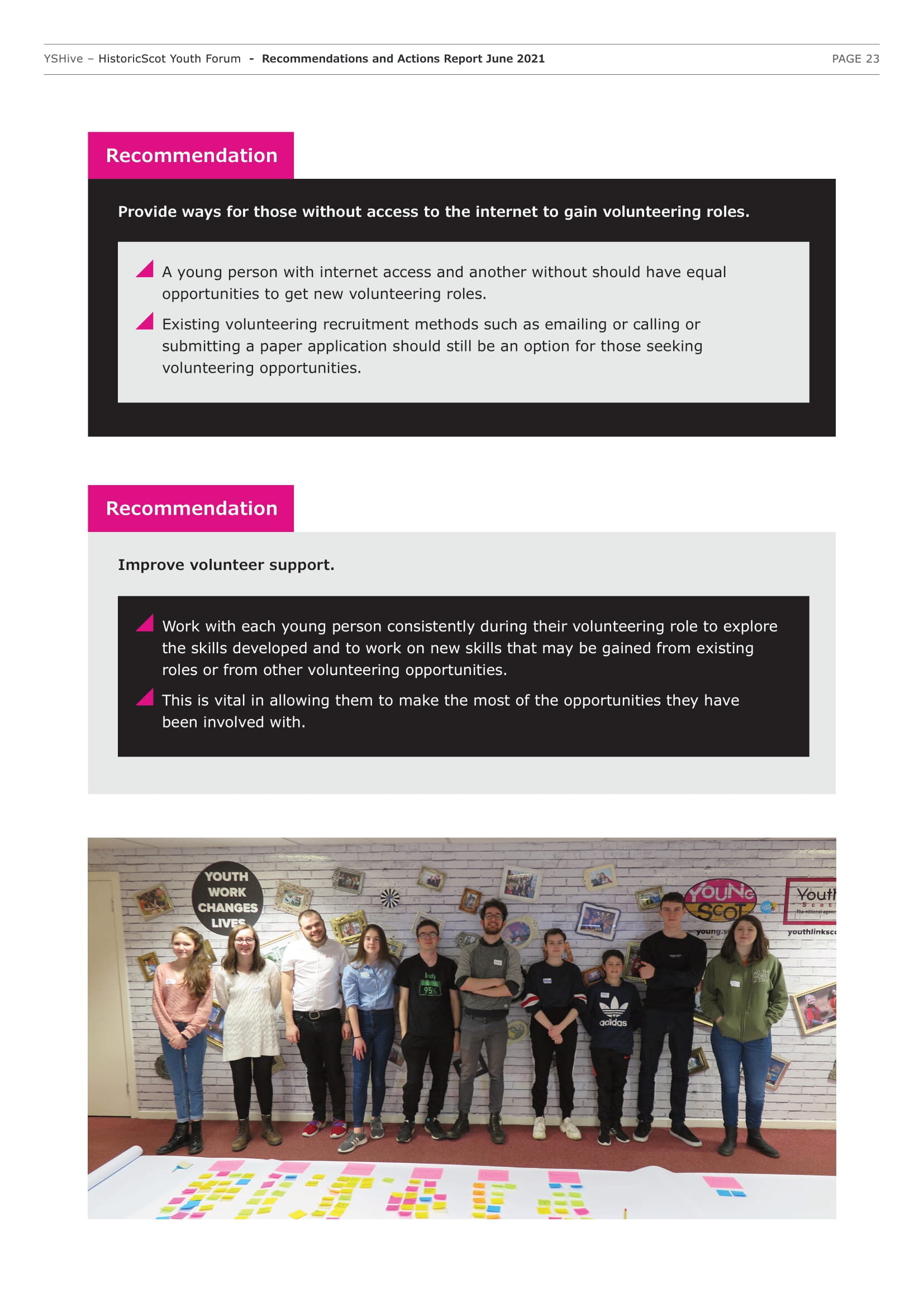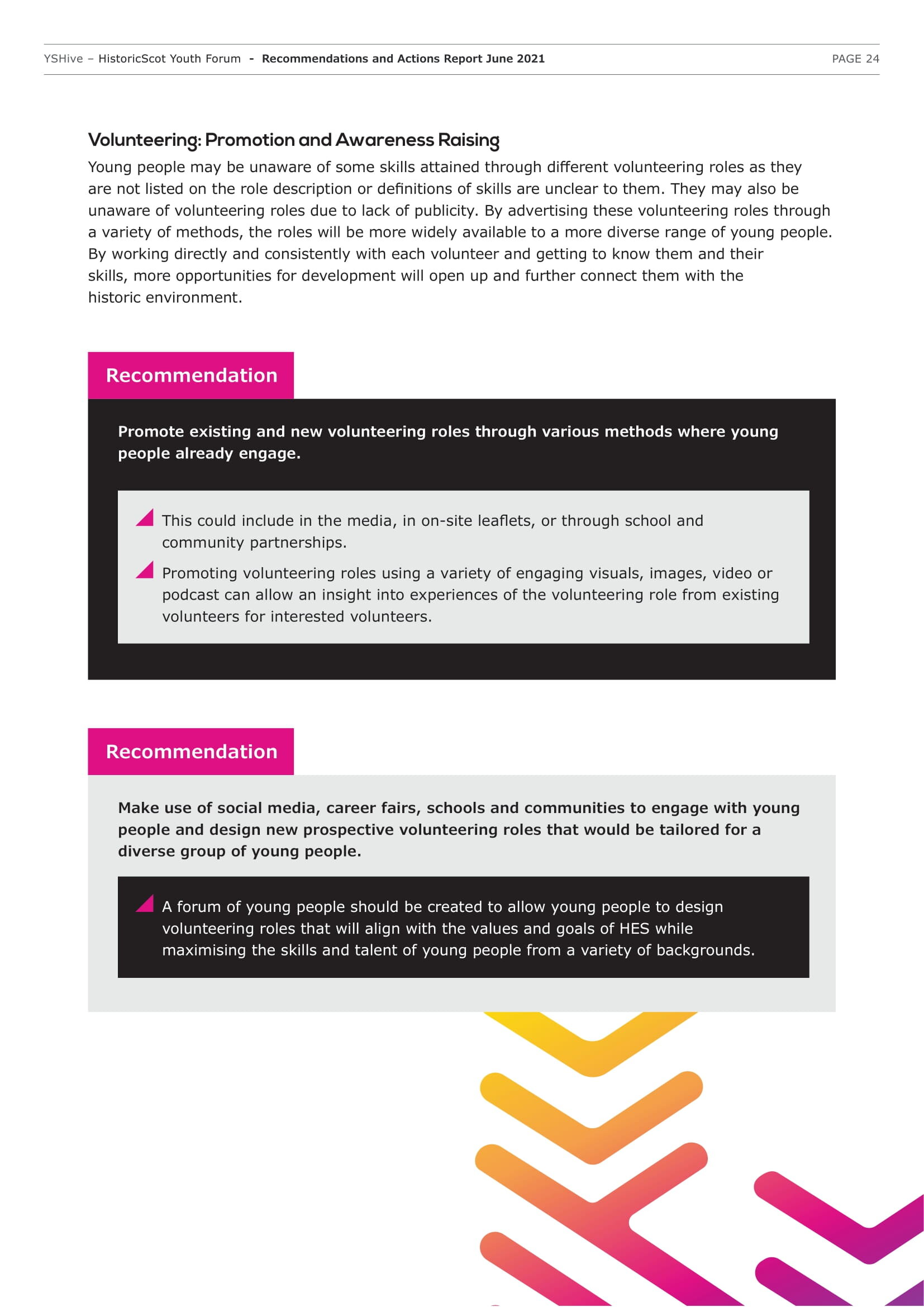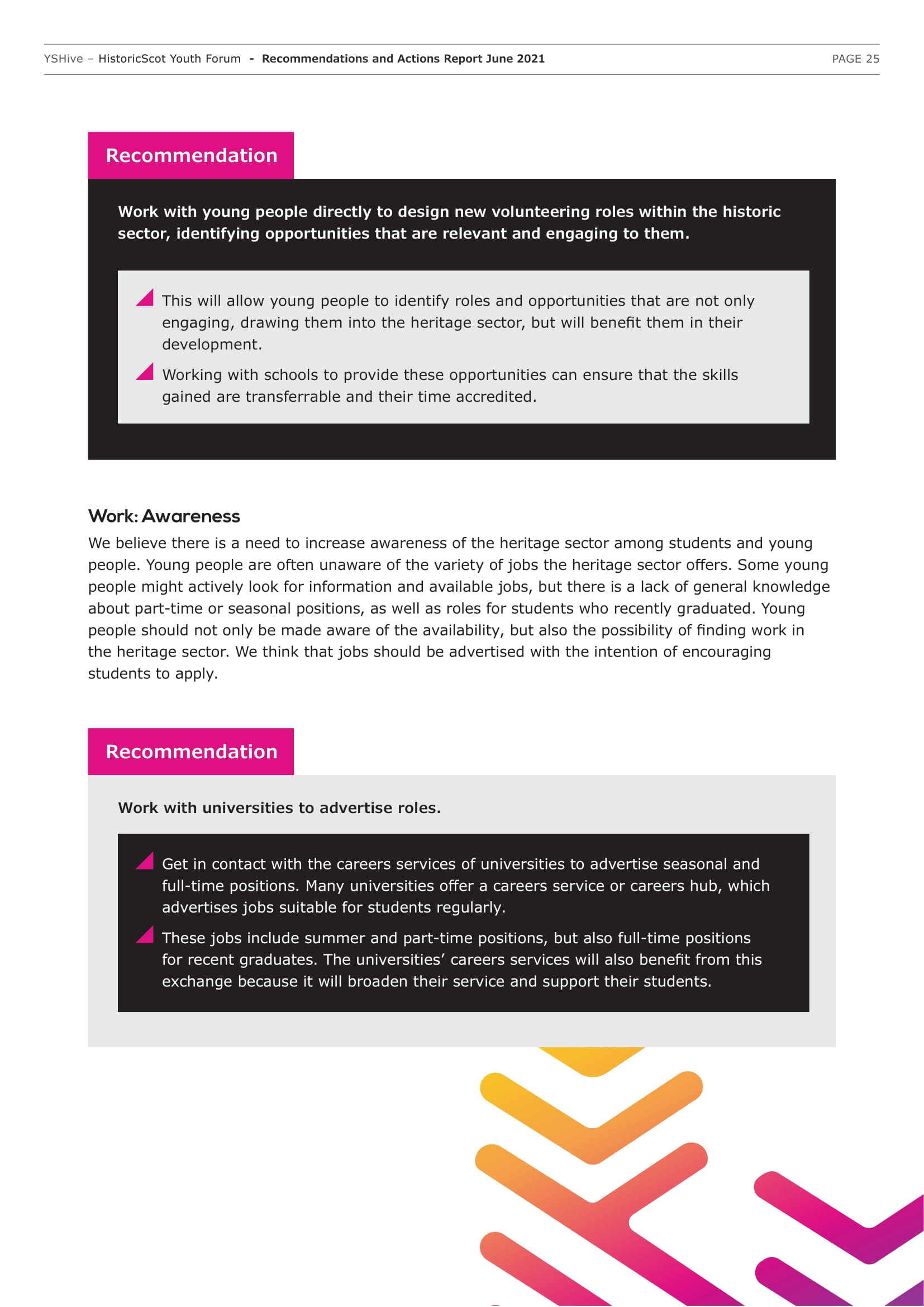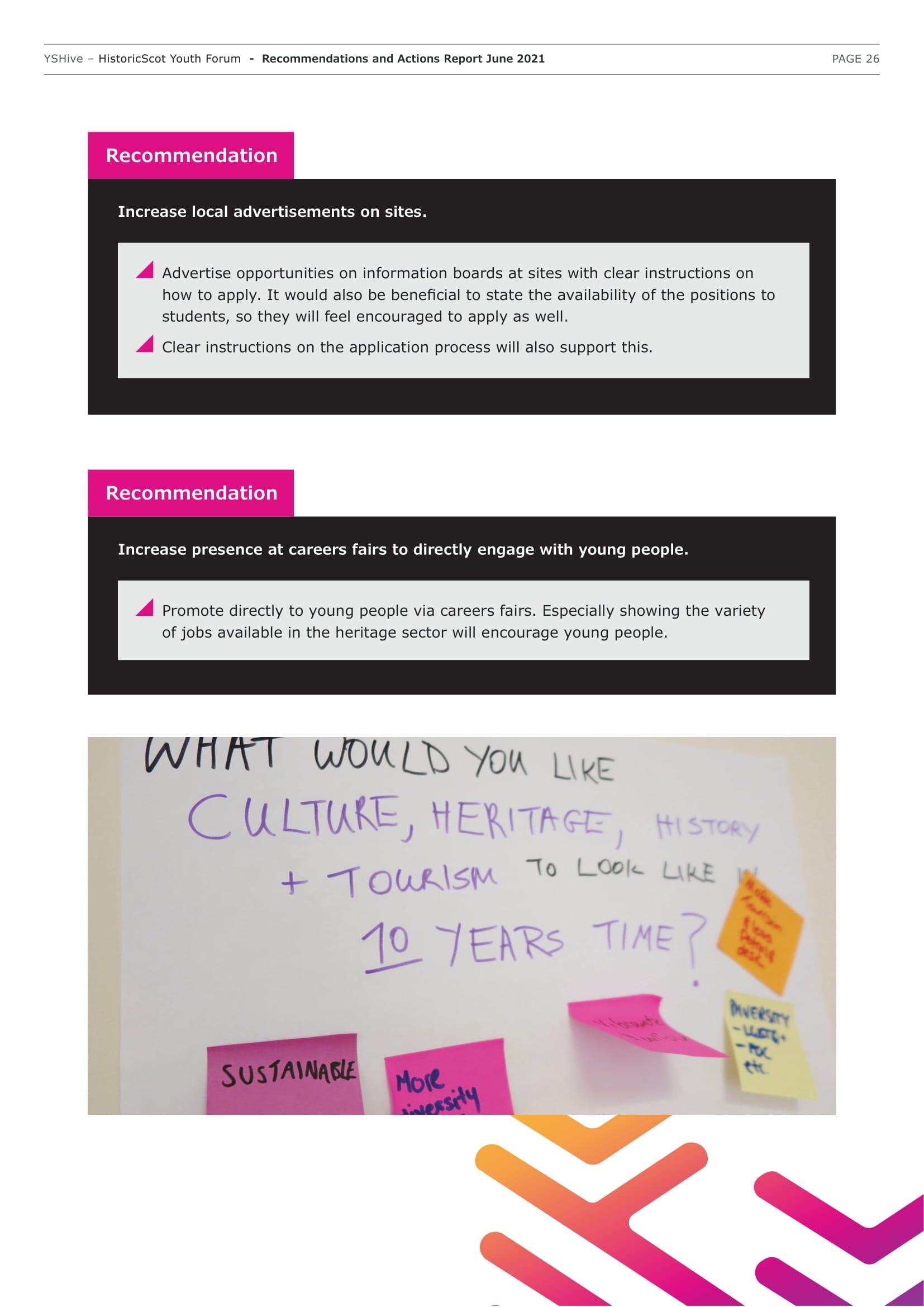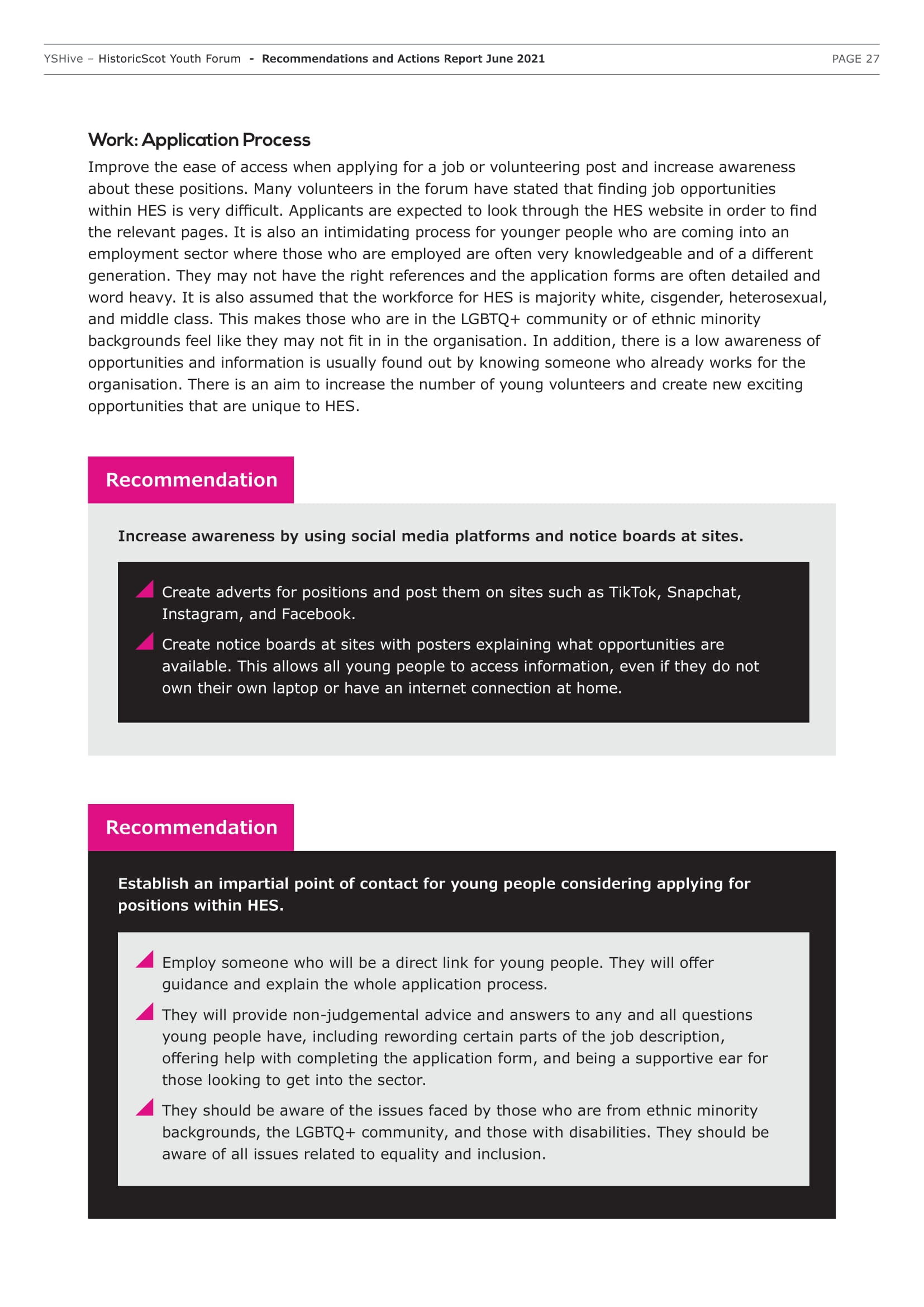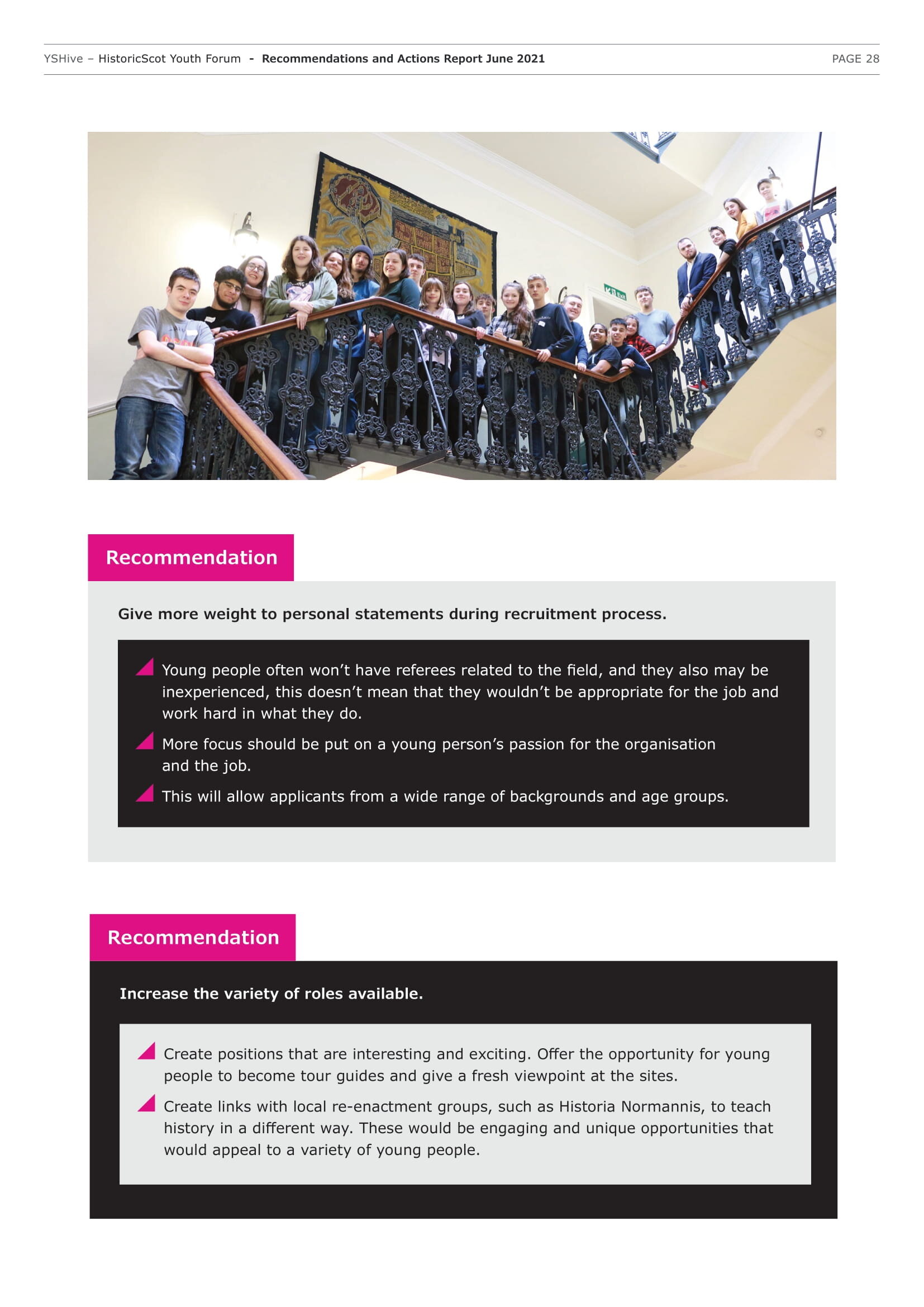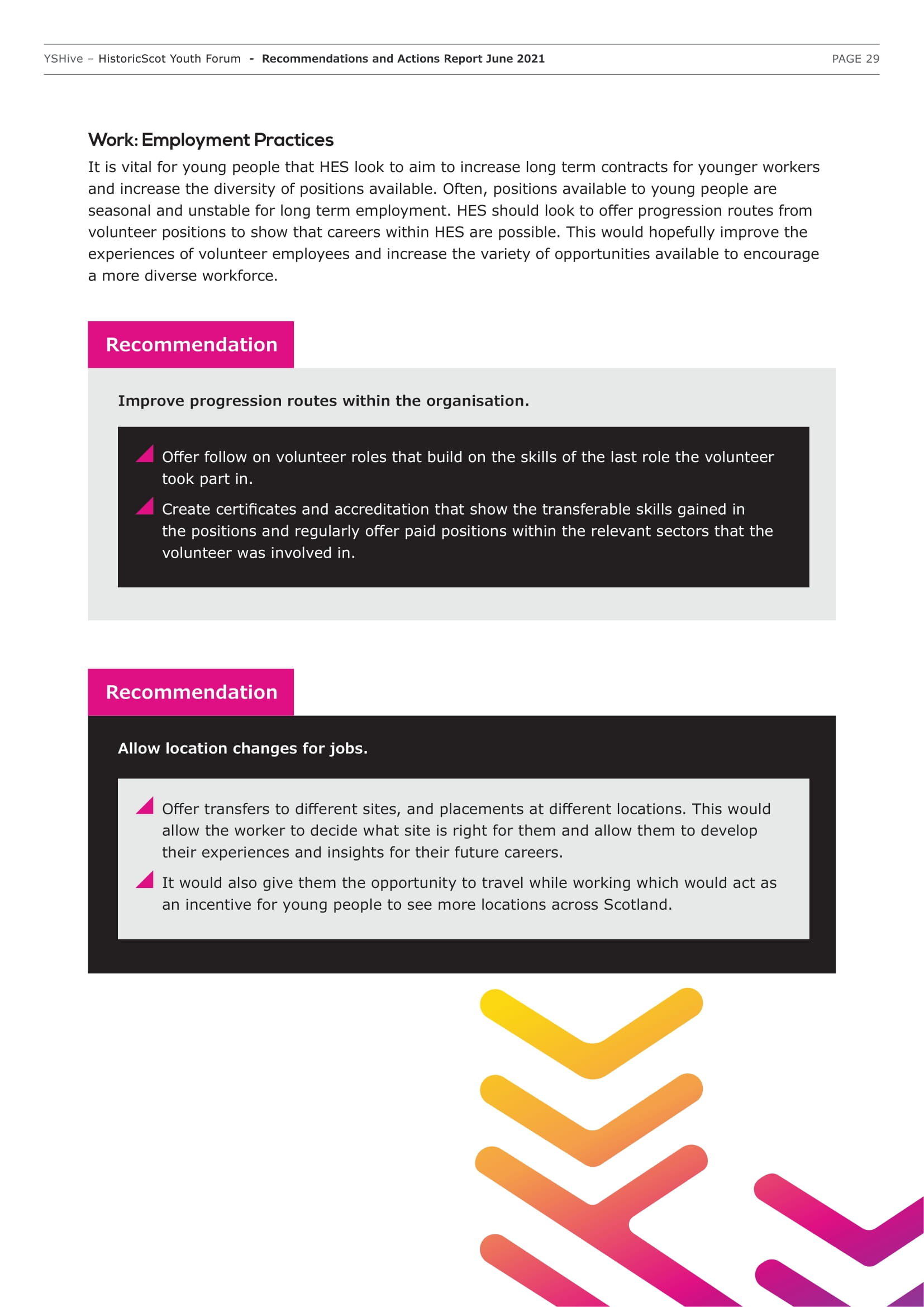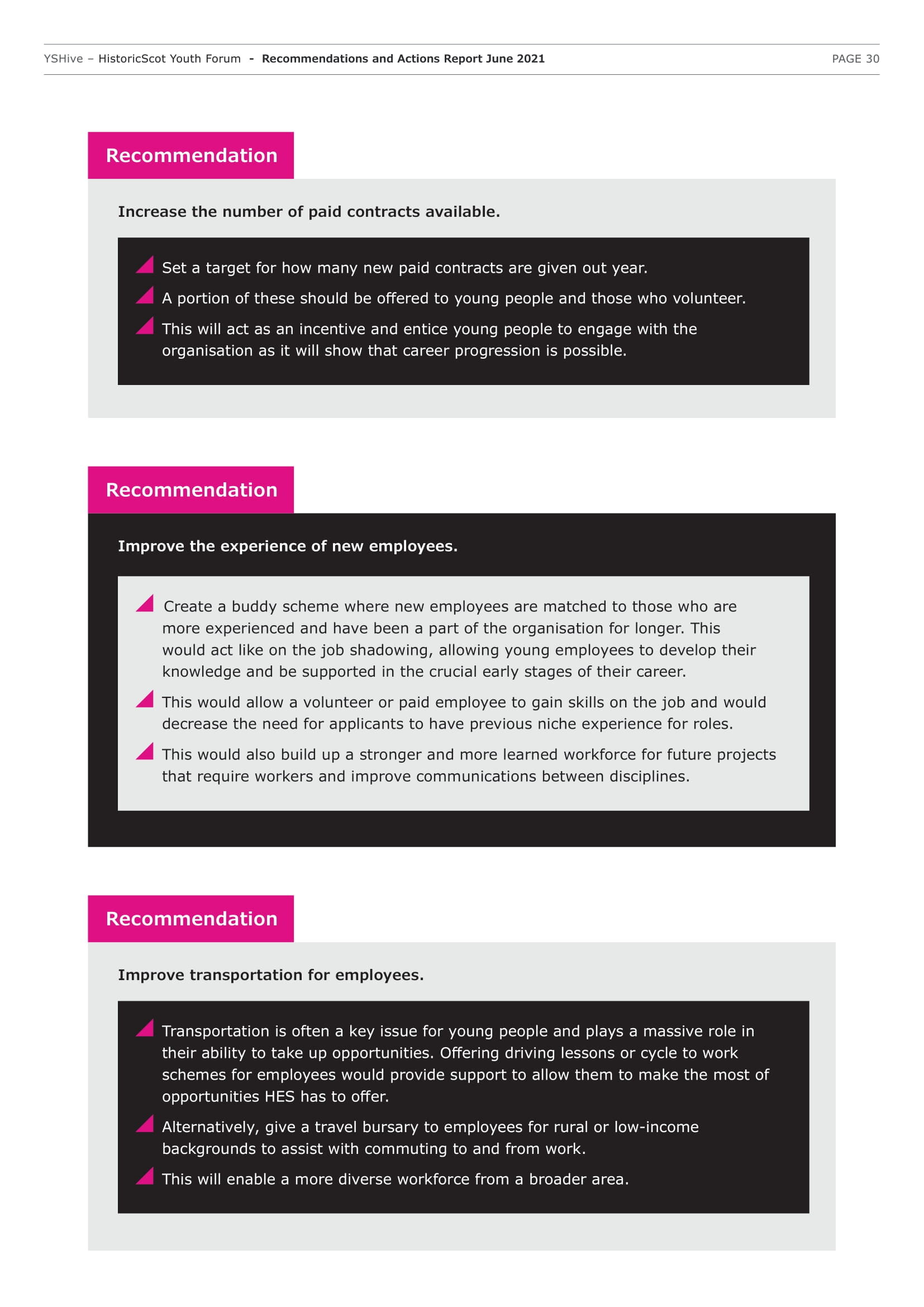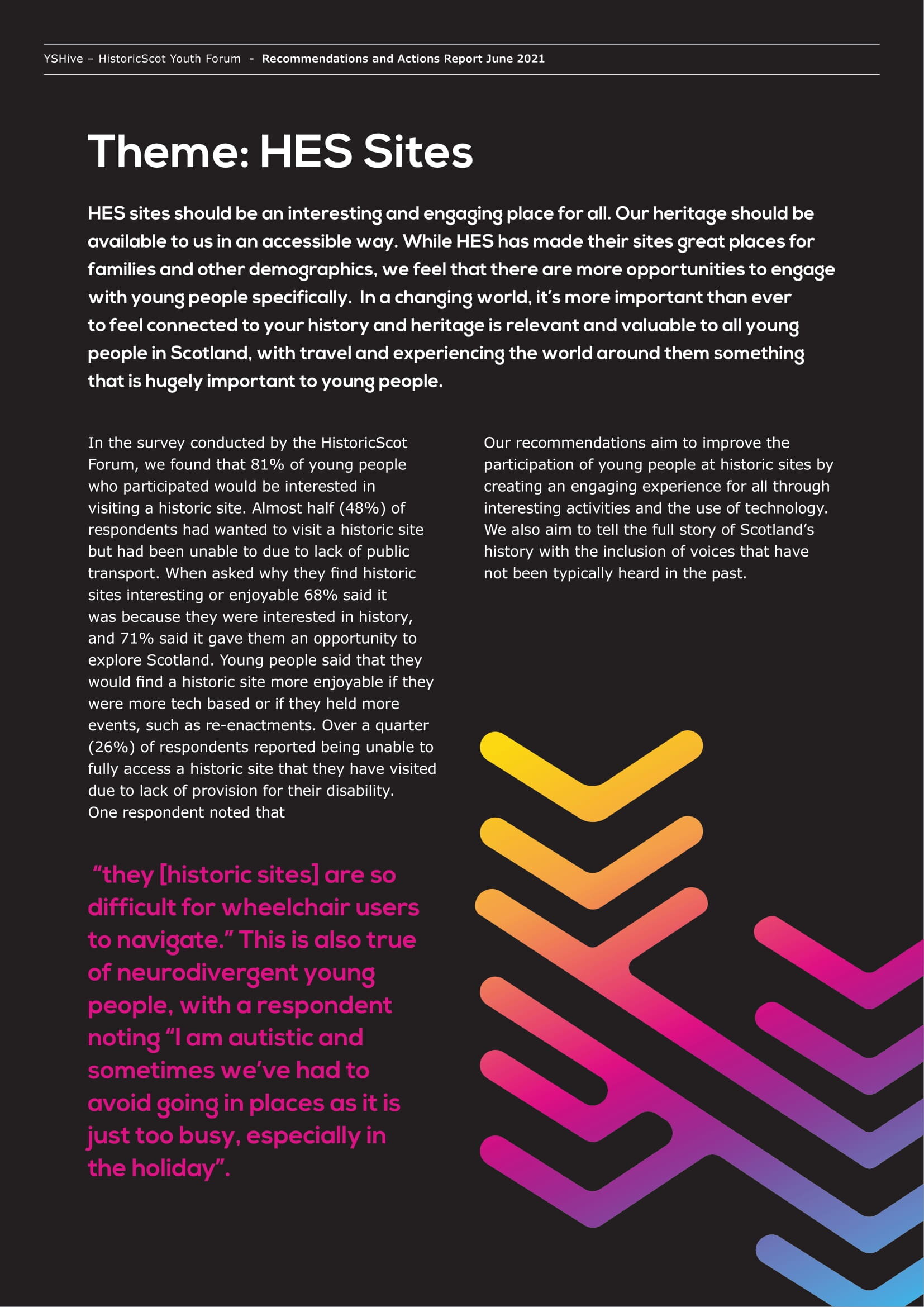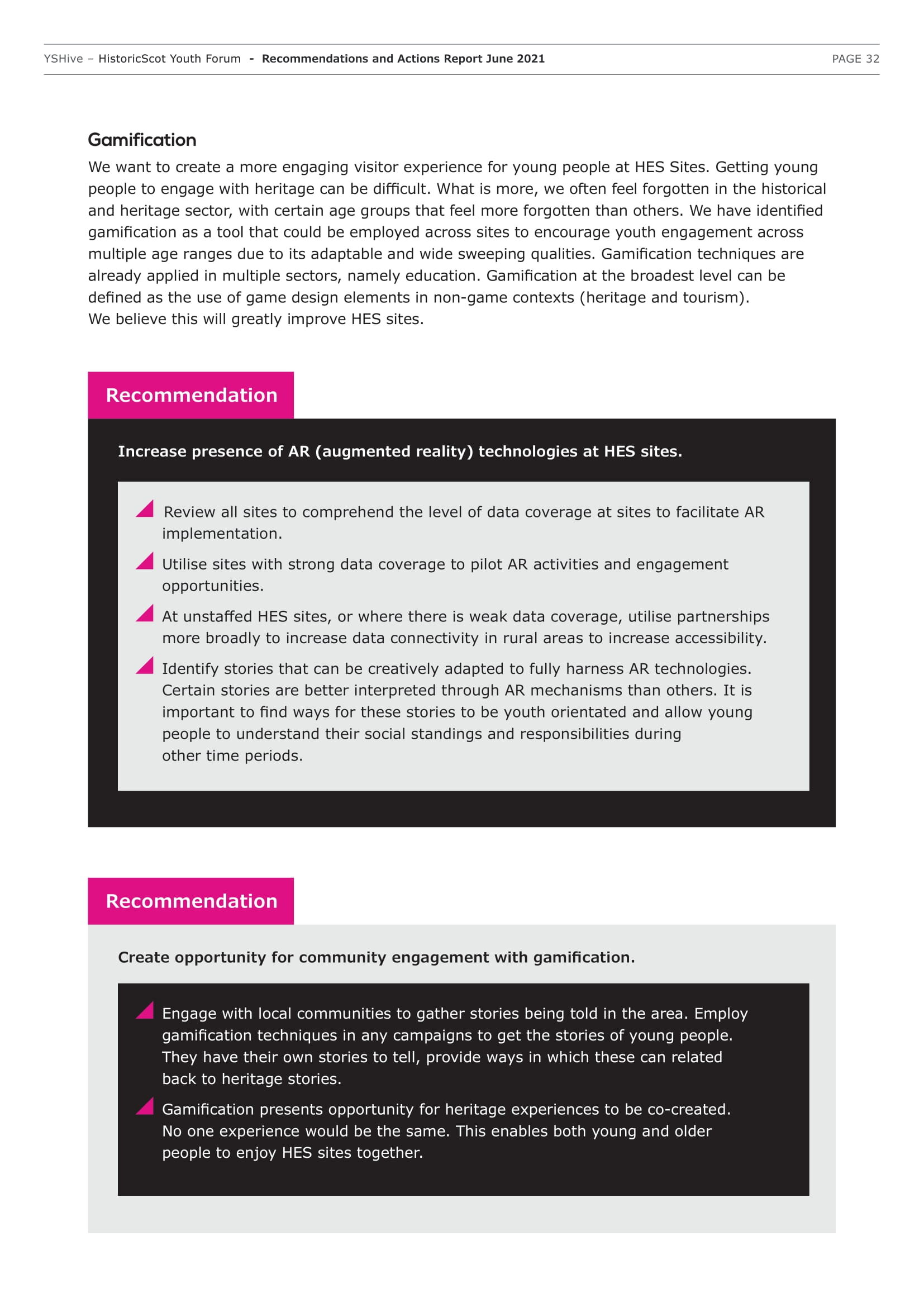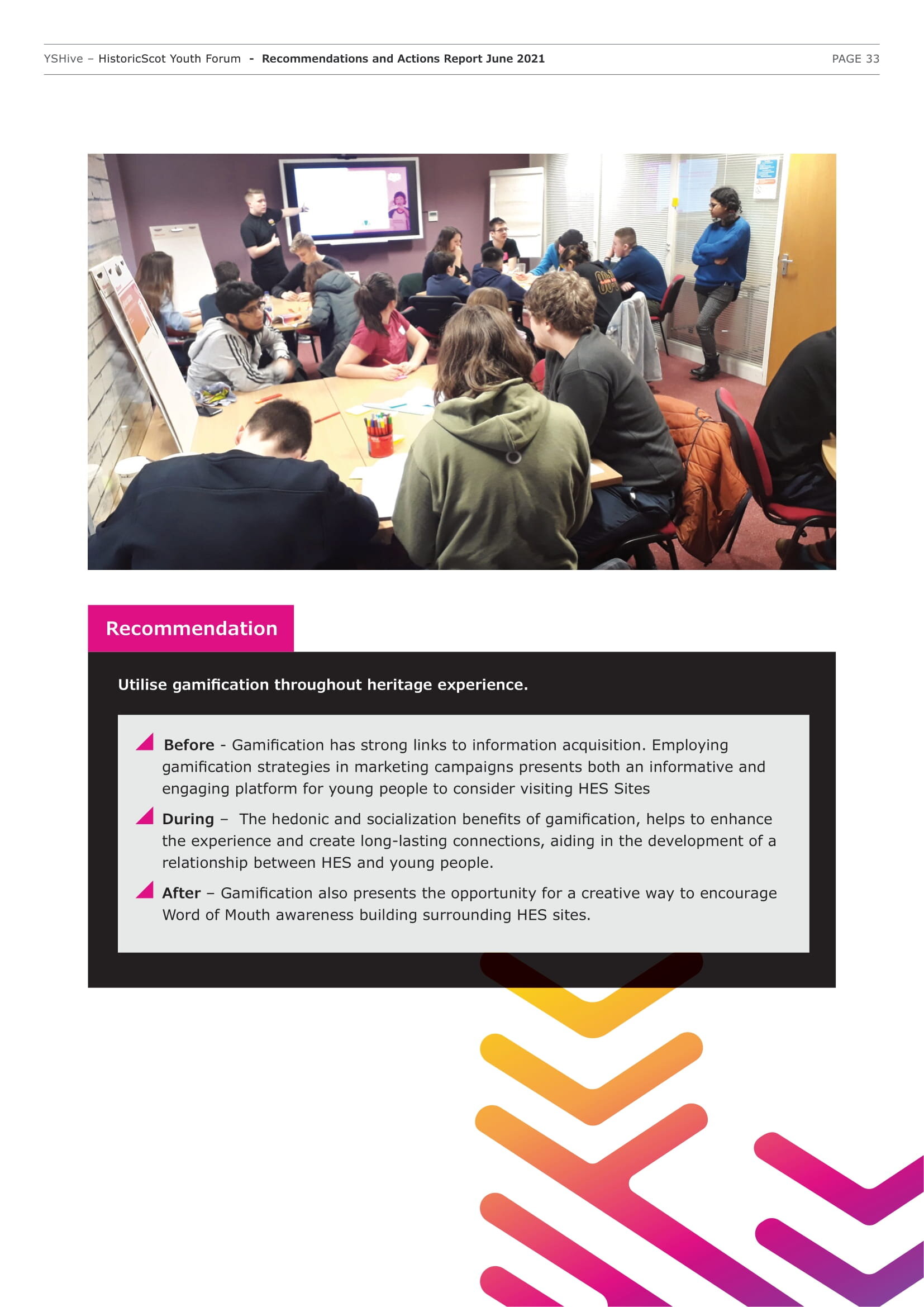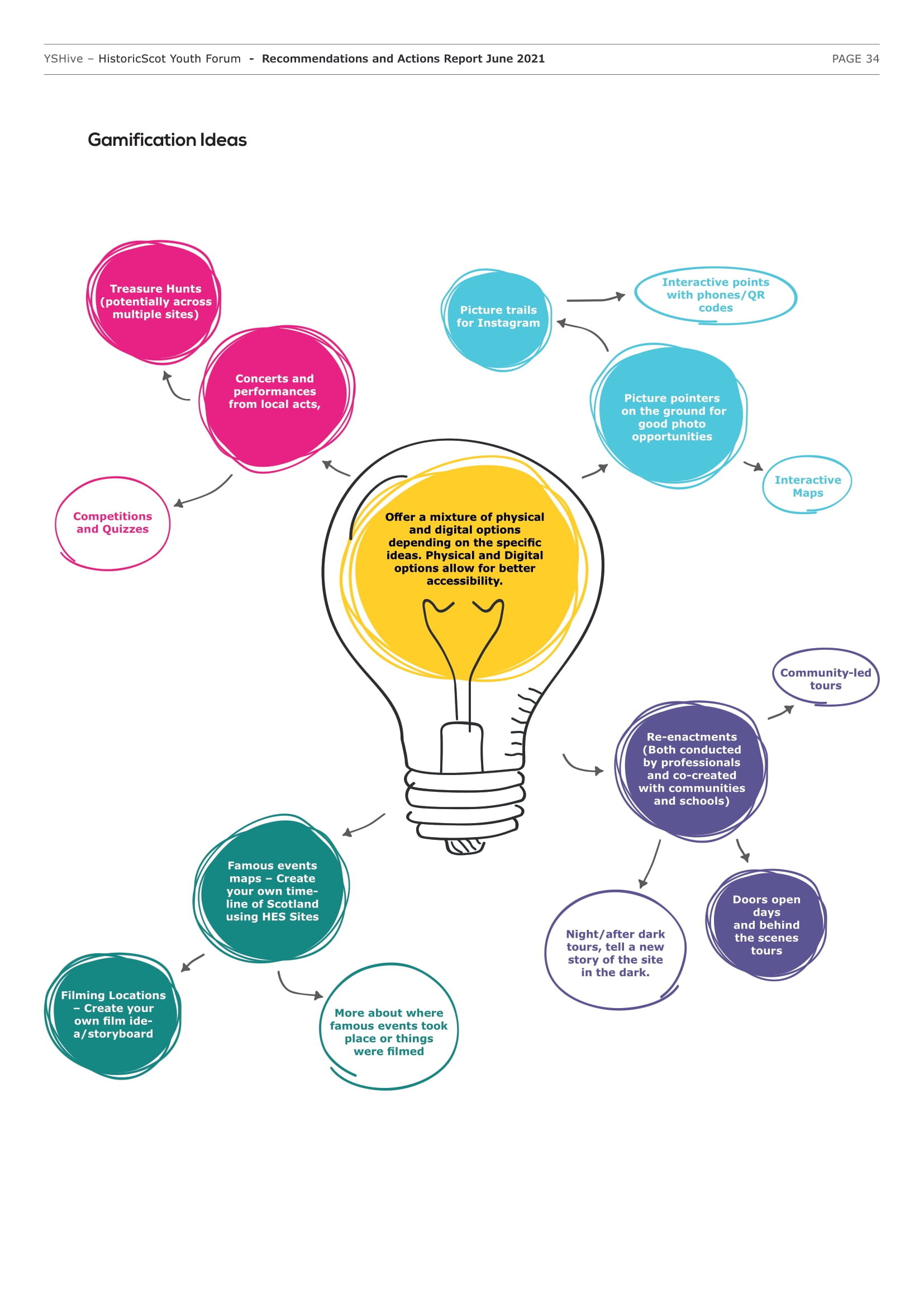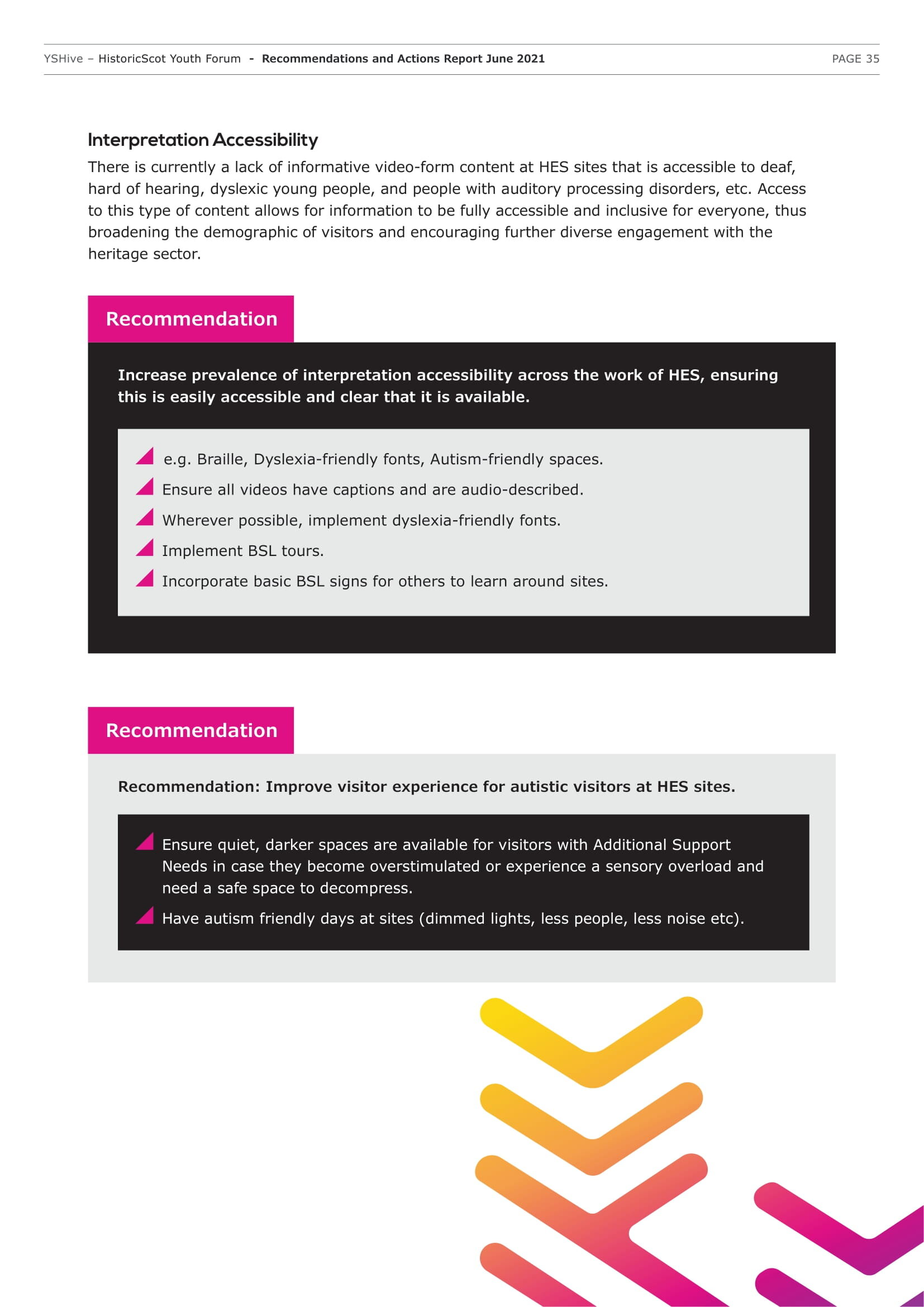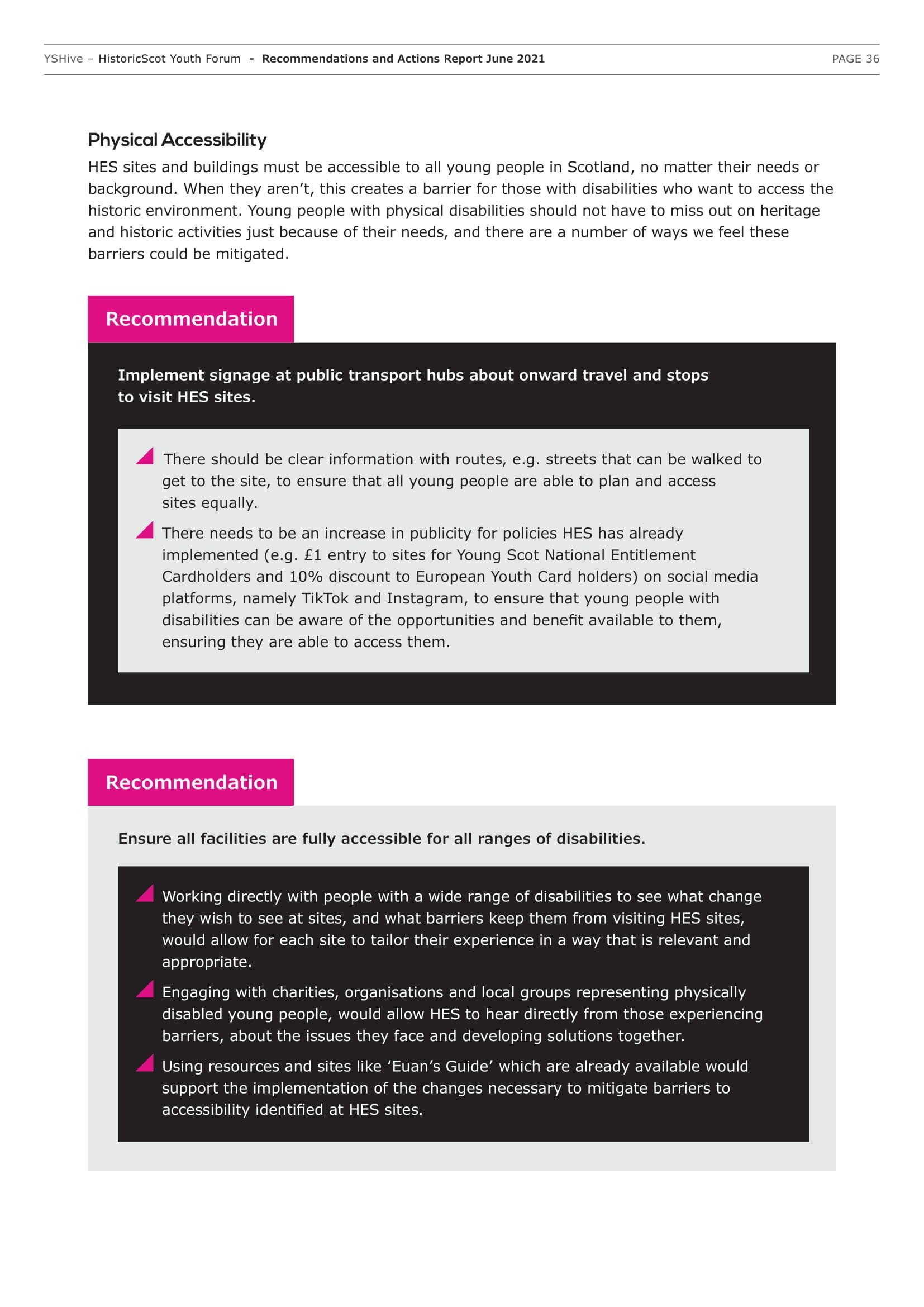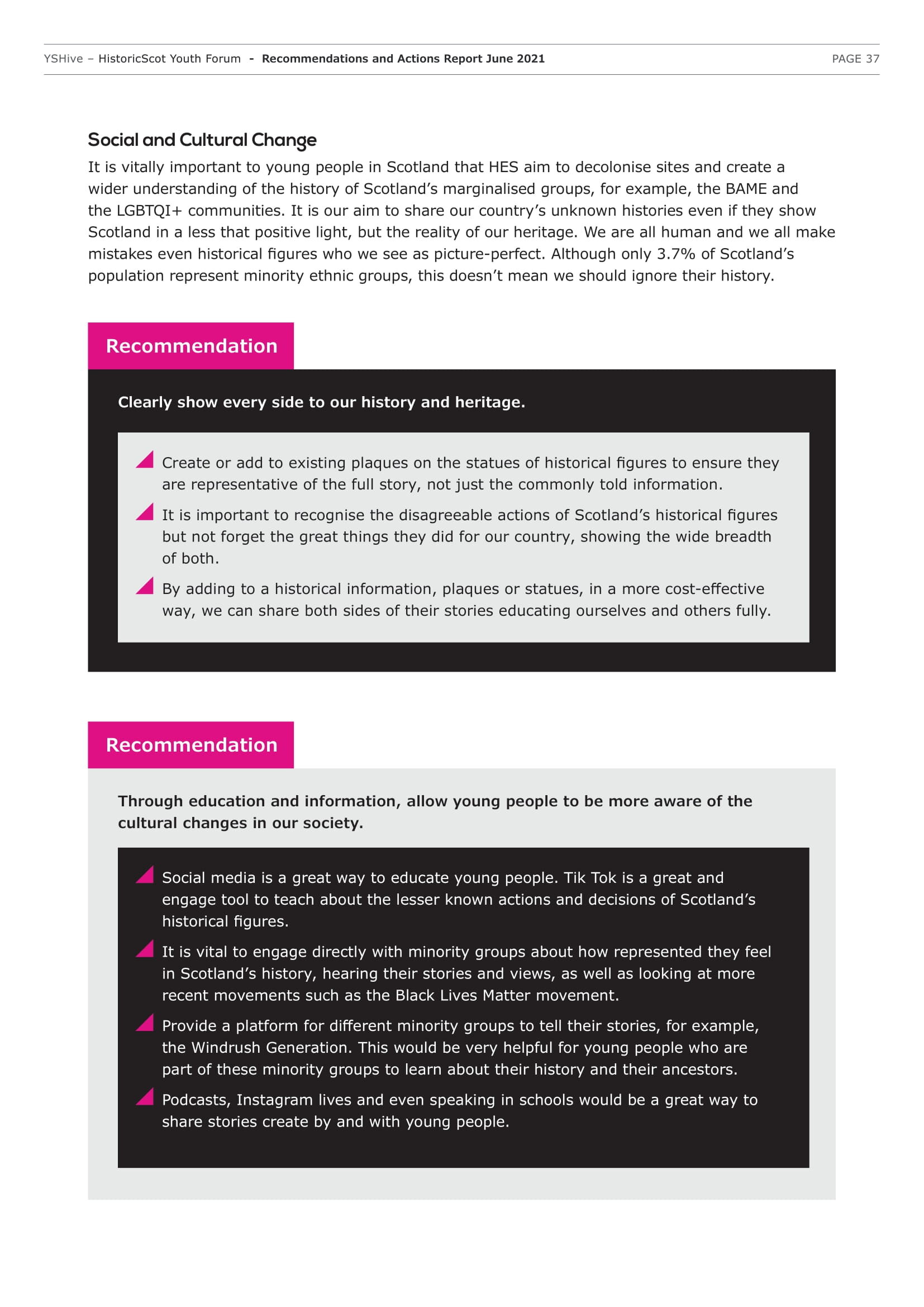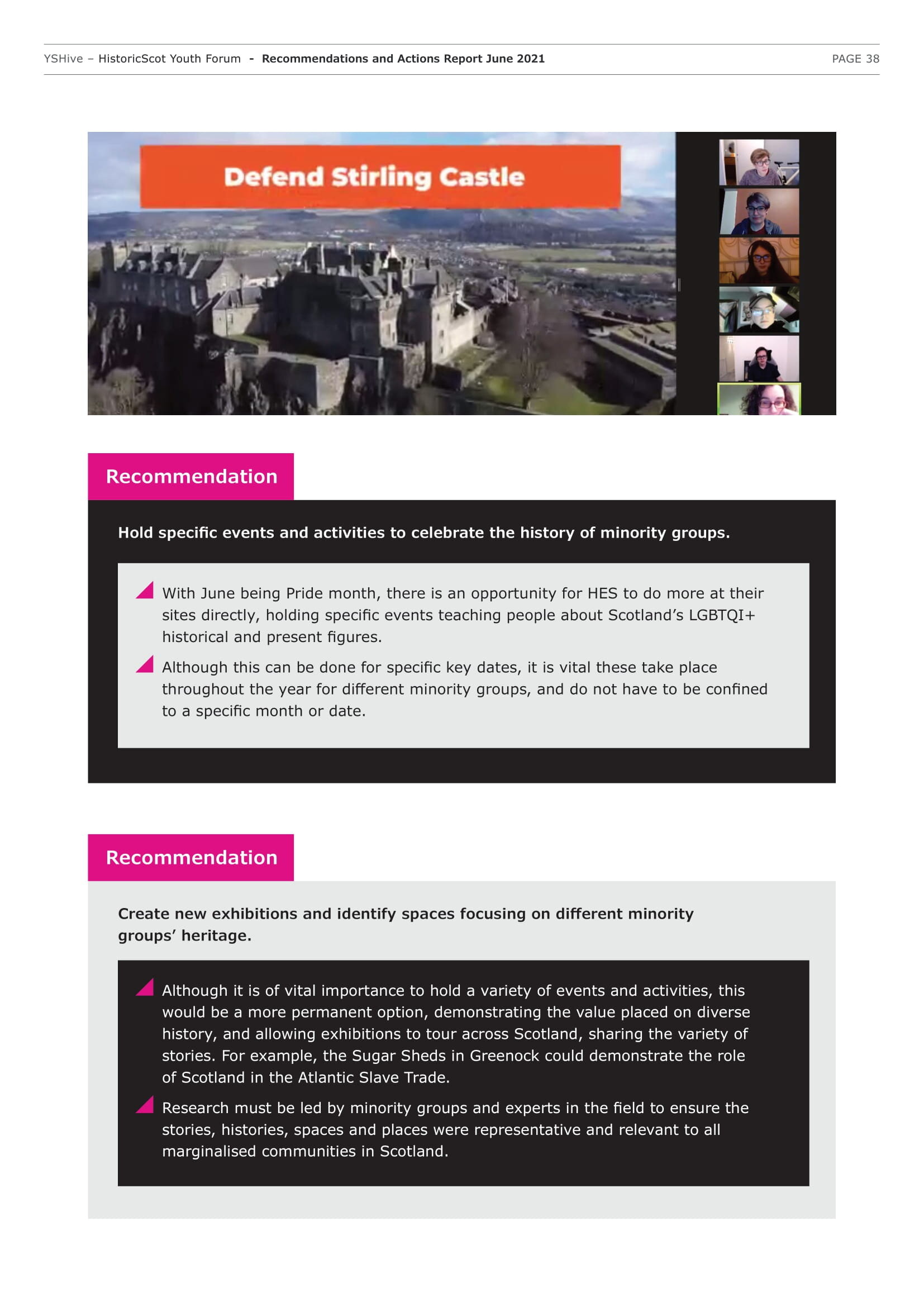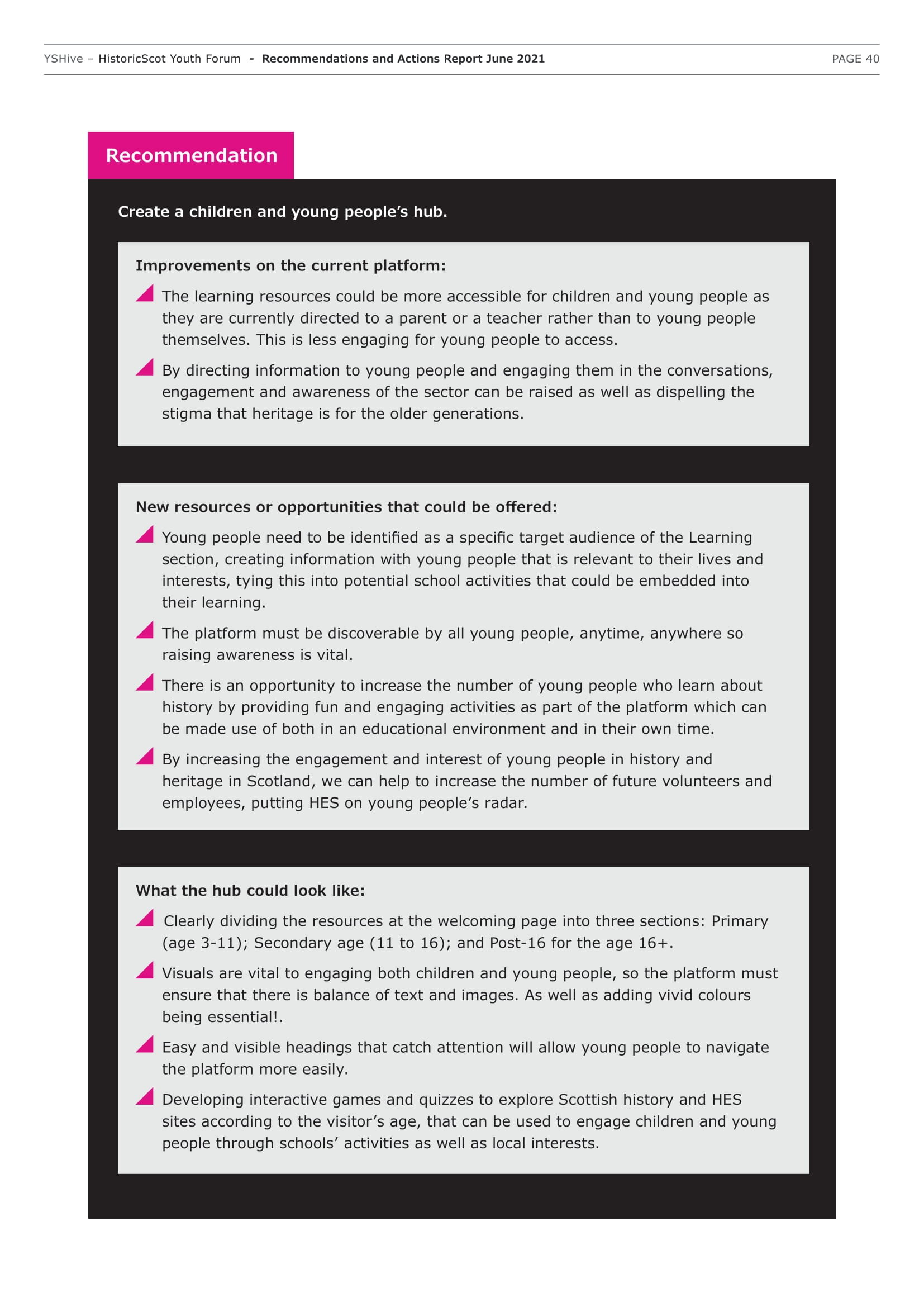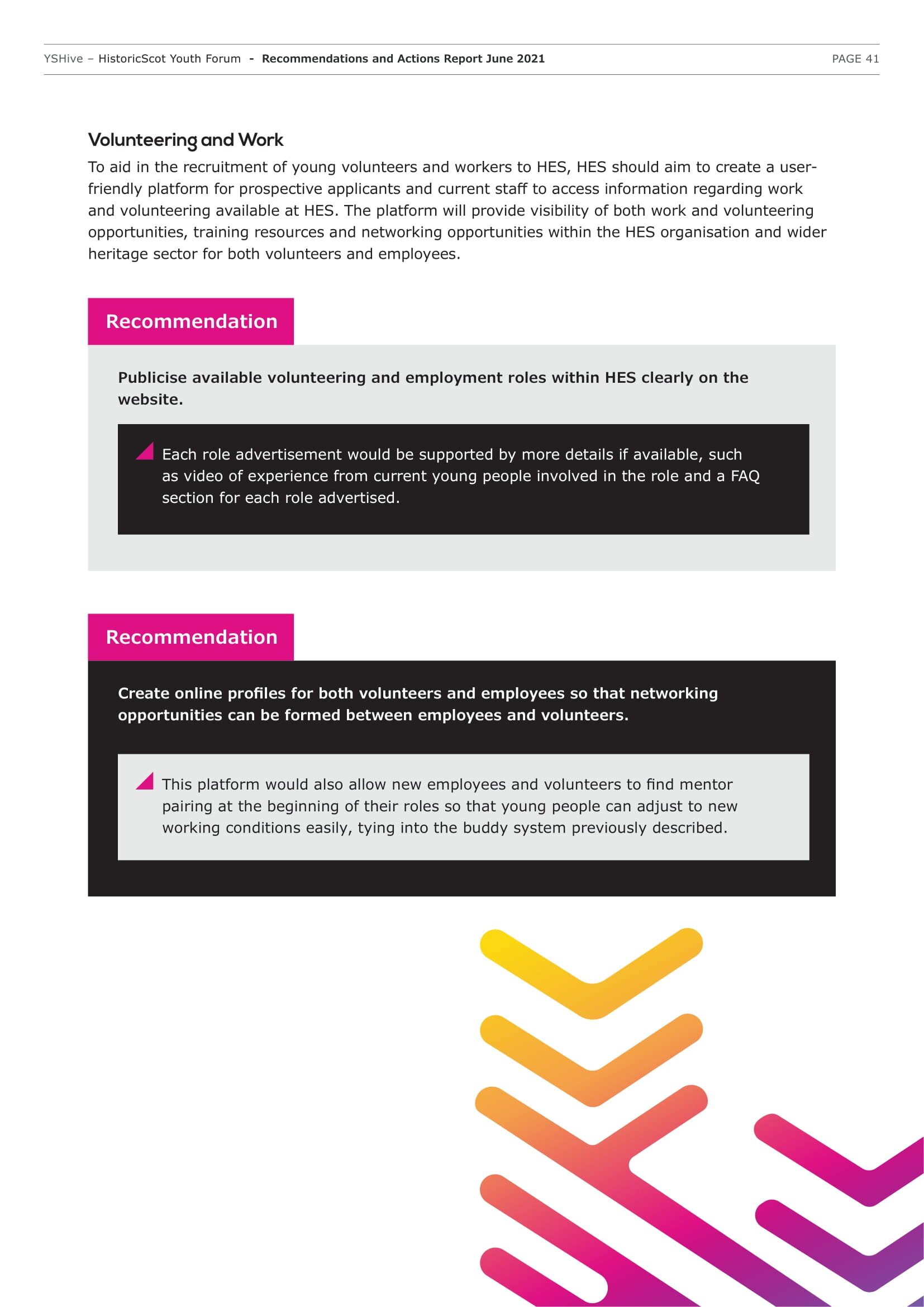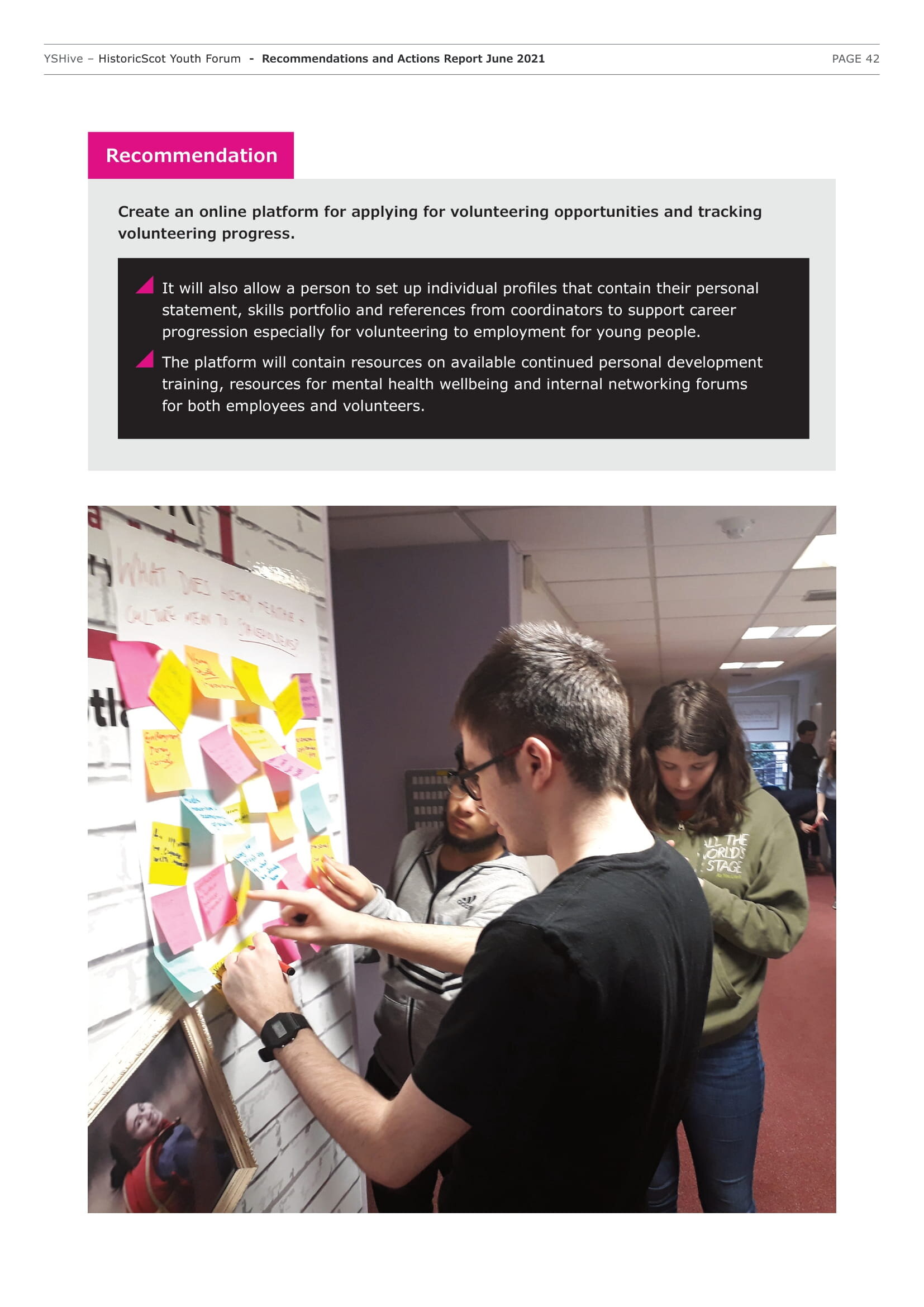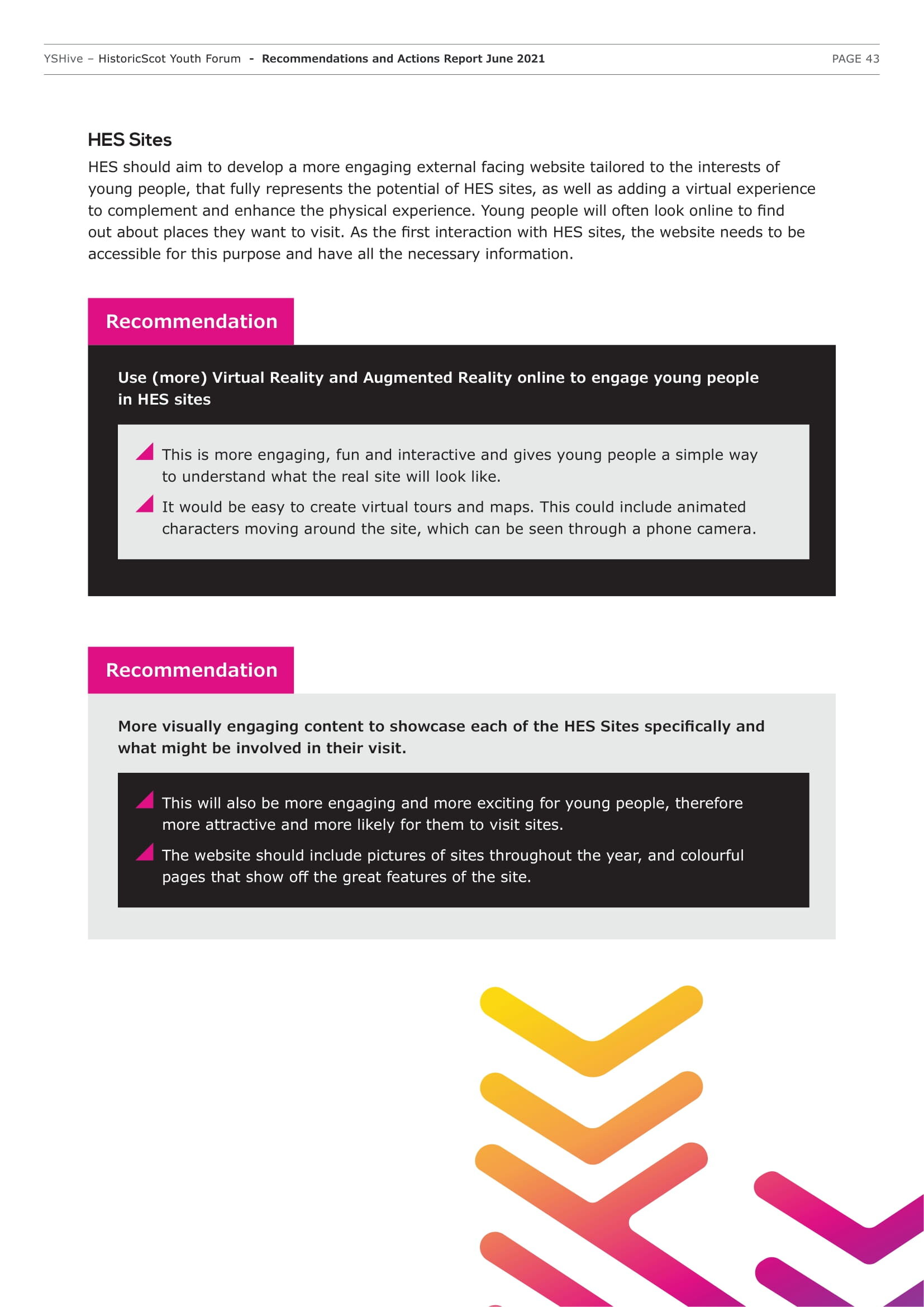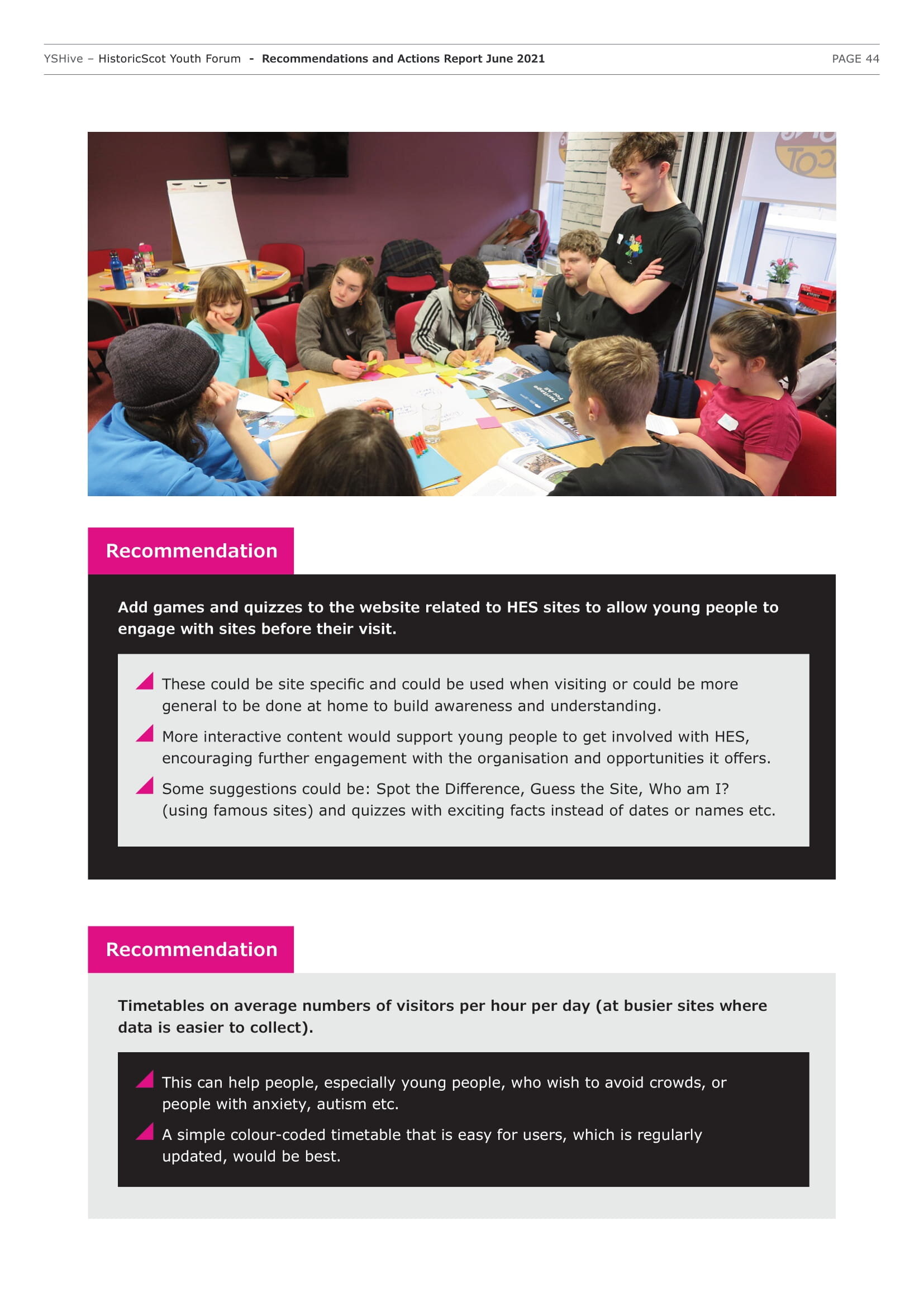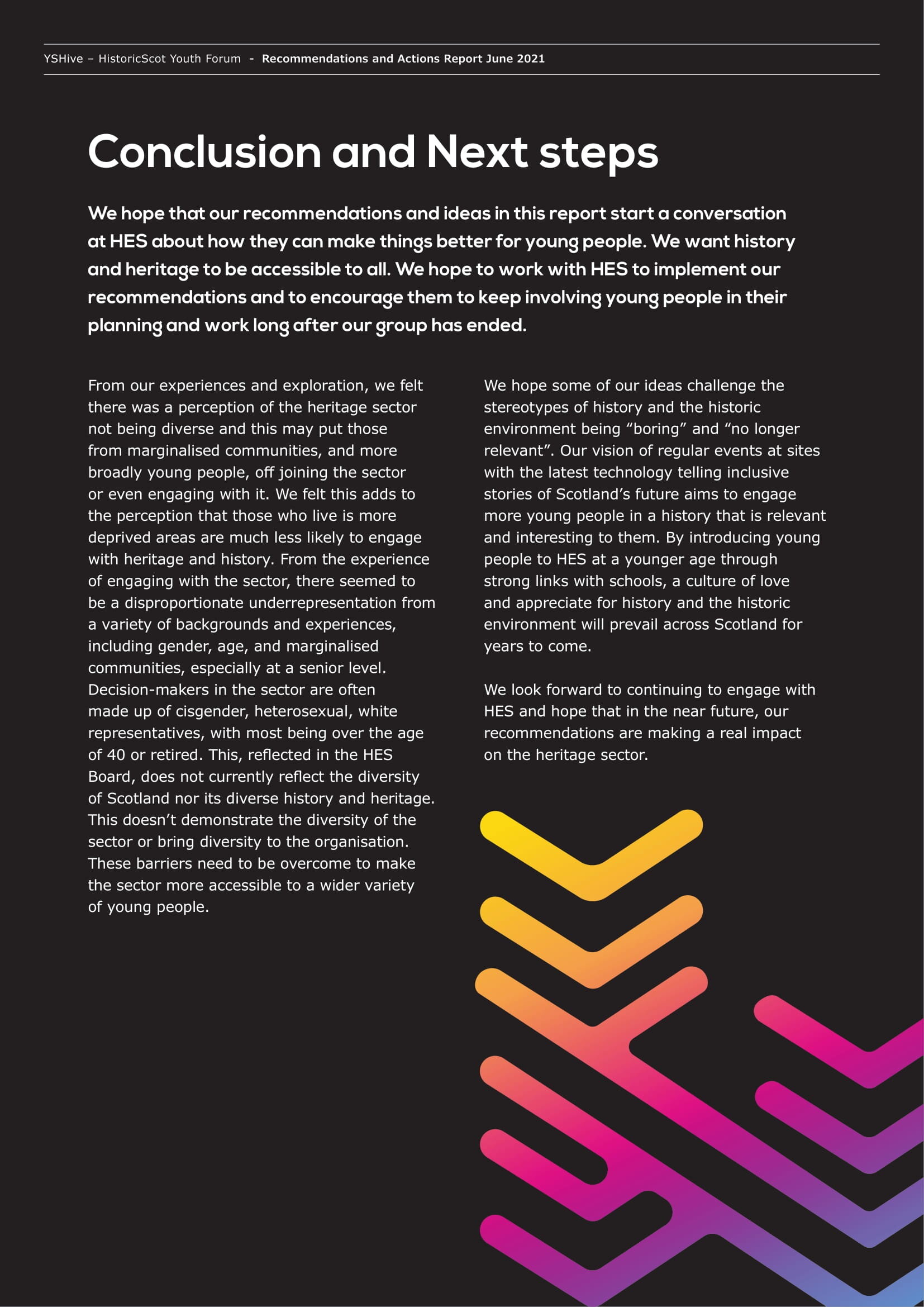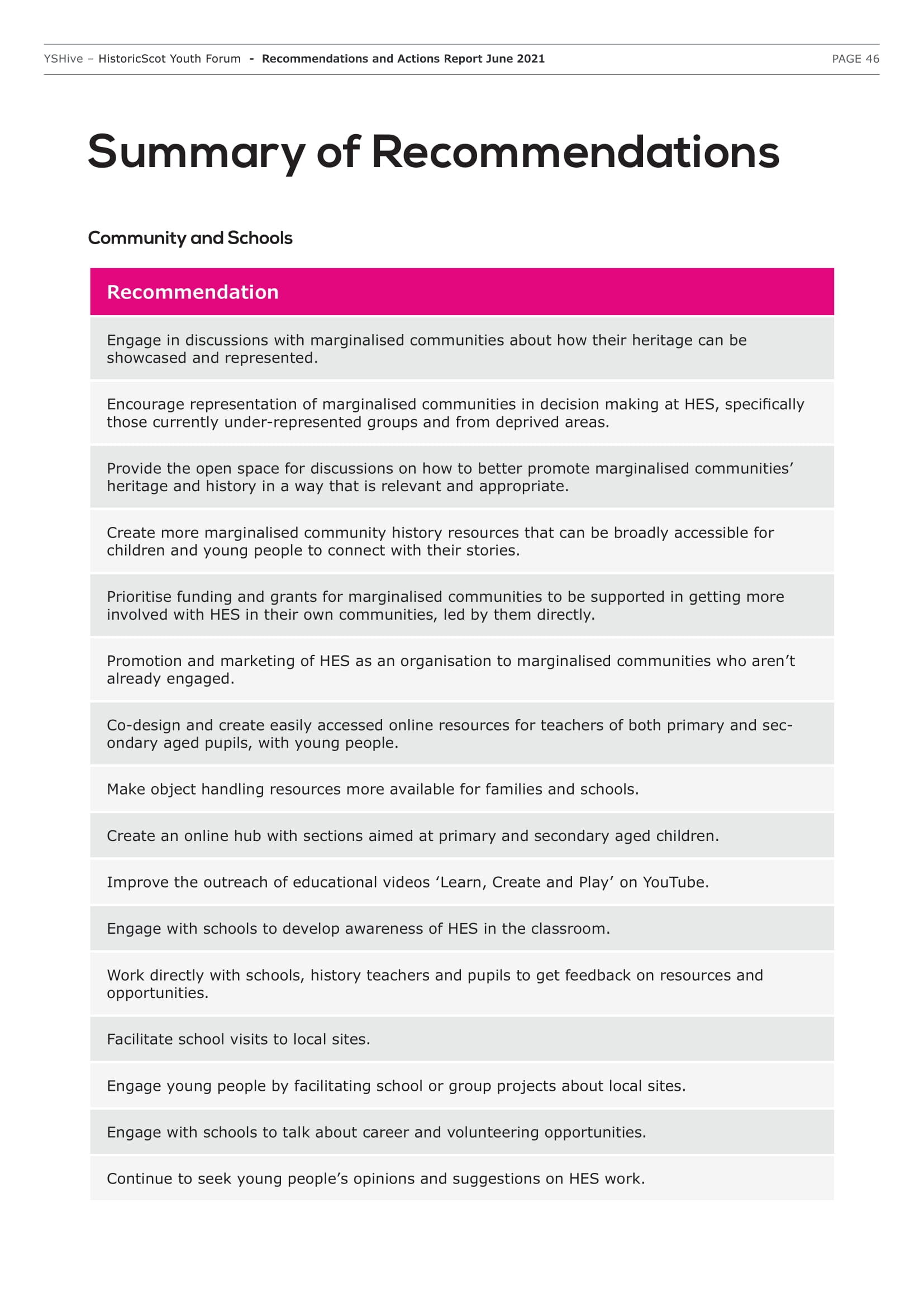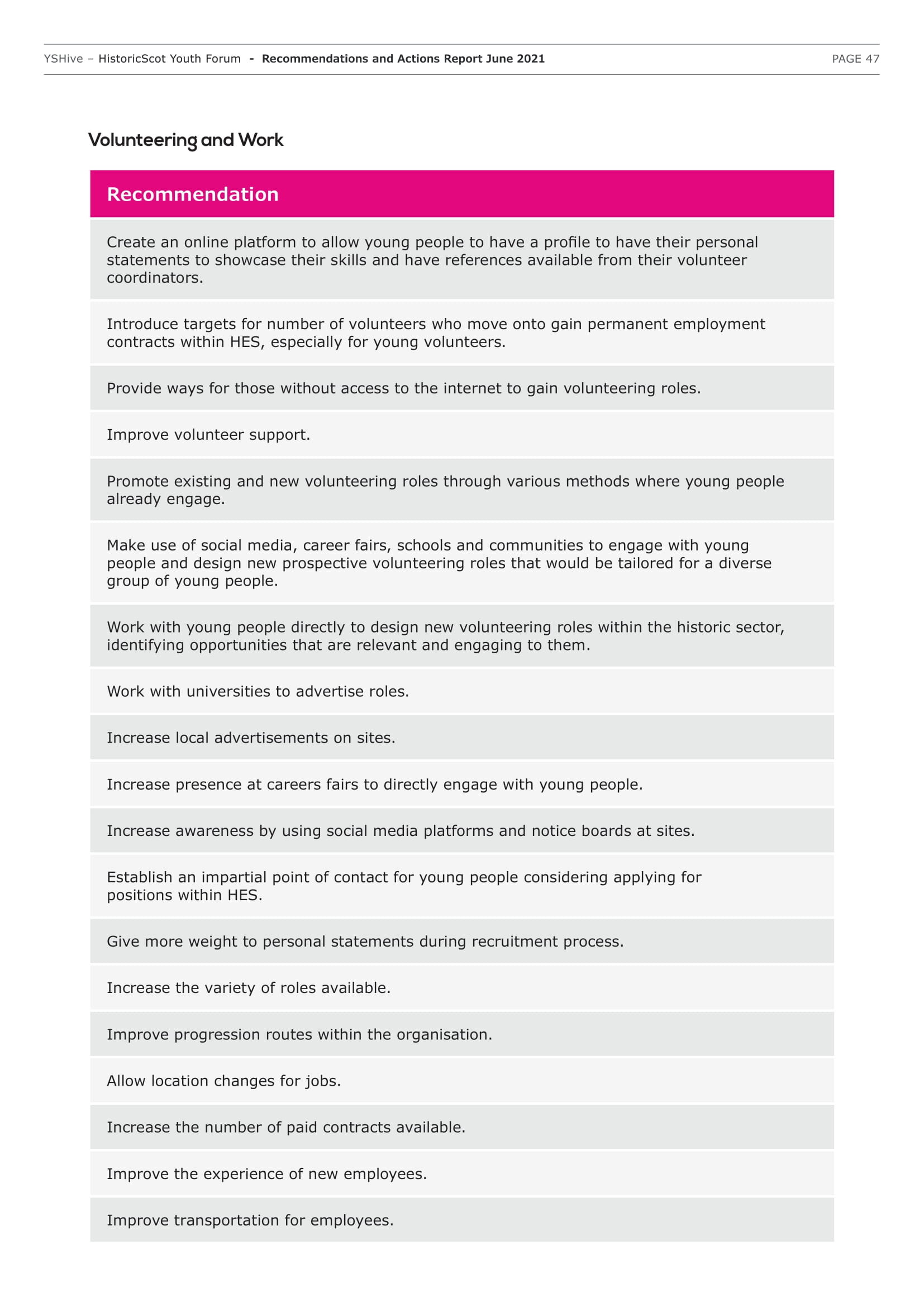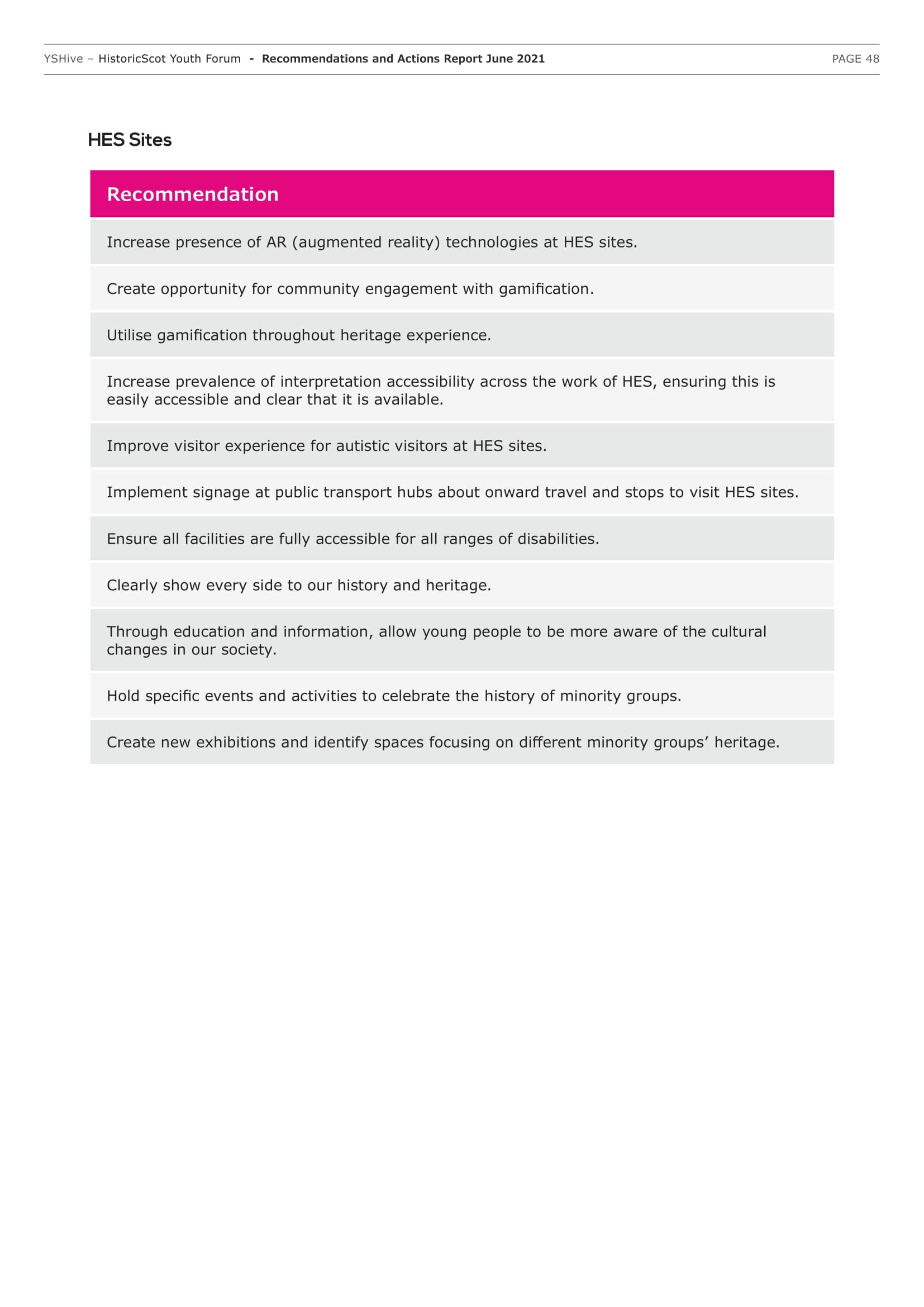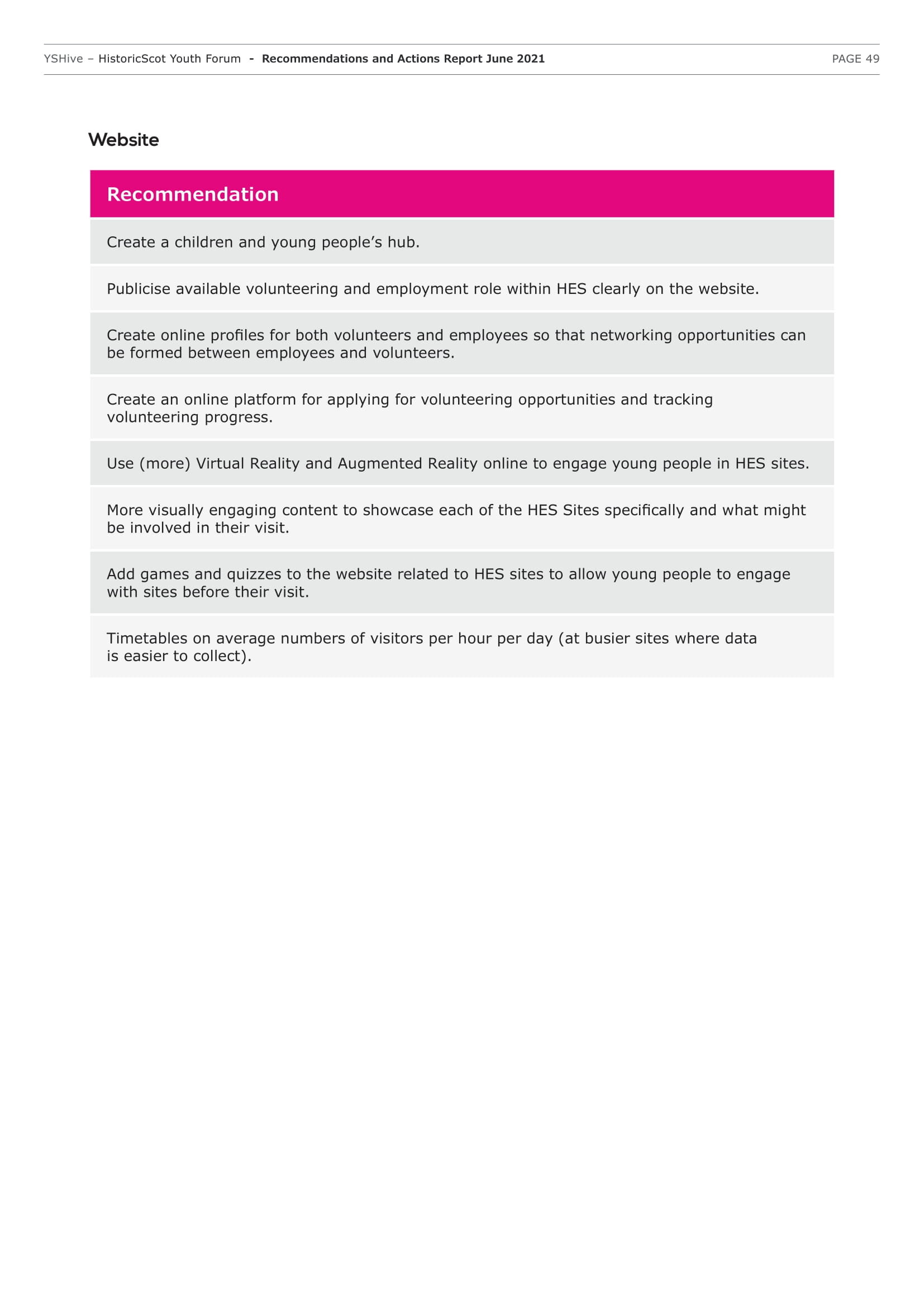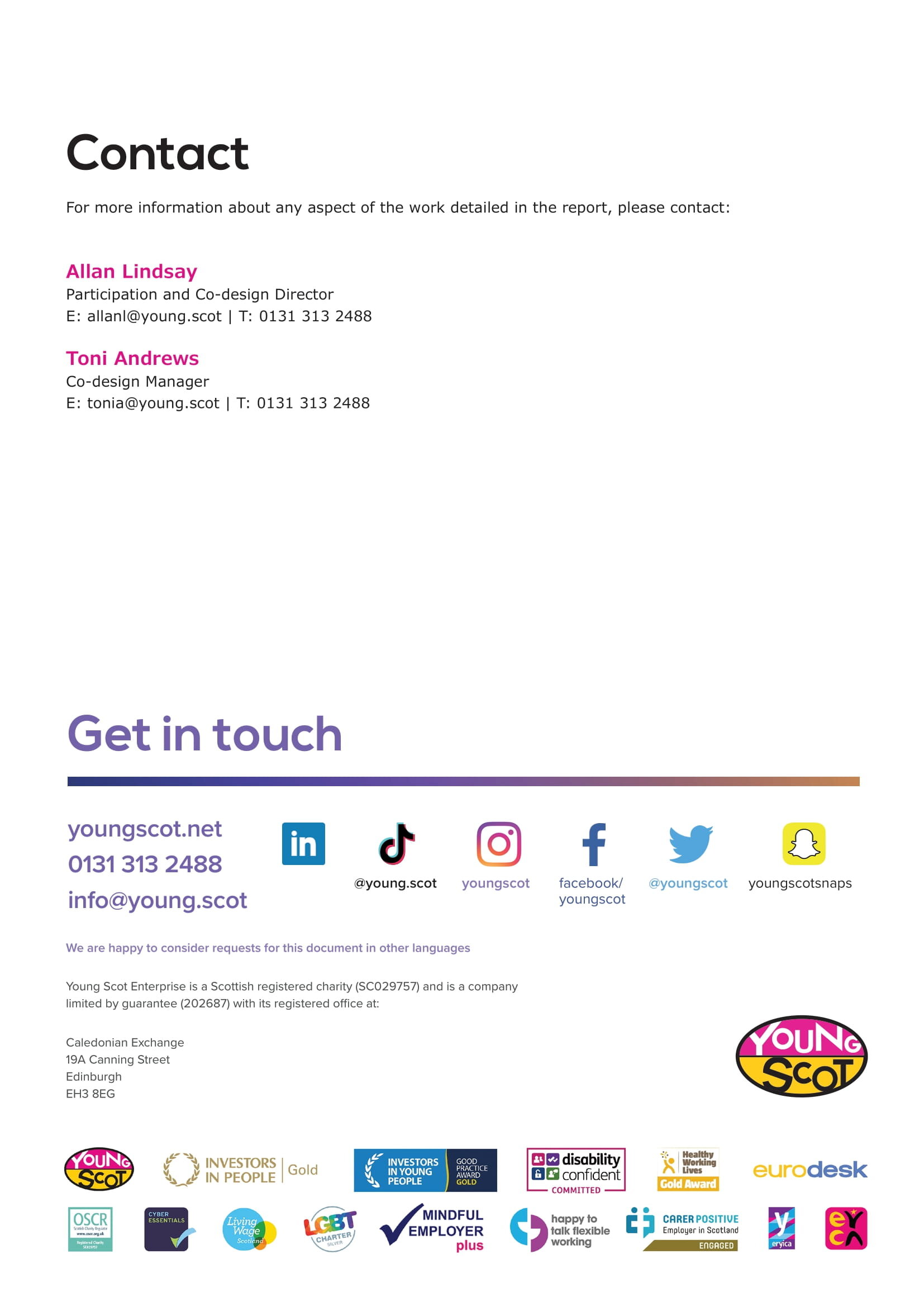Recommendations: HistoricScot Youth Forum
Young Scot and Historic Environment Scotland established the HistoricScot Youth Forum, consisting of 25 young people from a variety of backgrounds across Scotland. The aims of the Forum were to investigate:
how to involve young people in the heritage sector
how to make the sector more accessible for young people
This report details the recommendations from the HistoricScot Youth Forum, with the hope to help shape opportunities for a diverse and inclusive workforce in the heritage sector and increase young people’s interest and involvement in their local heritage.
You can scroll through a preview of our report, download a full pdf version using the Download button or access a plain text version of our report below.
Plain Text Version
YSHive – HistoricScot Youth Forum - Recommendations and Actions Report June 2021 PAGE 1
HistoricScot
Youth Forum
Recommendations and Actions Report
June 2021
YSHive – HistoricScot Youth Forum - Recommendations and Actions Report June 2021 PAGE 2
Introduction from the
HistoricScot Youth Forum
Our youth forum was not only established
to investigate how to involve young people
in the heritage sector, but also how to make
the heritage sector more accessible for
young people. We worked with Young Scot
and Historic Environment Scotland to create
recommendations on how to make the heritage
sector more reflective of young people’s
needs and our society. It was particularly
important to us to increase the opportunities
for young people of all backgrounds. We
hope our recommendations will help shape
more opportunities for a diverse and inclusive
workforce in the heritage sector. We also hope
it will enable more young people to become
interested and involved in their local heritage.
Heritage and its conservation has always been a multi-generational issue. However,
in the past, young people have often been excluded from this conversation.
The establishment of the HistoricScot Youth Forum aims to tackle this problem
and actively include young people in the decision-making of what is next for Scotland’s
heritage. After all, even the present will one day be heritage and we owe it to future
generations to preserve it to the best of our ability.
YSHive – HistoricScot Youth Forum - Recommendations and Actions Report June 2021 PAGE 3
Meet the Team
Tom, 14, Edinburgh
“My dad saw it being advertised on a
school Facebook and I thought it looked
really fun and interesting, so I decided
to give it a shot, and step outside of
my comfort zone”.
Emily, 22, Edinburgh
“I signed up for the Youth Forum because
I love history and have been a long-term
member of Historic Environment
Scotland. I wanted to help contribute to
their future events/plans and learn more
about the internal running’s of the
organisation”.
Beth, 17, Glasgow
“I wanted to be able to contribute to
future events within HES, as well helping
to bring people into HES sites. This group
also gave me the opportunity to step
outside my comfort zone and talk to
other people around Scotland who are
also interested in History”.
Charlotte, 21, Edinburgh
“I got involved because I love history!
I’ve always loved visiting castles and
other historic sites, so it seemed like a
great way to become more involved in
the industry”.
YSHive – HistoricScot Youth Forum - Recommendations and Actions Report June 2021 PAGE 4
Meet the Team
Robyn, 20, South Lanarkshire
“I’m a History undergraduate student
and I’ve always been passionate about
the historic environment. I wanted to
help make it better reflect and engage
young people from diverse communities
in Scotland”.
Luke, 21, West Lothian
“Having worked in the heritage sector I
have seen the barriers that young people
face looking to enter it, therefore I
wanted to share and implement some of
my ideas to help solve these issues”.
Leyla, 23, Fife
“I’m just about to qualify as a history
and modern studies teacher and jumped
at the chance to apply for the project.
I’m very passionate about history and
the environment generally as well as
current affairs”.
Abdullah, 21, Glasgow
“Before COVID hit, I was doing
backpacking trips in the UK and was
intrigued by the different places for
tourism so this opportunity to learn more
about the historic sites and tourism,
while volunteering, was not one I was
going to miss!”.
YSHive – HistoricScot Youth Forum - Recommendations and Actions Report June 2021 PAGE 5
Meet the Team
Maia, 19, Orkney
“I got involved as I believe that it is the
right of every child to access local and
national history, and I aim to use my
knowledge and experience from being
disabled to create fully accessible
historical areas”.
Catriona, 13, Edinburgh
“I got involved with the project because
I love history and heritage! I want more
people to get involved and excited about
it, particularly young people. The project
was also a great opportunity to meet
more people who share my passion and
develop my skills and knowledge
of the sector”.
Alice, 23, Stirling
“My Masters research concentrated on
how the tourism industry can employ
new strategies and activities to increase
levels of engagement especially within
younger age groups. I wanted to share
the knowledge and insights I gained
through my research with others and the
HistoricScot Youth Forum provided me
with a perfect opportunity to do so”.
Anjali, 15, Renfrewshire
“I wanted to learn more about the
country I live in and find out what I can do
to make it better. I was also interested to
share my knowledge on the lesser known
parts of our history that were covered up
e.g. The Atlantic Slave Trade and getting
involved in the youth forum allows me to
share my ideas on how HES can change
how we see our past”.
YSHive – HistoricScot Youth Forum - Recommendations and Actions Report June 2021 PAGE 6
Meet the Team
Kirsty, 23, Aberdeen
“I got involved in the HES project
because I have previously worked in the
heritage and tourism sector and know
that it has so much to offer young people
but can find that hard to communicate
and realise. I hope that by getting
involved in this project I will have helped
open up HES to be more accessible to
many more young people”.
Joshua, 19, Fife
“I found out about this opportunity from
a friend and I decided to apply because
I have always enjoyed history and how
it affects our lives in the present”.
Orla, 13, Fife
“It has been an amazing time learning
how climate change is affecting our sites
and how a lot of young people don’t
know about it or the sites. I also have
worked with Young Scot before for the
Year of the Young People 2018 and I
loved it so when this came up, I was
so excited”.
Elise, 14, Inverness
“I found out about this project from a
teacher and after my interview I knew I
wanted to be involved! Young Scot and
HES are such great organisations and the
opportunity to work with them both and
potentially make a really positive impact
is one I am very grateful for!”.
YSHive – HistoricScot Youth Forum - Recommendations and Actions Report June 2021 PAGE 7
Meet the Team
Megan, 24, North Lanarkshire
“The chance to work on a group project
with other young people and getting
to talk to those already working in
heritage was a huge draw for me. The
collaborative nature of this project really
appealed to me and allowed me to learn
more about Young Scot in the
process too”.
Cameron, 26, South Lanarkshire
“The reason why I chose to apply for
the project is because I knew a little bit
about HES, and I have been to a few
HES sites, but I did not know the History
behind them”.
Cara, 23, Moray
“After moving to Scotland to study
history and archaeology, I fell in love
with Scotland’s heritage and wanted to
contribute to its conservation. It has
been great to be able to express the
opinions of young people and ideas for
the future of Scotland’s heritage sector”.
Marion, 21, Aberdeen
“It was great to work with motivating
people, and although online, I hope
our ideas will contribute to making real
changes for young people’s discovery of
the Scottish national heritage”.
YSHive – HistoricScot Youth Forum - Recommendations and Actions Report June 2021 PAGE 8
Meet the Team
Chase, 22, Aberdeenshire
“Throughout my time volunteering
with the youth forum, my focus has
shifted to what is available around me
and telling the stories of local history
and heritage rather than a sole focus
on far-off lands”.
Hannah, 22, West Lothian
“I’ve always had an interest in History
and I’m currently studying Heritage and
Tourism at University. I grew up visiting
Historic Scotland sites with my family.
They’re such a big part of my life and
it’s always sad when people see them as
boring, irrelevant or simply don’t have an
interest in them. I wanted to volunteer
my time to this project to help introduce
and build on new ideas to help these
sites appeal more to my generation. Plus
It’s always a bonus to make new friends.”
Over the course of the HistoricScot Youth
Forum project, 31 young people contributed
aged between 13-26 years old. Of those 31
young people, 19 identified as female, 11
identified as male and one identified as
non-binary. Six of the young people identified
as LGBT; four young people came from BAME
backgrounds; six young people stated that
they identified as disabled; and two young
people came from SIMD 1 and 2 areas.
The young people came from 15 local
authorities across Scotland: Aberdeen City,
Aberdeenshire, Dundee, Edinburgh, Fife,
Glasgow, Highland, Moray, North Ayrshire,
North Lanarkshire, Orkney, Renfrewshire,
South Lanarkshire, Stirling, and West Lothian.
Julien, 20, Edinburgh
“I have had a real passion for history for
as long as I can remember and saw
historical reenactment for the first time
at a year old. As part of that, over the
years I visited historical sites all over
Scotland and when the opportunity came
up to be a volunteer working with the
organisation that manages so many of
these wonderful places, I decided to
apply. So far it has been an eye opening
experience, and I have really enjoyed
meeting and working with other like
minded people.”
YSHive – HistoricScot Youth Forum - Recommendations and Actions Report June 2021 PAGE 9
Background
About the partnership
Young Scot has been working in partnership
with Historic Environment Scotland (HES)
to support the organisation to widen the
engagement, participation, and involvement
of young people from a range of backgrounds
and experiences in their delivery activity and
decision-making. Throughout the partnership,
HES have been committed to co-design as a
model for including the views, perspectives
and experiences of young people in realising
their strategic vision.
Our 24-month national partnership between
HES and Young Scot established a national
Historic Environment Youth Forum of 25
young people aged 11-25 from a variety of
representative and relevant backgrounds and
experiences across Scotland.
Through the Young Scot YSHive Process,
the group have been collaborating with HES
and the heritage sector to contribute to
the strategic priorities of Our Place in Time
(Scotland’s historic environment strategy),
the objectives of the 2018 Year of Young
People and its legacy, the Historic Environment
Scotland 2019-22 Corporate Plan, and the
Scottish Government’s commitment to
widening engagement, participation and
involvement of individuals and communities,
including young people.
YSHive – HistoricScot Youth Forum - Recommendations and Actions Report June 2021 PAGE 10
HistoricScot Youth Forum Activity
In January 2020 the HistoricScot Youth Forum
were able to hold an initial meeting in person
and meet with the Historic Environment
Scotland team members. We were able to gain
insight into the ‘behind-the-scenes’ of the
heritage sector. This helped us to identify 100
questions, which became the foundation for
our research and discussions.
Despite the COVID-19 pandemic, we were able
to continue working online and meet with more
members of HES. We were introduced to the
existing work HES has done to engage young
people, hearing more about what is currently
taking place and the opportunities coming up.
During multiple meetings with the Directors
and the Senior Management Team, our
questions were explored further. We had some
engaging discussions about our ideas and the
issues we had identified. After our questions
had been explored with the HES team, we
wanted to know more about what other young
people thought about the heritage sector. We
created a series of Instagram questions and
a detailed survey to hear more from other
young people in Scotland. The activities were
successfully delivered, and the results helped
us to gain a better understanding of young
people in Scotland’s concerns.
In December 2020 we established three
working groups to further develop our
ideas. These are: Community and Schools,
Volunteering and Work and HES Sites.
Each working group have also come up with
recommendations for the Website. We have
been working within our working groups to
create recommendations and actions based
on our discussions, which we think will help
HES with the engagement of young people
and support young people to engage with the
heritage sector.
Over the past 18 months, we have had
plenty of long Zoom meetings, thorough
break-out room discussions, and interesting
presentations from HES. They have all helped
to shape our recommendations and actions for
the future of Scotland’s heritage.
YSHive – HistoricScot Youth Forum - Recommendations and Actions Report June 2021 PAGE 11
What the Youth Forum have
been up to
workshops
with HES staff
9
Survey responses from
young people
140
Group meetings
10+
1000+
Hours
volunteered
Working group
meetings
9
Instagram polls
4
National survey
1
YSHive – HistoricScot Youth Forum - Recommendations and Actions Report June 2021 PAGE 12
Survey Summary
The survey designed and delivered by the HistoricScot Youth Forum, hosted on
www.young.scot, received almost 140 responses from young people across Scotland.
The young people who took part in the survey
covered a wide age range, from 12 to 25
years old. More than half (66%) respondents
identified as female, with 28% identifying
as male and 3% as non-binary. When asked
which ethnic group or background they
identified as, 80% identified as white Scottish
or white British, and a further 14% identifying
as from minority ethnic backgrounds. 18% of
respondents identified that they considered
themselves disabled.
When asked whether they or a member
of their family was a member of Historic
Environment Scotland, 67% of respondents
reported they were not members, however,
35% indicated that they were interested in
becoming a member. In addition, 62% of
respondents also reported that they had not
done anything at school about HES or the
historic environment. Despite this, 82% of
respondents stated that they had an interest in
visiting historic sites in Scotland. The majority
(69%) of respondents said that historic sites
were interesting to them because they wanted
to explore Scotland. A further 69% stated that
historic sites were interesting and enjoyable to
them because they are interested in history.
Young people who were not
interested in visiting historic
sites said it was because they
were “boring”, were “too far
to travel” or because “they
had seen bad reviews”.
Over half of respondents
(57%) stated that they would
be interested in exploring
historic sites in Scotland
online through interactive
digital maps and models.
Respondents stated that
interactive activities, events
and open days would make
them more likely to visit
a historic site, as well as
discounts on admission or
opportunities for free visits.
Nearly three quarters of respondents (73%)
had never considered a career in the historic
environment before. The jobs that respondents
were the most interested in discovering
were telling stories at historic sites, visitor
experience at sites and site preservation.
Nearly half of respondents (48%) reported
wanting to visit a historic site but not being
able to due to lack of public transport. A quarter
of disabled respondents reported wanting to
visit a historic site but being unable to due to
their disability. This was particularly true of
wheelchair users and those with autism.
YSHive – HistoricScot Youth Forum - Recommendations and Actions Report June 2021 PAGE 13
Theme: Community
and Schools
For most young people, school is the first time they will engage with heritage and
the historic environment. From our experiences, if you engage with the historic
environment during education, you are more likely to engage in your adult life.
As part of this, we felt strongly about the emphasis on engagement with people
from all backgrounds. By being inclusive and incorporating everyone, the history
we make, and the heritage we remember now, will be a better one.
Our recommendations for Community and
Schools are not only based on our experiences
but on the view of other young people too,
from the results of our findings through our
digital survey and Instagram poll questions. The
majority (62%) of respondents stated that they
had not done anything at school with or about
HES or the historic environment. Young people
stated they would like more school trips to HES
sites or visits from HES staff as this would make
them more likely to visit a historic site. Nearly
half (47%) of participants found historic sites
interesting or enjoyable because they enjoyed
finding out about their local area and feeling
a connection to their heritage. This shows the
importance of community links for HES.
Our Instagram poll found that 32% of
respondents didn’t feel a connection to historical
places in Scotland. Our survey told us that some
young people instead connected with the history
of marginalised groups, such as women or LGBT
people, with one survey respondent noted
“there is very little history
of LGBT members - even
though it is known that many
significant members of
Scottish history were queer.”
HES’s social media use and platforms were
identified as a real opportunity to engage more
broadly with young people and communities
directly. Many young people use social media
as their primary way to access information from
organisations. This means that if young people
are not already connected to HES platforms,
they may miss out on opportunities, news and
events. We also identified HES website’s as an
opportunity to further engage with young people
in spaces they already use, with opportunities
for sharing information for communities and
schools as part of this. By focusing resources
and recognising this would require public facing
staff capacity in the outreach and learning team,
there are opportunities to expand and make use
of the community and education engagement.
Many of the available resources are aimed at
primary school aged children, with very little
for secondary school aged young people and
older. Without this direct focus, young people’s
awareness of the organisation is an untapped
opportunity, with low levels of awareness about
HES as an organisation in schools, as well as the
sites that they manage. From the experience of
the group, we felt that it isn’t always clear which
sites HES own or maintain, which could be an
opportunity for building awareness and further
engagement. It was clear that with a lack of
awareness there is a reluctance to support and
engage with the organisation as many believe it
is fully publicly funded.
YSHive – HistoricScot Youth Forum - Recommendations and Actions Report June 2021 PAGE 14
Marginalised Communities
HES as an organisation and in its sites/buildings should reflect the diversity of Scotland’s marginalised
communities and their histories and heritage. It should be a priority for HES to make sites and the
buildings that they manage more overtly reflective of marginalised communities’ histories in Scotland.
Recommendation
Engage in discussions with marginalised communities about how their heritage can be
showcased and represented.
Research about history and heritage should be done with marginalised
communities, not about them, to ensure it is representative and tells their stories
from their perspectives.
HES should look to specifically encourage young people from marginalised
communities to volunteer with HES, creating an inclusive and welcoming
environment, open to learning and change.
There should be a specific effort to create a more diverse HES board that reflects
the diversity of Scotland today, to ensure decisions are being led by those with
lived experience.
Conversations around marginalised communities’ histories in Scotland’s national
history should be encouraged and actively promoted across all work.
YSHive – HistoricScot Youth Forum - Recommendations and Actions Report June 2021 PAGE 15
Recommendation
Create more marginalised community history resources that can be broadly accessible
for children and young people to connect with their stories.
Resources should be created and disseminated to encourage wider engagement,
revolving around the LGBTQ+ community, ethnic minorities, minority religious
groups etc. in Scotland
Resources specifically around for Black History Month, LGBT History Month etc.
should be created with young people, showcasing their experiences and views
Resources made for a variety of school levels should be created with young
people, providing learning packs for teachers to use around marginalised
histories (including LGBT History Month etc.), to ensure the stories are accurately
represented
HES should support marginalised community histories projects for schools,
providing the space for investigating local links between HES sites and buildings
and marginalised communities; as well as school projects on communities of
colour’s histories in Scotland etc.
There needs to be an increase in broader opportunities for marginalised
communities to get involved and tell their own histories and stories in Scotland.
Recommendation
Prioritise funding and grants for marginalised communities to be supported in getting
more involved with HES in their own communities, led by them directly.
Membership funding should be available for those from marginalised communities,
specifically in deprived areas, to promote engagement and awareness.
Create opportunities for those from marginalised communities to partner with HES
and lead on research and projects led by their communities.
Ensure the preservation of buildings and history of importance for minority
religious groups, representing their stories for future generations.
YSHive – HistoricScot Youth Forum - Recommendations and Actions Report June 2021 PAGE 16
Recommendation
Promotion and marketing of HES as an organisation to marginalised communities
who aren’t already engaged.
Better publicity of already existing resources and projects involving marginalised
communities, e.g. HES’s digital archives.
Creating targeted events and activities around specific marginalised communities’
histories for all young people to engage in and learn about the variety of the
heritage across Scotland.
Promote HES as an organisation and the opportunities it can provide, rather than
“just a tourist organisation” to better engage a variety of communities, and being
actively transparent about the work HES does.
across all work.
YSHive – HistoricScot Youth Forum - Recommendations and Actions Report June 2021 PAGE 17
Schools Engagement
HES has a good opportunity to create links with schools local to their sites in order to increase
engagement. Creating strong partnerships with schools is beneficial for both HES and the school.
HES can access a large number of young people by engaging better with schools.
Recommendation
Engage with schools to develop awareness of HES in the classroom.
Ensuring that resources that have already been developed from the Outreach and
Learning team are available to schools, and that links with teachers and schools
locally are created and supported to ensure young people have access to engaging
and relevant information. For example, during a lesson about the battle of Stirling
Bridge, ensuring that links to HES are clear in their management of Stirling Castle.
Raise awareness and create links to local sites that schools could easily visit and
do projects around, ensuring that relationships are maintained and developed to
identified opportunities.
Recommendation
Work directly with schools, history teachers and pupils to get feedback on resources
and opportunities.
When developing resources whether online or physical, working directly with those
engaging with them is vital, both through teaching staff and young people.
Identifying more opportunities to engage directly with school pupils to share
information about career and volunteering opportunities with HES.
Continue to seek young people’s opinions and ideas on the work HES
delivers and resources created.
across all work.
YSHive – HistoricScot Youth Forum - Recommendations and Actions Report June 2021 PAGE 18
Recommendation
Facilitate school visits to local sites.
Many schools are visiting the same popular sites (e.g. Edinburgh or Stirling
castles), leaving local sites of potential interest aside.
Facilitating school projects linked with local sites can add to the visit and
learning offer.
Mentioning the work of HES for the preservation of the Scottish heritage
during a site visit will increase HES’ reach.
Recommendation
Engage young people by facilitating school or group projects about local sites.
Young people could create a project about a local site, historical period or event
and display their work as part of a temporary exhibition in this site.
This would also help local HES sites to be better known by young people.across all
work.
Recommendation
Engage with schools to talk about career and volunteering opportunities.
Many children do not know about careers in history, cultural heritage, conservation
etc and are not aware of any volunteering opportunities.
Local volunteers could go to schools and present their work with videos/pictures.
Alternatively, this could be mentioned during site visits.
YSHive – HistoricScot Youth Forum - Recommendations and Actions Report June 2021 PAGE 19
Recommendation
Continue to seek young people’s opinions and suggestions on HES work.
This could be done by organising online polls, receiving feedback from them after
a site visit (What did they enjoy the most? What could have been better? Did they
know HES before? Are they interesting in volunteering in the future?).cwork.
YSHive – HistoricScot Youth Forum - Recommendations and Actions Report June 2021 PAGE 20
Theme: Volunteering
and Work
Volunteering and Work emerged as a theme due partly to many of our personal aims
to enter employment in the heritage sector, and partly due to volunteering being
one of the most important factors in individuals entering into further employment or
engagement with the sector. The two topics were regularly explored during many
of our discussions, and we identified that there was an opportunity to really make
an impact in this area.
We found out that most people who are
volunteering within the heritage sector were
aged 35 and up, male, non-disabled and from
the least deprived areas of Scotland. We saw
this as an opportunity to get under the skin of
this problem and create recommendations that
would see more diverse representation in those
who take part in heritage volunteering.
Barriers were identified in our discussions,
such as a lack of awareness of the kind of
employment roles HES offers and what people
do in these roles, that the advertising of both
volunteering and paid roles were not always
easy to find. It can often be difficult for young
people to physically get access to HES sites
in order to work or volunteer. This and more
highlights that this is an important theme that
affects young people and their engagement
with heritage. We saw it as something we
should address to discover opportunities to
disrupt the way things are currently done and
to improve on youth engagement for the future.
Our survey aimed to help us understand the
involvement other young people outside our
youth forum have had with HES. We asked the
participants how many had thought about a
career in the heritage sector and which jobs
would appeal to them. The second question
about different jobs allowed multiple answers.
Out of the 125 participants, 27.2% of people
expressed interest in working in the heritage
sector. Some people added their personal
experiences with HES had included school visits
and one person said they had done a university
placement. One participant stated they “[had]
no personal experiences since [they] didn’t
hear about [HES] before looking into possible
jobs.” Other people expressed their concerns
about the lack of opportunities for volunteering:
“I have visited multiple HES
sites and would be very
interested in volunteering
there. So far, I have not found
curatorial opportunities at
any of the HES sites”.
YSHive – HistoricScot Youth Forum - Recommendations and Actions Report June 2021 PAGE 21
When asked about specific jobs, participants
overwhelmingly showed an interest in the
heritage sector. Research and Curation was
the most popular reply, with 44%. On-site
visitor engagement was voted the second
most appealing job within HES with 40%.
On-site conservation came third with 33.6%.
Interestingly ‘looking after archives or
collections of old objects’ received the exact
same number of votes as on-site conservation.
A total of 29.6% of participants were
interested in school engagement.
While 27.2% had an interest in IT and
administration roles.
A quarter (25.6%) were attracted to
community engagement.
As much as 24% would consider roles in
site promotion and another 16% were
interested in surveying sites.
Only 16.8% stated no interest in the
listed jobs.
Using an Instagram survey, we discovered that
60% of those who answered would consider
working for HES, and we wanted to discover
more ways in which HES can become more
visible to young people in order to engage the
next generation of heritage professionals.
These recommendations we hope will help
improve this.
YSHive – HistoricScot Youth Forum - Recommendations and Actions Report June 2021 PAGE 22
Volunteering: General
Offering volunteering roles for young people who are passionate for Scotland’s historic environment
provides them opportunities to develop their interpersonal and professional skills, as well as engaging
in the heritage sector from a younger age. The skills and abilities developed from volunteering are
often undervalued due to lack of professional training offered and lack of formal recognition of the
volunteering work, but they provide vital development for young people.
Recommendation
Create an online platform to allow young people to have a profile to have their
personal statements to showcase their skills and have references available from
their volunteer coordinators.
The platform can also be a source to apply for any professional development
trainings when available.
Having access to careers advisors would be very useful for a young person to set
up professional profiles and identify all skills acquired from volunteering.
Recommendation
Introduce targets for number of volunteers who move onto gain permanent
employment contracts within HES, especially for young volunteers.
This will mean volunteers will be encouraged to seek employment at HES or other
heritage, culture and historic site organisations.
This will open up new, easier pathways for young people looking to gain
employment in the heritage sector.
YSHive – HistoricScot Youth Forum - Recommendations and Actions Report June 2021 PAGE 23
Recommendation
Provide ways for those without access to the internet to gain volunteering roles.
A young person with internet access and another without should have equal
opportunities to get new volunteering roles.
Existing volunteering recruitment methods such as emailing or calling or
submitting a paper application should still be an option for those seeking
volunteering opportunities.
Recommendation
Improve volunteer support.
Work with each young person consistently during their volunteering role to explore
the skills developed and to work on new skills that may be gained from existing
roles or from other volunteering opportunities.
This is vital in allowing them to make the most of the opportunities they have
been involved with.
YSHive – HistoricScot Youth Forum - Recommendations and Actions Report June 2021 PAGE 24
Volunteering: Promotion and Awareness Raising
Young people may be unaware of some skills attained through different volunteering roles as they
are not listed on the role description or definitions of skills are unclear to them. They may also be
unaware of volunteering roles due to lack of publicity. By advertising these volunteering roles through
a variety of methods, the roles will be more widely available to a more diverse range of young people.
By working directly and consistently with each volunteer and getting to know them and their
skills, more opportunities for development will open up and further connect them with the
historic environment.
Recommendation
Promote existing and new volunteering roles through various methods where young
people already engage.
This could include in the media, in on-site leaflets, or through school and
community partnerships.
Promoting volunteering roles using a variety of engaging visuals, images, video or
podcast can allow an insight into experiences of the volunteering role from existing
volunteers for interested volunteers.
Recommendation
Make use of social media, career fairs, schools and communities to engage with young
people and design new prospective volunteering roles that would be tailored for a
diverse group of young people.
A forum of young people should be created to allow young people to design
volunteering roles that will align with the values and goals of HES while
maximising the skills and talent of young people from a variety of backgrounds.
YSHive – HistoricScot Youth Forum - Recommendations and Actions Report June 2021 PAGE 25
Recommendation
Work with young people directly to design new volunteering roles within the historic
sector, identifying opportunities that are relevant and engaging to them.
This will allow young people to identify roles and opportunities that are not only
engaging, drawing them into the heritage sector, but will benefit them in their
development.
Working with schools to provide these opportunities can ensure that the skills
gained are transferrable and their time accredited.
Work: Awareness
We believe there is a need to increase awareness of the heritage sector among students and young
people. Young people are often unaware of the variety of jobs the heritage sector offers. Some young
people might actively look for information and available jobs, but there is a lack of general knowledge
about part-time or seasonal positions, as well as roles for students who recently graduated. Young
people should not only be made aware of the availability, but also the possibility of finding work in
the heritage sector. We think that jobs should be advertised with the intention of encouraging
students to apply.
Recommendation
Work with universities to advertise roles.
Get in contact with the careers services of universities to advertise seasonal and
full-time positions. Many universities offer a careers service or careers hub, which
advertises jobs suitable for students regularly.
These jobs include summer and part-time positions, but also full-time positions
for recent graduates. The universities’ careers services will also benefit from this
exchange because it will broaden their service and support their students.
YSHive – HistoricScot Youth Forum - Recommendations and Actions Report June 2021 PAGE 26
Recommendation
Increase local advertisements on sites.
Advertise opportunities on information boards at sites with clear instructions on
how to apply. It would also be beneficial to state the availability of the positions to
students, so they will feel encouraged to apply as well.
Clear instructions on the application process will also support this.
Recommendation
Increase presence at careers fairs to directly engage with young people.
Promote directly to young people via careers fairs. Especially showing the variety
of jobs available in the heritage sector will encourage young people.
YSHive – HistoricScot Youth Forum - Recommendations and Actions Report June 2021 PAGE 27
Work: Application Process
Improve the ease of access when applying for a job or volunteering post and increase awareness
about these positions. Many volunteers in the forum have stated that finding job opportunities
within HES is very difficult. Applicants are expected to look through the HES website in order to find
the relevant pages. It is also an intimidating process for younger people who are coming into an
employment sector where those who are employed are often very knowledgeable and of a different
generation. They may not have the right references and the application forms are often detailed and
word heavy. It is also assumed that the workforce for HES is majority white, cisgender, heterosexual,
and middle class. This makes those who are in the LGBTQ+ community or of ethnic minority
backgrounds feel like they may not fit in in the organisation. In addition, there is a low awareness of
opportunities and information is usually found out by knowing someone who already works for the
organisation. There is an aim to increase the number of young volunteers and create new exciting
opportunities that are unique to HES.
Recommendation
Increase awareness by using social media platforms and notice boards at sites.
Create adverts for positions and post them on sites such as TikTok, Snapchat,
Instagram, and Facebook.
Create notice boards at sites with posters explaining what opportunities are
available. This allows all young people to access information, even if they do not
own their own laptop or have an internet connection at home.
Recommendation
Establish an impartial point of contact for young people considering applying for
positions within HES.
Employ someone who will be a direct link for young people. They will offer
guidance and explain the whole application process.
They will provide non-judgemental advice and answers to any and all questions
young people have, including rewording certain parts of the job description,
offering help with completing the application form, and being a supportive ear for
those looking to get into the sector.
They should be aware of the issues faced by those who are from ethnic minority
backgrounds, the LGBTQ+ community, and those with disabilities. They should be
aware of all issues related to equality and inclusion.
YSHive – HistoricScot Youth Forum - Recommendations and Actions Report June 2021 PAGE 28
Recommendation
Give more weight to personal statements during recruitment process.
Young people often won’t have referees related to the field, and they also may be
inexperienced, this doesn’t mean that they wouldn’t be appropriate for the job and
work hard in what they do.
More focus should be put on a young person’s passion for the organisation
and the job.
This will allow applicants from a wide range of backgrounds and age groups.
Recommendation
Increase the variety of roles available.
Create positions that are interesting and exciting. Offer the opportunity for young
people to become tour guides and give a fresh viewpoint at the sites.
Create links with local re-enactment groups, such as Historia Normannis, to teach
history in a different way. These would be engaging and unique opportunities that
would appeal to a variety of young people.
YSHive – HistoricScot Youth Forum - Recommendations and Actions Report June 2021 PAGE 29
Work: Employment Practices
It is vital for young people that HES look to aim to increase long term contracts for younger workers
and increase the diversity of positions available. Often, positions available to young people are
seasonal and unstable for long term employment. HES should look to offer progression routes from
volunteer positions to show that careers within HES are possible. This would hopefully improve the
experiences of volunteer employees and increase the variety of opportunities available to encourage
a more diverse workforce.
Recommendation
Improve progression routes within the organisation.
Offer follow on volunteer roles that build on the skills of the last role the volunteer
took part in.
Create certificates and accreditation that show the transferable skills gained in
the positions and regularly offer paid positions within the relevant sectors that the
volunteer was involved in.
Recommendation
Allow location changes for jobs.
Offer transfers to different sites, and placements at different locations. This would
allow the worker to decide what site is right for them and allow them to develop
their experiences and insights for their future careers.
It would also give them the opportunity to travel while working which would act as
an incentive for young people to see more locations across Scotland.
YSHive – HistoricScot Youth Forum - Recommendations and Actions Report June 2021 PAGE 30
Recommendation
Increase the number of paid contracts available.
Set a target for how many new paid contracts are given out year.
A portion of these should be offered to young people and those who volunteer.
This will act as an incentive and entice young people to engage with the
organisation as it will show that career progression is possible.
Recommendation
Improve the experience of new employees.
Create a buddy scheme where new employees are matched to those who are
more experienced and have been a part of the organisation for longer. This
would act like on the job shadowing, allowing young employees to develop their
knowledge and be supported in the crucial early stages of their career.
This would allow a volunteer or paid employee to gain skills on the job and would
decrease the need for applicants to have previous niche experience for roles.
This would also build up a stronger and more learned workforce for future projects
that require workers and improve communications between disciplines.
Recommendation
Improve transportation for employees.
Transportation is often a key issue for young people and plays a massive role in
their ability to take up opportunities. Offering driving lessons or cycle to work
schemes for employees would provide support to allow them to make the most of
opportunities HES has to offer.
Alternatively, give a travel bursary to employees for rural or low-income
backgrounds to assist with commuting to and from work.
This will enable a more diverse workforce from a broader area.
YSHive – HistoricScot Youth Forum - Recommendations and Actions Report June 2021 PAGE 31
Theme: HES Sites
HES sites should be an interesting and engaging place for all. Our heritage should be
available to us in an accessible way. While HES has made their sites great places for
families and other demographics, we feel that there are more opportunities to engage
with young people specifically. In a changing world, it’s more important than ever
to feel connected to your history and heritage is relevant and valuable to all young
people in Scotland, with travel and experiencing the world around them something
that is hugely important to young people.
In the survey conducted by the HistoricScot
Forum, we found that 81% of young people
who participated would be interested in
visiting a historic site. Almost half (48%) of
respondents had wanted to visit a historic site
but had been unable to due to lack of public
transport. When asked why they find historic
sites interesting or enjoyable 68% said it
was because they were interested in history,
and 71% said it gave them an opportunity to
explore Scotland. Young people said that they
would find a historic site more enjoyable if they
were more tech based or if they held more
events, such as re-enactments. Over a quarter
(26%) of respondents reported being unable to
fully access a historic site that they have visited
due to lack of provision for their disability.
One respondent noted that
“they [historic sites] are so
difficult for wheelchair users
to navigate.” This is also true
of neurodivergent young
people, with a respondent
noting “I am autistic and
sometimes we’ve had to
avoid going in places as it is
just too busy, especially in
the holiday”.
Our recommendations aim to improve the
participation of young people at historic sites by
creating an engaging experience for all through
interesting activities and the use of technology.
We also aim to tell the full story of Scotland’s
history with the inclusion of voices that have
not been typically heard in the past.
YSHive – HistoricScot Youth Forum - Recommendations and Actions Report June 2021 PAGE 32
Gamification
We want to create a more engaging visitor experience for young people at HES Sites. Getting young
people to engage with heritage can be difficult. What is more, we often feel forgotten in the historical
and heritage sector, with certain age groups that feel more forgotten than others. We have identified
gamification as a tool that could be employed across sites to encourage youth engagement across
multiple age ranges due to its adaptable and wide sweeping qualities. Gamification techniques are
already applied in multiple sectors, namely education. Gamification at the broadest level can be
defined as the use of game design elements in non-game contexts (heritage and tourism).
We believe this will greatly improve HES sites.
Recommendation
Increase presence of AR (augmented reality) technologies at HES sites.
Review all sites to comprehend the level of data coverage at sites to facilitate AR
implementation.
Utilise sites with strong data coverage to pilot AR activities and engagement
opportunities.
At unstaffed HES sites, or where there is weak data coverage, utilise partnerships
more broadly to increase data connectivity in rural areas to increase accessibility.
Identify stories that can be creatively adapted to fully harness AR technologies.
Certain stories are better interpreted through AR mechanisms than others. It is
important to find ways for these stories to be youth orientated and allow young
people to understand their social standings and responsibilities during
other time periods.
Recommendation
Create opportunity for community engagement with gamification.
Engage with local communities to gather stories being told in the area. Employ
gamification techniques in any campaigns to get the stories of young people.
They have their own stories to tell, provide ways in which these can related
back to heritage stories.
Gamification presents opportunity for heritage experiences to be co-created.
No one experience would be the same. This enables both young and older
people to enjoy HES sites together.
YSHive – HistoricScot Youth Forum - Recommendations and Actions Report June 2021 PAGE 33
Recommendation
Utilise gamification throughout heritage experience.
Before - Gamification has strong links to information acquisition. Employing
gamification strategies in marketing campaigns presents both an informative and
engaging platform for young people to consider visiting HES Sites
During – The hedonic and socialization benefits of gamification, helps to enhance
the experience and create long-lasting connections, aiding in the development of a
relationship between HES and young people.
After – Gamification also presents the opportunity for a creative way to encourage
Word of Mouth awareness building surrounding HES sites.
YSHive – HistoricScot Youth Forum - Recommendations and Actions Report June 2021 PAGE 34
Offer a mixture of physical
and digital options
depending on the specific
ideas. Physical and Digital
options allow for better
accessibility.
Picture trails
for Instagram
Re-enactments
(Both conducted
by professionals
and co-created
with communities
and schools)
Doors open
days
and behind
the scenes
tours
Night/after dark
tours, tell a new
story of the site
in the dark.
Famous events
maps – Create
your own timeline
of Scotland
using HES Sites
More about where
famous events took
place or things
were filmed
Filming Locations
– Create your
own film idea/
storyboard
Picture pointers
on the ground for
good photo
opportunities
Interactive
Maps
Community-led
tours
Concerts and
performances
from local acts,
Competitions
and Quizzes
Treasure Hunts
(potentially across
multiple sites)
Interactive points
with phones/QR
codes
Gamification Ideas
YSHive – HistoricScot Youth Forum - Recommendations and Actions Report June 2021 PAGE 35
Interpretation Accessibility
There is currently a lack of informative video-form content at HES sites that is accessible to deaf,
hard of hearing, dyslexic young people, and people with auditory processing disorders, etc. Access
to this type of content allows for information to be fully accessible and inclusive for everyone, thus
broadening the demographic of visitors and encouraging further diverse engagement with the
heritage sector.
Recommendation
Increase prevalence of interpretation accessibility across the work of HES, ensuring
this is easily accessible and clear that it is available.
e.g. Braille, Dyslexia-friendly fonts, Autism-friendly spaces.
Ensure all videos have captions and are audio-described.
Wherever possible, implement dyslexia-friendly fonts.
Implement BSL tours.
Incorporate basic BSL signs for others to learn around sites.
Recommendation
Recommendation: Improve visitor experience for autistic visitors at HES sites.
Ensure quiet, darker spaces are available for visitors with Additional Support
Needs in case they become overstimulated or experience a sensory overload and
need a safe space to decompress.
Have autism friendly days at sites (dimmed lights, less people, less noise etc).
YSHive – HistoricScot Youth Forum - Recommendations and Actions Report June 2021 PAGE 36
Physical Accessibility
HES sites and buildings must be accessible to all young people in Scotland, no matter their needs or
background. When they aren’t, this creates a barrier for those with disabilities who want to access the
historic environment. Young people with physical disabilities should not have to miss out on heritage
and historic activities just because of their needs, and there are a number of ways we feel these
barriers could be mitigated.
Recommendation
Implement signage at public transport hubs about onward travel and stops
to visit HES sites.
There should be clear information with routes, e.g. streets that can be walked to
get to the site, to ensure that all young people are able to plan and access
sites equally.
There needs to be an increase in publicity for policies HES has already
implemented (e.g. £1 entry to sites for Young Scot National Entitlement
Cardholders and 10% discount to European Youth Card holders) on social media
platforms, namely TikTok and Instagram, to ensure that young people with
disabilities can be aware of the opportunities and benefit available to them,
ensuring they are able to access them.
Recommendation
Ensure all facilities are fully accessible for all ranges of disabilities.
Working directly with people with a wide range of disabilities to see what change
they wish to see at sites, and what barriers keep them from visiting HES sites,
would allow for each site to tailor their experience in a way that is relevant and
appropriate.
Engaging with charities, organisations and local groups representing physically
disabled young people, would allow HES to hear directly from those experiencing
barriers, about the issues they face and developing solutions together.
Using resources and sites like ‘Euan’s Guide’ which are already available would
support the implementation of the changes necessary to mitigate barriers to
accessibility identified at HES sites.
YSHive – HistoricScot Youth Forum - Recommendations and Actions Report June 2021 PAGE 37
Social and Cultural Change
It is vitally important to young people in Scotland that HES aim to decolonise sites and create a
wider understanding of the history of Scotland’s marginalised groups, for example, the BAME and
the LGBTQI+ communities. It is our aim to share our country’s unknown histories even if they show
Scotland in a less that positive light, but the reality of our heritage. We are all human and we all make
mistakes even historical figures who we see as picture-perfect. Although only 3.7% of Scotland’s
population represent minority ethnic groups, this doesn’t mean we should ignore their history.
Recommendation
Clearly show every side to our history and heritage.
Create or add to existing plaques on the statues of historical figures to ensure they
are representative of the full story, not just the commonly told information.
It is important to recognise the disagreeable actions of Scotland’s historical figures
but not forget the great things they did for our country, showing the wide breadth
of both.
By adding to a historical information, plaques or statues, in a more cost-effective
way, we can share both sides of their stories educating ourselves and others fully.
Recommendation
Through education and information, allow young people to be more aware of the
cultural changes in our society.
Social media is a great way to educate young people. Tik Tok is a great and
engage tool to teach about the lesser known actions and decisions of Scotland’s
historical figures.
It is vital to engage directly with minority groups about how represented they feel
in Scotland’s history, hearing their stories and views, as well as looking at more
recent movements such as the Black Lives Matter movement.
Provide a platform for different minority groups to tell their stories, for example,
the Windrush Generation. This would be very helpful for young people who are
part of these minority groups to learn about their history and their ancestors.
Podcasts, Instagram lives and even speaking in schools would be a great way to
share stories create by and with young people.
YSHive – HistoricScot Youth Forum - Recommendations and Actions Report June 2021 PAGE 38
Recommendation
Hold specific events and activities to celebrate the history of minority groups.
With June being Pride month, there is an opportunity for HES to do more at their
sites directly, holding specific events teaching people about Scotland’s LGBTQI+
historical and present figures.
Although this can be done for specific key dates, it is vital these take place
throughout the year for different minority groups, and do not have to be confined
to a specific month or date.
Recommendation
Create new exhibitions and identify spaces focusing on different minority
groups’ heritage.
Although it is of vital importance to hold a variety of events and activities, this
would be a more permanent option, demonstrating the value placed on diverse
history, and allowing exhibitions to tour across Scotland, sharing the variety of
stories. For example, the Sugar Sheds in Greenock could demonstrate the role
of Scotland in the Atlantic Slave Trade.
Research must be led by minority groups and experts in the field to ensure the
stories, histories, spaces and places were representative and relevant to all
marginalised communities in Scotland.
YSHive – HistoricScot Youth Forum - Recommendations and Actions Report June 2021 PAGE 39
Theme: Website
One of the key opportunities to better engage young people identified throughout
the project was an improvement to the website and everything this provides. It is
well known that young people predominantly find their information online today,
more than ever during times of the COVID-19 pandemic. For a young person who is
interested in visiting a HES site or finding work in the heritage sector, it is likely that
they will visit HES’ website as the first port of call. Whilst the website features a lot of
great information, we feel it could be improved to help with access and make it easier
for young people to navigate.
Community and Schools
We believe that there is a significant potential to improve the ‘Learn’ section of the HES website.
Although the resources themselves are engaging, there is a lack of attention given to the sections
layout. We were inspired by the educational resources of other historical organisations and museums
from which HES could also benefit from. For example, the Make and Create section gathers a list of
links for PDF files. For a children-friendly environment, pictures and colours could be added to the
page. Therefore, this new kids’ hub would mainly focus on the layout of the current page, to make
it more user-friendly and accessible. Although we expect that this work would be substantial, we
strongly believe that HES could be better known and increase the engagement with young people
online. Developing learning resources in a new visually attractive way would have a greater impact
on young people’s learning experience.
YSHive – HistoricScot Youth Forum - Recommendations and Actions Report June 2021 PAGE 40
Recommendation
Create a children and young people’s hub.
Improvements on the current platform:
The learning resources could be more accessible for children and young people as
they are currently directed to a parent or a teacher rather than to young people
themselves. This is less engaging for young people to access.
By directing information to young people and engaging them in the conversations,
engagement and awareness of the sector can be raised as well as dispelling the
stigma that heritage is for the older generations.
New resources or opportunities that could be offered:
Young people need to be identified as a specific target audience of the Learning
section, creating information with young people that is relevant to their lives and
interests, tying this into potential school activities that could be embedded into
their learning.
The platform must be discoverable by all young people, anytime, anywhere so
raising awareness is vital.
There is an opportunity to increase the number of young people who learn about
history by providing fun and engaging activities as part of the platform which can
be made use of both in an educational environment and in their own time.
By increasing the engagement and interest of young people in history and
heritage in Scotland, we can help to increase the number of future volunteers and
employees, putting HES on young people’s radar.
What the hub could look like:
Clearly dividing the resources at the welcoming page into three sections: Primary
(age 3-11); Secondary age (11 to 16); and Post-16 for the age 16+.
Visuals are vital to engaging both children and young people, so the platform must
ensure that there is balance of text and images. As well as adding vivid colours
being essential!.
Easy and visible headings that catch attention will allow young people to navigate
the platform more easily.
Developing interactive games and quizzes to explore Scottish history and HES
sites according to the visitor’s age, that can be used to engage children and young
people through schools’ activities as well as local interests.
YSHive – HistoricScot Youth Forum - Recommendations and Actions Report June 2021 PAGE 41
Volunteering and Work
To aid in the recruitment of young volunteers and workers to HES, HES should aim to create a userfriendly
platform for prospective applicants and current staff to access information regarding work
and volunteering available at HES. The platform will provide visibility of both work and volunteering
opportunities, training resources and networking opportunities within the HES organisation and wider
heritage sector for both volunteers and employees.
Recommendation
Publicise available volunteering and employment roles within HES clearly on the
website.
Each role advertisement would be supported by more details if available, such
as video of experience from current young people involved in the role and a FAQ
section for each role advertised.
Recommendation
Create online profiles for both volunteers and employees so that networking
opportunities can be formed between employees and volunteers.
This platform would also allow new employees and volunteers to find mentor
pairing at the beginning of their roles so that young people can adjust to new
working conditions easily, tying into the buddy system previously described.
YSHive – HistoricScot Youth Forum - Recommendations and Actions Report June 2021 PAGE 42
Recommendation
Create an online platform for applying for volunteering opportunities and tracking
volunteering progress.
It will also allow a person to set up individual profiles that contain their personal
statement, skills portfolio and references from coordinators to support career
progression especially for volunteering to employment for young people.
The platform will contain resources on available continued personal development
training, resources for mental health wellbeing and internal networking forums
for both employees and volunteers.
YSHive – HistoricScot Youth Forum - Recommendations and Actions Report June 2021 PAGE 43
Recommendation
Use (more) Virtual Reality and Augmented Reality online to engage young people
in HES sites
This is more engaging, fun and interactive and gives young people a simple way
to understand what the real site will look like.
It would be easy to create virtual tours and maps. This could include animated
characters moving around the site, which can be seen through a phone camera.
HES Sites
HES should aim to develop a more engaging external facing website tailored to the interests of
young people, that fully represents the potential of HES sites, as well as adding a virtual experience
to complement and enhance the physical experience. Young people will often look online to find
out about places they want to visit. As the first interaction with HES sites, the website needs to be
accessible for this purpose and have all the necessary information.
Recommendation
More visually engaging content to showcase each of the HES Sites specifically and
what might be involved in their visit.
This will also be more engaging and more exciting for young people, therefore
more attractive and more likely for them to visit sites.
The website should include pictures of sites throughout the year, and colourful
pages that show off the great features of the site.
YSHive – HistoricScot Youth Forum - Recommendations and Actions Report June 2021 PAGE 44
Recommendation
Add games and quizzes to the website related to HES sites to allow young people to
engage with sites before their visit.
These could be site specific and could be used when visiting or could be more
general to be done at home to build awareness and understanding.
More interactive content would support young people to get involved with HES,
encouraging further engagement with the organisation and opportunities it offers.
Some suggestions could be: Spot the Difference, Guess the Site, Who am I?
(using famous sites) and quizzes with exciting facts instead of dates or names etc.
Recommendation
Timetables on average numbers of visitors per hour per day (at busier sites where
data is easier to collect).
This can help people, especially young people, who wish to avoid crowds, or
people with anxiety, autism etc.
A simple colour-coded timetable that is easy for users, which is regularly
updated, would be best.
YSHive – HistoricScot Youth Forum - Recommendations and Actions Report June 2021 PAGE 45
Conclusion and Next steps
We hope that our recommendations and ideas in this report start a conversation
at HES about how they can make things better for young people. We want history
and heritage to be accessible to all. We hope to work with HES to implement our
recommendations and to encourage them to keep involving young people in their
planning and work long after our group has ended.
From our experiences and exploration, we felt
there was a perception of the heritage sector
not being diverse and this may put those
from marginalised communities, and more
broadly young people, off joining the sector
or even engaging with it. We felt this adds to
the perception that those who live is more
deprived areas are much less likely to engage
with heritage and history. From the experience
of engaging with the sector, there seemed to
be a disproportionate underrepresentation from
a variety of backgrounds and experiences,
including gender, age, and marginalised
communities, especially at a senior level.
Decision-makers in the sector are often
made up of cisgender, heterosexual, white
representatives, with most being over the age
of 40 or retired. This, reflected in the HES
Board, does not currently reflect the diversity
of Scotland nor its diverse history and heritage.
This doesn’t demonstrate the diversity of the
sector or bring diversity to the organisation.
These barriers need to be overcome to make
the sector more accessible to a wider variety
of young people.
We hope some of our ideas challenge the
stereotypes of history and the historic
environment being “boring” and “no longer
relevant”. Our vision of regular events at sites
with the latest technology telling inclusive
stories of Scotland’s future aims to engage
more young people in a history that is relevant
and interesting to them. By introducing young
people to HES at a younger age through
strong links with schools, a culture of love
and appreciate for history and the historic
environment will prevail across Scotland for
years to come.
We look forward to continuing to engage with
HES and hope that in the near future, our
recommendations are making a real impact
on the heritage sector.
YSHive – HistoricScot Youth Forum - Recommendations and Actions Report June 2021 PAGE 46
Summary of Recommendations
Community and Schools
Recommendation
Engage in discussions with marginalised communities about how their heritage can be
showcased and represented.
Encourage representation of marginalised communities in decision making at HES, specifically
those currently under-represented groups and from deprived areas.
Provide the open space for discussions on how to better promote marginalised communities’
heritage and history in a way that is relevant and appropriate.
Create more marginalised community history resources that can be broadly accessible for
children and young people to connect with their stories.
Prioritise funding and grants for marginalised communities to be supported in getting more
involved with HES in their own communities, led by them directly.
Promotion and marketing of HES as an organisation to marginalised communities who aren’t
already engaged.
Co-design and create easily accessed online resources for teachers of both primary and secondary
aged pupils, with young people.
Make object handling resources more available for families and schools.
Create an online hub with sections aimed at primary and secondary aged children.
Improve the outreach of educational videos ‘Learn, Create and Play’ on YouTube.
Engage with schools to develop awareness of HES in the classroom.
Work directly with schools, history teachers and pupils to get feedback on resources and
opportunities.
Facilitate school visits to local sites.
Engage young people by facilitating school or group projects about local sites.
Engage with schools to talk about career and volunteering opportunities.
Continue to seek young people’s opinions and suggestions on HES work.
YSHive – HistoricScot Youth Forum - Recommendations and Actions Report June 2021 PAGE 47
Volunteering and Work
Recommendation
Create an online platform to allow young people to have a profile to have their personal
statements to showcase their skills and have references available from their volunteer
coordinators.
Introduce targets for number of volunteers who move onto gain permanent employment
contracts within HES, especially for young volunteers.
Provide ways for those without access to the internet to gain volunteering roles.
Improve volunteer support.
Promote existing and new volunteering roles through various methods where young people
already engage.
Make use of social media, career fairs, schools and communities to engage with young
people and design new prospective volunteering roles that would be tailored for a diverse
group of young people.
Work with young people directly to design new volunteering roles within the historic sector,
identifying opportunities that are relevant and engaging to them.
Work with universities to advertise roles.
Increase local advertisements on sites.
Increase presence at careers fairs to directly engage with young people.
Increase awareness by using social media platforms and notice boards at sites.
Establish an impartial point of contact for young people considering applying for
positions within HES.
Give more weight to personal statements during recruitment process.
Increase the variety of roles available.
Improve progression routes within the organisation.
Allow location changes for jobs.
Increase the number of paid contracts available.
Improve the experience of new employees.
Improve transportation for employees.
YSHive – HistoricScot Youth Forum - Recommendations and Actions Report June 2021 PAGE 48
HES Sites
Recommendation
Increase presence of AR (augmented reality) technologies at HES sites.
Create opportunity for community engagement with gamification.
Utilise gamification throughout heritage experience.
Increase prevalence of interpretation accessibility across the work of HES, ensuring this is
easily accessible and clear that it is available.
Improve visitor experience for autistic visitors at HES sites.
Implement signage at public transport hubs about onward travel and stops to visit HES sites.
Ensure all facilities are fully accessible for all ranges of disabilities.
Clearly show every side to our history and heritage.
Through education and information, allow young people to be more aware of the cultural
changes in our society.
Hold specific events and activities to celebrate the history of minority groups.
Create new exhibitions and identify spaces focusing on different minority groups’ heritage.
YSHive – HistoricScot Youth Forum - Recommendations and Actions Report June 2021 PAGE 49
Website
Recommendation
Create a children and young people’s hub.
Publicise available volunteering and employment role within HES clearly on the website.
Create online profiles for both volunteers and employees so that networking opportunities can
be formed between employees and volunteers.
Create an online platform for applying for volunteering opportunities and tracking
volunteering progress.
Use (more) Virtual Reality and Augmented Reality online to engage young people in HES sites.
More visually engaging content to showcase each of the HES Sites specifically and what might
be involved in their visit.
Add games and quizzes to the website related to HES sites to allow young people to engage
with sites before their visit.
Timetables on average numbers of visitors per hour per day (at busier sites where data
is easier to collect).
Contact
For more information about any aspect of the work detailed in the report, please contact:
Allan Lindsay
Participation and Co-design Director
E: allanl@young.scot | T: 0131 313 2488
Toni Andrews
Co-design Manager
E: tonia@young.scot | T: 0131 313 2488
Young Scot Enterprise is a Scottish registered charity (SC029757) and is a company limited by guarantee (202687) with its registered office at:
Caledonian Exchange
19A Canning Street
Edinburgh
EH3 8EG
Get in touch
youngscot.net
0131 313 2488
info@young.scot
youngscot
@young.scot
@youngscot
youngscotsnaps
facebook/youngscot
We are happy to consider requests for this document in other languages


